Serengeti safari tours

Time to play The Circle of Life on repeat...
From the Lion King to Toto's "Africa" to countless episodes of Planet Earth, there's a reason the Serengeti draws so much attention – it's one of the most epic destinations in the world. Here, you can set out across the endless grasslands on an unforgettable safari to spot the sought-after Big Five and other iconic African greats like giraffes, cheetahs and hippos. If you're lucky, you could witness one of the seven wonders of the natural world as wildebeest and zebras thunder across the plains during the Great Migration and you'll truly connect with nature when you camp in the park with no boundaries between you and the wildlife. Plus, after sitting in her shadow on your game drives , you might even be inspired enough to embark on a Kilimanjaro trek .
Let's create an exclusive trip for your group.
The wide-open plains of the Serengeti are one of the most recognizable African landscapes. Think endless grasslands dotted with umbrella trees and set beneath a backdrop of the towering Mount Kilimanjaro. The name Serengeti is thought to have come from the Maasai word "siringit", which means the place where the land moves on forever. It's impossible to get it...until you do. Watching the sun set over grasslands that appear to stretch to the edges of the earth is an experience you won't soon forget.
Serengeti National Park is renowned for its wildlife, and clocking in at over 14244 sq. kilometers, there are plenty of predators in residence. From the safety of your vehicle, keep your eyes peeled for Africa's iconic Big Five: lions, elephants, rhinos, leopards and buffalo. Some animals, like the endangered black rhino, can be elusive, and many are active at different times of day, so both early morning and late afternoon game drives are on the itinerary, giving you the best chance of spotting as many species as possible.
The Great Migration is one of the world's most spectacular displays of wildlife. Between April and May, over two million wildebeest, plus herds of zebras and antelope, travel across the Serengeti in search of water and greener pastures as the dry season sets in. The animals thunder across the panoramic plains and through rivers — an impressive sight you won't witness elsewhere in Africa.
Many of the campsites within the Serengeti are fenceless, meaning you'll have no separation between yourself and the animals. After sundown, you may experience buffalo and hyenas sniffing curiously around your tent, which is quite the experience. Don't worry, though; our experienced local leaders will give a detailed safety briefing, and you'll come to enjoy falling asleep to the ambient sounds of your wildlife neighbors.
Filter by rating
Road to Zanzibar
Nairobi to Stone Town

When's the best time to go on a safari in the Serengeti
The Serengeti is located in Tanzania and has fairly consistent, moderate temperatures year-round, with cool mornings and evenings and not-too-hot days, making for a fantastic year-round safari destination. While there are technically two rainy seasons, the “short rains” from November to December and the “long rains” from March to May, rains usually consist of a once-daily thunderstorm, and rarely a total washout.
Am I guaranteed to see animals
We can’t guarantee you’ll spot the Big 5, but you’d have to be seriously unlucky to see no animals at all. On our safaris, you’ll explore some of the best game parks and national reserves in the world. These protected areas are filled with a huge variety of species and your expert driver and local leader will be on hand to point you in the right direction (literally).
What are the "Big Five"?
The “Big 5” used to refer to the five big game animals that were the most difficult to hunt. Now that most shooting is done on a camera, the Big 5 are the most exciting animals to spot while on safari: the lion, leopard, rhinoceros, elephant, and Cape buffalo.
What should I pack for a Serengeti safari?
Loose, light layers in neutral colors are the best attire for a safari (dark colors will get hot in the sun and can attract the Tsetse fly). You’ll also want a sun hat, some good walking shoes, a camera, sunscreen and bug spray. For more details, check out our ultimate Africa packing guide .
What type of food will be served on a Serengeti safari?
It depends on the trip style you've chosen. On our Basix trips, you’ll have a cook traveling with you who'll whip up a variety of local and Western-style dishes. Along your route, your cook will stop to purchase fresh, locally sourced food for your meals. You can expect a variety of things for breakfast like fruit, eggs, toast and cereal; lunch is often sandwiches and salads; and dinner is usually a hearty meal like pasta, curry or a BBQ.
On our Original and Comfort trips there'll be more meals at camps and lodges along the way. One thing's for sure: you definitely won't be going hungry on safari!
What are the toilets and showers like on safari?
Most of the permanent tented camps will have a private bathroom with flushing toilets and showers with warm water.
Many of the campsites we stay at have communal facilities with flushing toilets and showers with warm water. However, in some of the more remote areas, there may only be basic facilities (toilets and cold running water).
Will I be able to use my cell phone on safari?
Some of our hotels and campsites will have Wi-Fi, however, internet and phone access may be limited in more remote areas. But you won’t think twice about emails and social media when you’re watching a pride of lions prowl through long grass or enjoying a drink around the campfire with your group.
Are Intrepid's Serengeti safaris accessible for travellers with disabilities?
We are committed to making travel accessible to everyone, so we will work with you to assess whether you will be able to complete an existing itinerary, or whether we will be able to make reasonable adjustments to meet your needs before you book. Please see our accessible travel page for more information.
Best places to travel in August
Serengeti or Masai Mara? Which national park should you visit?
Tanzania or South Africa? Which safari destination is best?
“The mountain is hard, and I’m not giving up.” How one young woman is smashing Africa’s glass rooftop
6 ways you can celebrate, support and connect with Indigenous cultures in 2023
6 family holidays with a difference
What it’s like travelling with a parent as an adult
What I wish I knew before climbing Kilimanjaro

Serengeti National Park

Sub regions inside
Broader region.

The pristine Serengeti National Park is nestled in the heart of northern Tanzania . Encompassing vast plains of savannah, rolling hills, and a network of rivers, the Serengeti offers sanctuary to an abundance of wildlife and incredible safari opportunities year-round. Renowned for the greatest wildlife spectacle on earth—the annual migration, numerous zebra and gazelle, move in a circular pattern between Tanzania and Kenya in search of new pastures brought to life by the rain.
A dramatic highlight of their journey is crossing the Grumeti River, distressed wildebeest and zebra attempt to navigate the crocodile-infested waters making for a nail-biting experience. Experience calving season when the gorgeous newborn animals can be spotted, along with a large number of big cats.
The Serengeti offers a selection of luxury lodges and mobile tented camps, ensuring an unforgettable safari experience.
Serengeti National Park, home to Africa's richest population of wildlife, offers incredible game viewing experiences year-round. The best time to visit depends largely on what you wish to see. Many visitors are eager to witness the thrilling wildebeest migration, but this can be challenging to plan for, as the timing of the migration varies each year. Since the migration is a year-long process, which can be observed throughout the year. However, because the wildebeest traverse vast areas, certain key events in the migration can only be witnessed in specific regions of the park
When planning your trip consider that the calving season, usually runs from January and March with the river crossing happening between July and August. The best time for general wildlife watching is considered to be during June and July when animals are easier to find as they tend to congregate around water sources, and the vegetation is typically less dense. The weather is also ideal during this period, with little to no rainfall.
Visitors should note that while days are usually warm during this time, mornings and evenings can be chilly, so be sure to pack some warm clothing for early morning game drives.
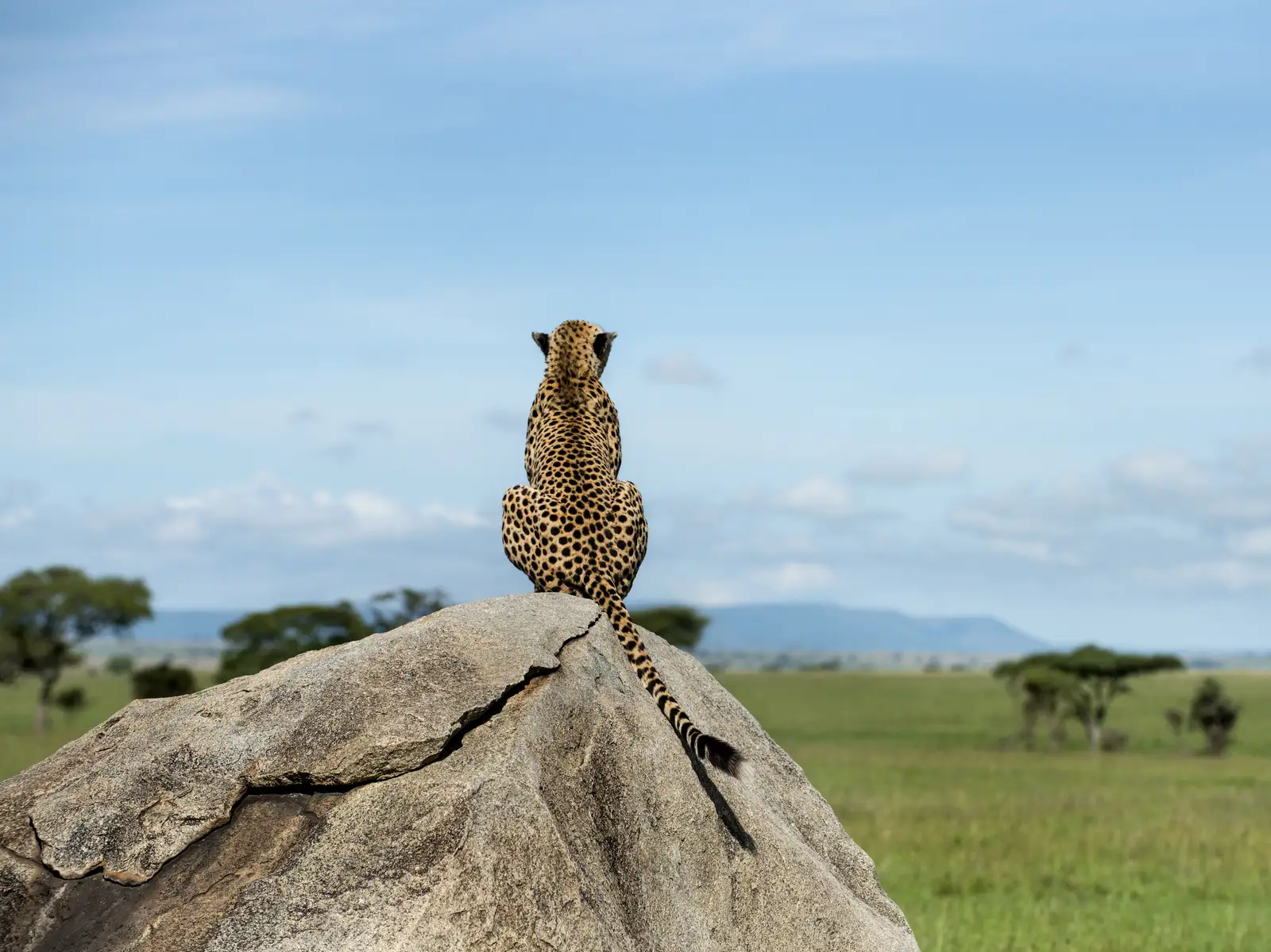
Customer Testimonials

Sep 3, 2024
Knowledgable and responsive
Jayson created a fantastic itinerary within budget and answered questions promptly. Super helpful. I can't wait to get going!
Sep 2, 2024
Although we didn’t end up booking…
Although we didn’t end up booking through Safari.com the service we received was great and they were really helpful.
Trip to Kruger at Mdluli Safari Lodge
I loved working with Anja from safari.com. She put together my itinerary within my price range and was very professional, thorough and empathetic. She followed up with me many times to see if I needed anything throughout my trip and even filled out some forms for me when I was having difficulty. When the lodge I stayed at was not being accommodating in the slightest, she quickly contacted the manager and got them to rearrange their services to meet my needs. I would most certainly use safari.com again due to my wonderful experience working with Anja.
Aug 31, 2024
Nicole at Safari.com is AMAZING!!!
I would love to share my experience with Nicole. She has worked tirelessly to help me make my dream vacation a reality. I had no idea how to start planning. Nicole suggested the most wonderful South African resorts and safaris. No matter how many changes I threw her way it was always received with a happy, positive attitude. I live in Hawaii and even though we were on a 12 hour time difference she was always available to answer any questions or concerns. Her expertise, knowledge and patience are unmeasurable. I was plagued with numerous payment issues from my bank in Hawaii. Nicole never wavered from being patience and more importantly positive that we could resolve each issue and get my trip booked. Nicole is a huge asset to Safari.com and I will scream it from the mountains to let everyone know what excellent customer service I have received. Nicole is a ROCKSTAR!!! We are so excited for our upcoming adventure of a lifetime!
Aug 30, 2024
Dolan made our first Safari experience awesome!
Dolan was exceptional, extremely knowledgeable, and easy to work with in our first Safari experience. He made sure he was available, took time to answer all our questions and understood our requests and concerns. We have already recommended Dolan to some friends and will be contacting him again in future!
Leigh-Ann super star ⭐️
I am so pleased to share my experience with Leigh-Ann, who assisted with our safari and South Africa travel arrangements. From start to finish, Leigh-Ann went above and beyond. Her attention to detail and smooth communication made the planning process effortless. No request was too big or too small, and she handled everything with efficiency. Leigh-Ann exceeded all expectations, making our trip both stress-free and enjoyable. Her exceptional service reflects her professionalism. I highly recommend her for anyone seeking top-notch travel support. Thanks so much Leigh-Ann :)
Aug 27, 2024
Very good experience with getting quotes
I didn’t end up booking with safari.com but I did have a great experience with their consultant, Leigh-Ann Croeser. I originally wanted to book a safari at a specific lodge but it was not available for the dates we wanted. She offered suggestions and helped us secure holds on other dates. She worked hard and sent several follow up emails as she was able to hold some dates for available rooms at the original lodge! We did end up booking with another safari tour company as I sent out a few quotes at the same time and that worked out better for us but next time I would definitely consider booking with her again!
Easy,reliable
I do all my bookings through…
I do all my bookings through safari.com. Fast feedback. I changed my booking twice and was assisted in 12 hours after my email. Great service
TOP DESTINATIONS
- Kruger Park
- Okavango Delta
Serengeti National Park
- Victoria Falls
TOP COUNTRIES
- South Africa
TRAVEL DEALS
View All Travel Deals
SOUTHERN AFRICA
East africa, indian ocean islands, top experiences.
- Beach Holidays
- Family Safaris
- Honeymoon Safaris
- Desert Safaris
- Luxury Rail Safaris
- Multi-Generational Safaris
- Positive Impact Safaris
Photographic Safaris
Walking Safaris
WILDLIFE SAFARI
Big Five Safaris
Birding Safaris
- Gorilla Trekking Safaris
Migration Safaris
- Mobile Camping Safaris
- Horseback Safaris
FEATURED EXPERIENCES
Comfort levels, property types.
- Tented Camps
- Boutique Hotels
Featured Safari Collections
- African Bush Camps
- Extraordinary
- Green Safaris
GET TO KNOW US
- Meet The Team
- Pricing Explained
- Traveller Reviews
- Traveller Stories
- Why Book With Us?
- HerdTracker
- Safari Cost Calculator
- South Africa In 360
- Trusted Safari Partners
- Newsletter Sign Up
What are you looking for?
- Multi-generational Safaris
- Positive Impact
- Meet the team
- Why book with us?
- Herdtracker
- Safari Cost Estimator
Hello traveller!
It's in Cape Town now.
We're sorry. Our safari planners aren't available now. Our office hours are 08:00 - 19:00 (GMT+2).
Call us to speak to an experienced safari planner.
Alternatively, we recommend...
Schedule a phone or Zoom call with one of our safari planners
Complete our travel enquiry form to connect with a safari planner
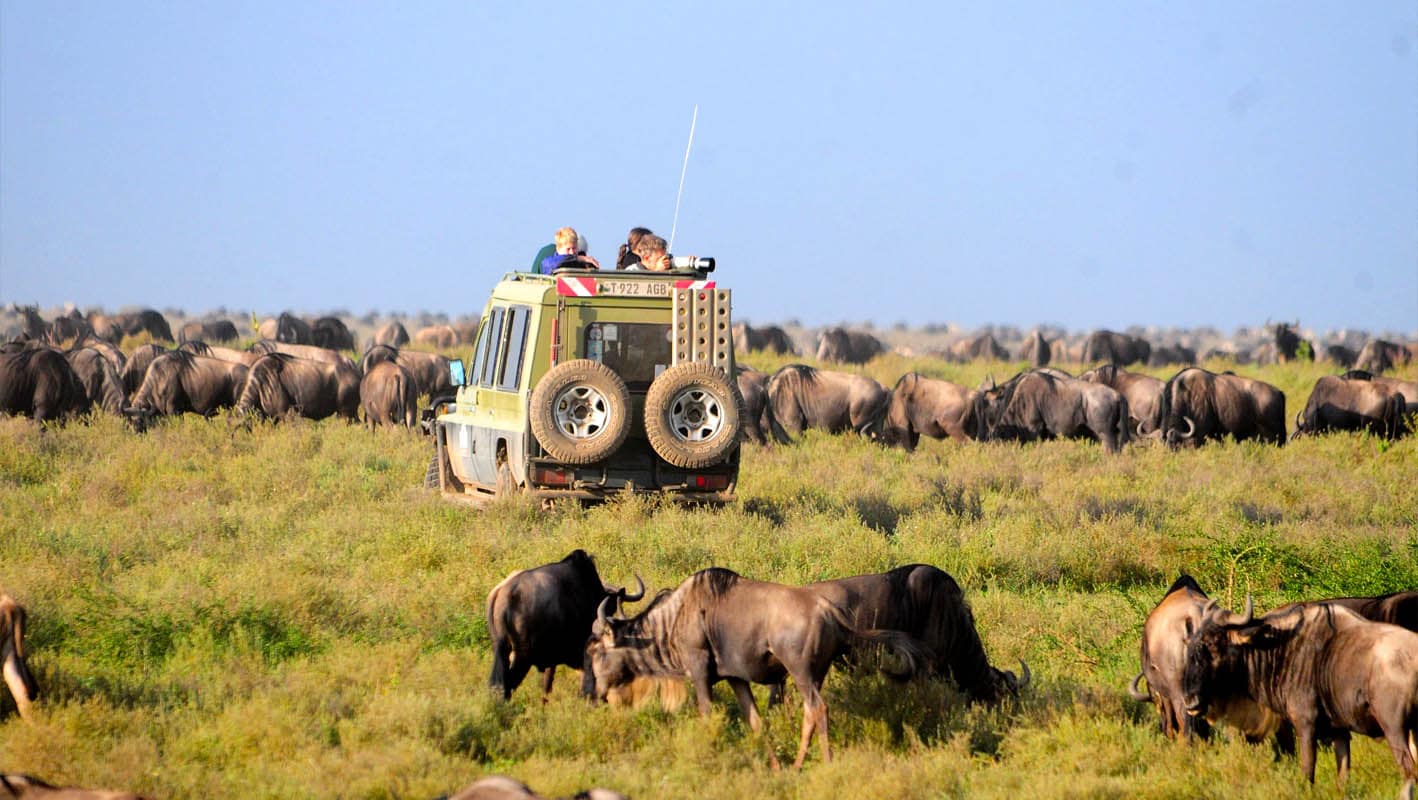
- Serengeti National Park Safari
The ultimate guide to your next Serengeti National Park Safari
- Serengeti National Park Gallery
- Where to go
- Experiences
- Travel Advice
Get to Know Serengeti National Park

By Lana Goodwin
Safari Travel Planner
Date Published: 2 January 2014
Embarking on a Serengeti National Park safari is a journey into Tanzania’s wildlife paradise, where vast plains stretch endlessly under the African sun. This iconic park, synonymous with the Great Migration, offers visitors a chance to witness one of nature’s most awe-inspiring spectacles. Millions of wildebeest, zebras, and gazelles traverse the Serengeti’s diverse ecosystems in search of greener pastures, pursued by formidable predators. This annual migration is just one highlight of the Serengeti’s rich tapestry of life.
Home to the renowned Big Five—lions, leopards, elephants, buffalo, and rhinos—the Serengeti is a sanctuary of stunning landscapes. From the grassy savannahs of the Seronera Valley, teeming with life, to the remote wilderness of the Northern Serengeti, each area offers unique safari experiences. Visitors can explore the park on game drives, walking safaris, or even hot-air balloon rides, each providing breathtaking views of the untamed wilderness.
Serengeti National Park Video
How it Works
View our recommended safaris for inspiration and get ready to plan your dream safari
Contact us or fill out an enquiry form and one of our travel experts will help you tailor make your perfect safari
Enjoy an authentic African experience.
Why Visit Serengeti National Park?
Wildlife encounters.
The Great Migration: Witness one of the world’s most extraordinary wildlife spectacles, where over 1.5 million wildebeest, 200,000 zebras, and 300,000 gazelles traverse the plains in search of greener pastures. This awe-inspiring event is a must-see for any wildlife enthusiast.
Big Five Sightings: The Serengeti is renowned for offering excellent opportunities to see the Big Five—lions, leopards, elephants, rhinos, and buffalos. The vast plains and diverse habitats support a thriving population of these iconic animals.
Diverse Species: Beyond the Big Five, the park is home to cheetahs, hippos, crocodiles, over 500 bird species, and various antelope species. The Serengeti’s biodiversity is one of its greatest treasures.
Scenic Beauty
Stunning Landscapes: The Serengeti’s landscapes range from open savannahs and acacia-dotted plains to rocky kopjes and lush riverine forests. These diverse ecosystems offer breathtaking vistas and unique habitats for wildlife.
Rivers and Waterholes: The park’s network of rivers and waterholes provides essential lifelines for wildlife, creating prime viewing spots, especially during the dry season. Notable rivers include the Mara and Grumeti, which are key during the migration.
Cultural Richness
Maasai Culture: Engage with the Maasai communities around the Serengeti who share their traditions, crafts, and stories, enriching your safari experience. Visiting a Maasai village offers a cultural dimension to your adventure.
Historical Sites: Explore the ancient rock art and archaeological sites within and around the park, offering insights into the region’s rich cultural history and early human inhabitants.
Luxury and Comfort
Exclusive Lodges and Camps: Stay in luxurious safari lodges and tented camps that provide comfort, exceptional service, and immersive wildlife experiences. Options range from mobile camps that follow the migration to permanent lodges with stunning views.
Gourmet Dining: Enjoy gourmet cuisine, blending local Tanzanian flavors with international culinary standards, prepared by skilled chefs. Dining in the bush under the stars is a highlight of any Serengeti safari.
Adventure and Activities
Game Drives: Experience thrilling game drives led by expert guides who help you track and spot wildlife. Both day and night drives offer unique opportunities to observe different animal behaviors.
Walking Safaris: Discover the park’s hidden wonders on foot with guided walking safaris, offering a closer connection to nature and a chance to learn about the smaller details of the ecosystem.
Hot Air Balloon Safaris: Float above the plains at dawn, offering a unique perspective of the wildlife and landscapes below. This serene and exhilarating experience is a must-do in the Serengeti.
Photography Opportunities: Capture stunning wildlife moments and scenic landscapes, perfect for photographers of all levels. The Serengeti’s diverse settings provide endless photographic inspiration.
Accessibility and Infrastructure
Well-Developed Infrastructure: The Serengeti is accessible via multiple entry points and airstrips, making it easy to reach from major cities like Arusha and Nairobi. Well-maintained roads and facilities enhance the safari experience.
Tourism Services: Benefit from a wide range of tourism services, including guided tours, transport options, and hospitality services, ensuring a smooth and enjoyable safari experience.
Responsible Tourism
Conservation Efforts: Your visit supports vital conservation initiatives aimed at protecting the Serengeti’s diverse ecosystems and wildlife. The park is a crucial part of the larger Serengeti-Mara ecosystem, a UNESCO World Heritage site.
Community Support: Engage in responsible tourism practices that benefit local communities, fostering sustainable development and preserving the cultural heritage of the Maasai people.
Where to go in Serengeti
The Serengeti National Park is a vast and diverse area divided into distinct regions, each offering unique safari experiences. From the bustling Central Serengeti to the remote and beautiful Eastern Serengeti, and the dramatic river crossings of the Northern Serengeti, every part of the park has something special. Whether you seek the thrilling Great Migration or quieter moments with nature, the Serengeti provides a rich tapestry of experiences waiting to be explored.
- Central Serengeti & Seronera Valley
- Eastern Serengeti
- Ndutu Region
- Northern Serengeti
- Southern Serengeti
- Western Corridor and Grumeti
- Where to Go on a Safari in Serengeti National Park
The Central Serengeti, lying at the heart of this spectacular national park, is the most popular region in the reserve for its abundant wildlife, large numbers of big cats and quintessential Serengeti landscapes of acacia-studded savanna. Resident wildlife makes this part of the Serengeti a fantastic year-round destination, but the months of April to June and October to December, when the herds of the Great Migration pass through the area, are when it’s at its peak.
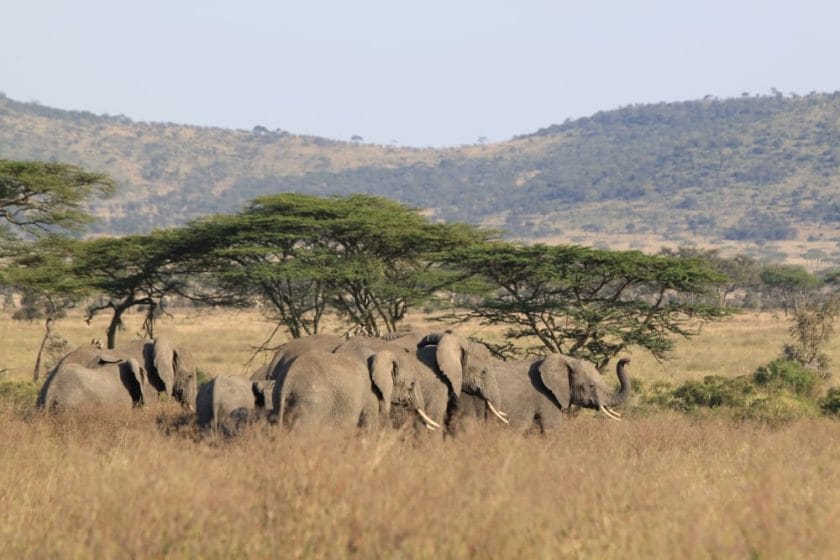
The Seronera River Valley, located in the south-central region of the park, is one of the most popular areas in the entire reserve. Known as the Big Cat Capital of Africa, the Seronera is rich in lion, leopard and cheetah – and people often spot all three in one day of game drives. Look for leopard around the Seronera River, which is home to one of Africa’s densest populations of the big cats, while lions can often be seen on the kopjes (rocky outcrops). The Serengeti Plains – the open savanna south of the Seronera River – are prime cheetah territory. Other animals to spot in the area’s varied habitats of rivers, swamps, kopjes and grasslands include elephant, hippos and crocodiles in the rivers, buffaloes, impala, topi, jackals and bat-eared foxes.
While the year-round supply of water from the Seronera River means that the area is excellent for wildlife spotting throughout the year, April to June is the peak season for game viewing in the Seronera, as this is when the plains are full of migrating wildebeest, zebra and gazelle as they’re making their way up north. The central location of the Seronera means that it’s one of the best places to see the Great Migration in action, as the animals are moving through the area for months.
The Central Serengeti is a fantastic area to see the Great Migration in action: the herds move through this section of the park from April to June as they travel northwards, and then they come back again heading south from October to December. Some of the best locations in the Central Serengeti to see the herds include the Seronera Valley and Seronera River, Moru Kopjes, Simba Kopje and Maasai Kopjes.
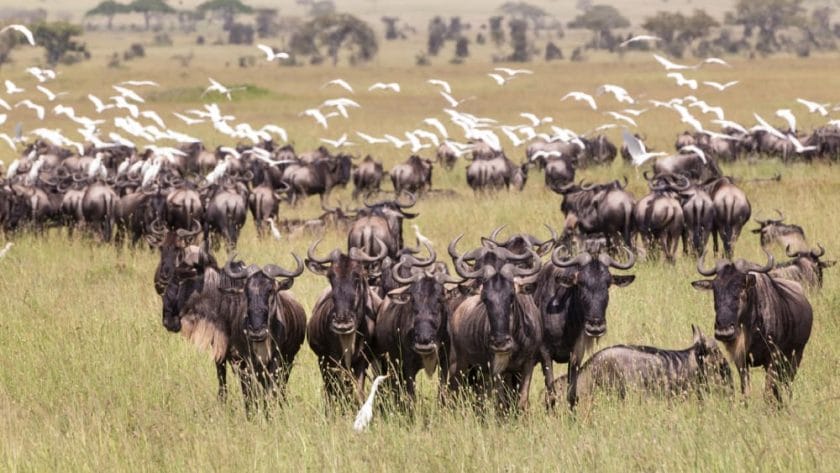
If you’re after Big Cats, the Seronera area in the Central Serengeti is your best bet: this region is hailed as the best place to see predators – particularly lion, leopard and cheetah – on thrilling hunts.
The Central Serengeti is studded with many rocky granite outcrops, known as kopjes, which are where you should look out for lions and cheetahs. There are also some particular kopje highlights, such the Simba Kopje, or Simba Rocks – the place that inspired Pride Rock in the Disney film The Lion King. The film link is not the only reason to visit this pile of granite boulders however – it’s great spot to see lions, which are often lying on the rocks under the sun. At Moru Kopjes, south of the Seronera River, you can try and search for some of the last remaining black rhinos in the entire reserve – as well as see some old rock art paintings. Then there’s a visitor’s centre for the Serengeti Rhino Project, where you can learn about the important rhino conservation work that’s being done to protect this highly endangered species. Moru Kopjes is also one of the very few areas of the park where you can do multi-day walking safaris.
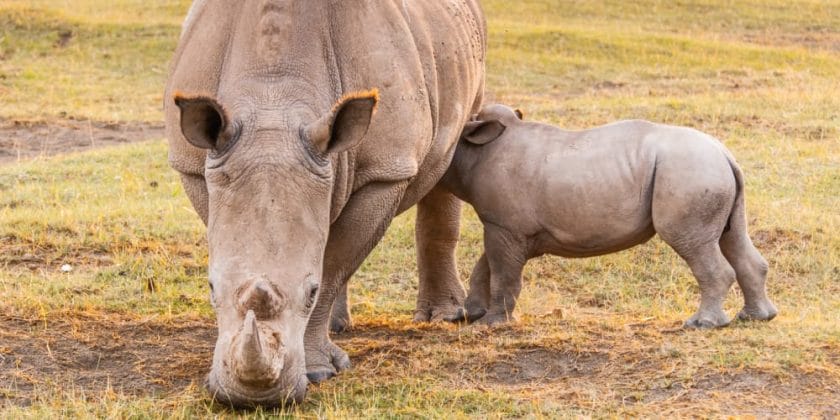
Hot air ballooning is a must-do when you’re visiting the Serengeti. Floating gently above the grassy plains in the golden light of dawn, spotting animals from your suspended basket is an experience you’ll never forget. If you’re staying in the Central Serengeti, you can get a transfer to and from your lodge or camp to the hot air ballooning launch site near the Masai Kopjes. A champagne breakfast once you land is the cherry on top of an amazing activity.
Many lodges and camps offer a visit to a Maasai village so that you can learn more about the famous semi-nomadic pastoralist tribe who have long lived in the area that is now the Serengeti and the Masai Mara national parks. At the Maasai village you’ll be treated to members of the village singing and dancing, with the male warriors doing a traditional jumping dance. You’ll also be able to buy beautiful jewellery and handmade crafts, which make great souvenirs – and also support the local economy.
Travel Tips
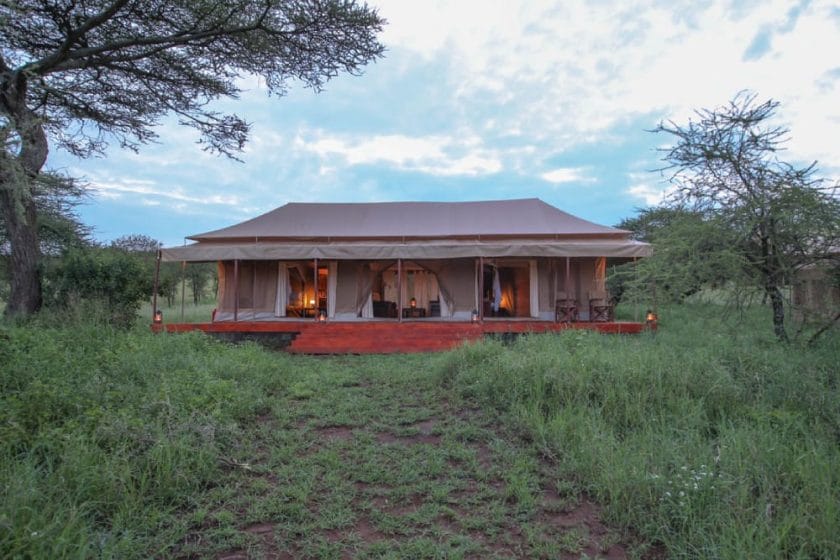
The Seronera region, as the most popular area of the park, has a wealth of lodging options ranging from budget-friendly through to mid-range and up to all-out luxury, with some of the park’s best high-end properties. Budget travellers can camp under the stars at the rustic Seronera Campsite, while travellers looking for mid-range options will find affordable lodges and camps – many of which are family friendly and offer the full range of amenities such as WiFi. You’re spoiled for choice when it comes to luxury camps: there are mobile camps which move with the Great Migration herds (and don’t scrimp on comfort, with proper beds, hot bucket showers and private butlers), beautifully designed lodges with private infinity pools and activities such as guided meditation sessions in the bush, bush picnics and stargazing.
The park headquarters are also based in Seronera (close to the airstrip), where there’s a visitor information centre, a curio shop and a café.
The Seronera gets particularly busy during the most popular months of June and July and October to April and sightings can be overpopulated. If escaping the crowds is your priority and you’re travelling in these months, consider booking your lodging in another part of the park.
Seronera is accessible by road on a six-hour drive from both Arusha and Mwanza, but the easiest option to access this part of the park is to fly into the Seronera airstrip and stay at a lodge that caters for fly-in travellers: they’ll come and pick you up from the airstrip and provide game drives in their vehicles.
Some of the lodges and camps offer short walks in the bush of two to four hours with Maasai guides, who’ll teach you about the smaller creatures and the plants that you miss on game drives. If walking is something you’d like to experience, do some research on lodges that offer this activity.
The Eastern Serengeti is one of the most beautiful regions of the park: mountains, valleys and sweeping grassy plains with are lush in the green season dotted with granite outcrops and sliced through by meandering rivers. It’s one of the more remote regions of the park, which makes it perfect for adventurous travellers who prefer their safaris off the beaten track.
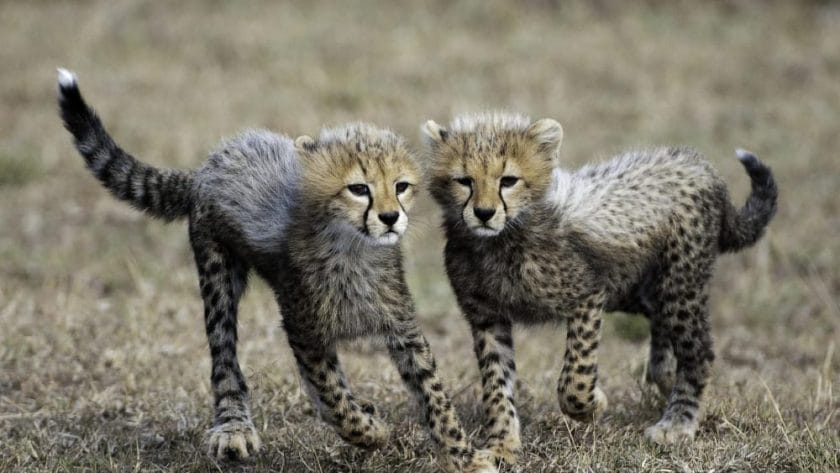
The region can be visited year-round for wildlife sightings, but November to February are the best months to see the Great Migration herds passing through towards the Southern Serengeti. The green season of December to May sees the plains become lush and verdant, which attracts abundant game. Home to the biggest concentration of cheetah on the continent, the Gol Kopjes is the most famous landmark in the Eastern Serengeti, while the area is also known for its lion and leopard sightings.
Under two hours’ drive from the Central Serengeti, the Soit Le Motonyi region, which opened in 2014 after being closed for two decades for cheetah conservation, is drawing visitors for its pristine, totally undeveloped landscapes of grassy plains and acacia woodlands, completely secluded camps – and for cheetah.
Spotting cheetah is a big highlight of a safari to the Eastern Serengeti, and the prime area is Gol Kopjes. Known as the world’s largest Japanese rock garden, the Gol Kopjes – huge granite rock formations – are home to the highest concentration of cheetah on the continent, and offer some of the best game viewing opportunities in the Serengeti during the rainy season from January to June, when the Great Migration herds are passing through the area.
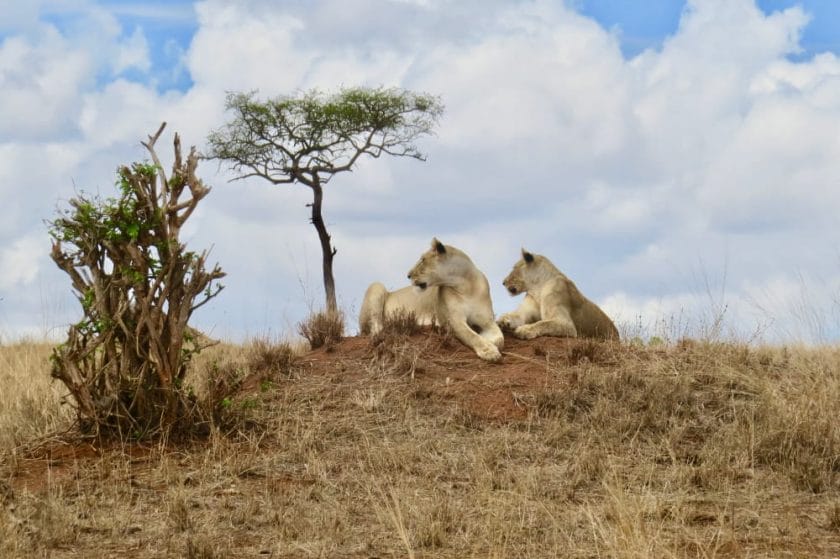
To experience rugged wilderness with very few other visitors, the newly re-opened Soit Le Motonyi region, where short grassy plains meet acacia woodlands, is one of the most remote and least developed corners of the Serengeti. The area was inaccessible to the public for twenty years for cheetah conservation, and now it’s the best place in the Serengeti to see a huge concentration of cheetah undisturbed by other cars and tourists. The Great Migration herds pass the area between November and April (with the “long rains” period of March to May attracting a huge number of feasting hyena), and leopard and lion can be spotted on the rocky outcrops, while there’s other wildlife to spot year-round thanks to a permanent water supply. There are only two camps in the Soit Le Motonyi area, and activity highlights include walking safaris and spending time with a cheetah researcher learning about conservation strategies and helping to collate data on cheetahs that you spot.
If you’re staying in the Eastern Serengeti, consider making a side trip outside of the park to visit Lake Natron, a brightly hued lake with a pinkish crust that attracts millions of flamingos between June and November. You can swim in the lake, and explore the surrounding scenery, which is remarkable – think volcanic craters, waterfalls and gorges. Close by to the southern end of the lake, the active volcano Ol Doinyo Lengai (“Mountain of God” in Maasai) looms over the Rift Valley. Adventurous travellers who are up for a bit of a challenge can tackle the 2962-metre ascent of Ol Doinyo Legai over three days.
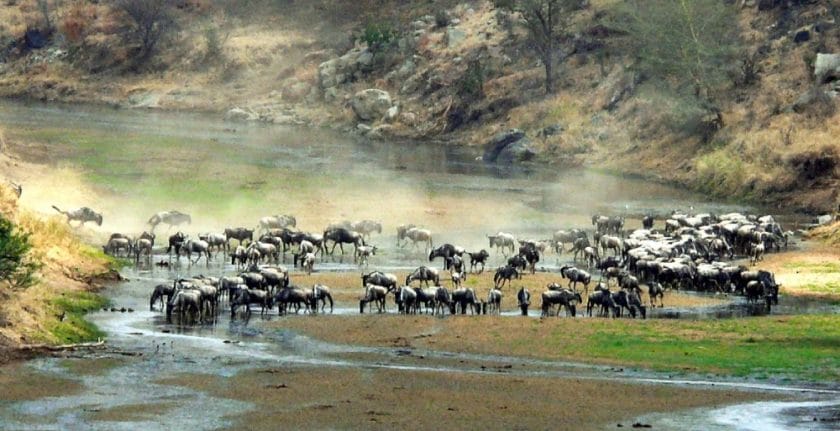
There’s a limited amount of lodging in the Eastern Serengeti, which is perfect if you like seclusion and privacy, but it does mean that you need to book far in advance.
If you’re staying at a camp in the Soit Le Motonyi region, then the closest airstrip is Seronera, which is around one and a half hours’ drive away. Note that there are only two camps in Soit Le Motonyi, so you’ll need to book in advance for the high seasons of December to February and June to October.
The Ndutu Region forms part of the northern section of Ngorongoro Conservation Area and stretches to the unfenced southern reaches of the Serengeti National Park, a meeting point between these two incredible wilderness areas. This section of the park is made up of rolling grasslands peppered with alkaline lakes that attract flocks of flamingos, as well as acacia woodlands.
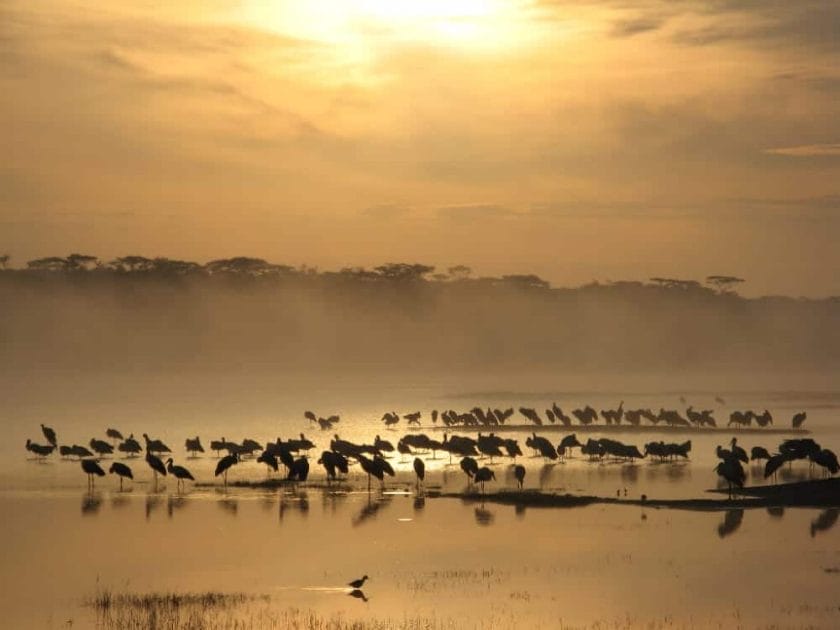
There’s year-round resident wildlife (such as giraffe, elephant, hyena and various antelope species) in the Ndutu Region, and you can spot animals around the waterholes during the dry season from June to November. Look out for the six cat species – lion, cheetah, leopard, serval, African wild cat and caracal – that are present throughout the year.
The best months to visit the Ndutu Region are from December, when the Great Migration herds start to arrive from the north, until April when the millions of wildebeest, zebra and gazelle have trekked northwards again. In the early months of the year – with a peak in February – the wildebeest herds are calving on the verdant grassy plains: thousands upon thousands of baby animals are born every day, attracting the attention of cheetah, lion and hyena.
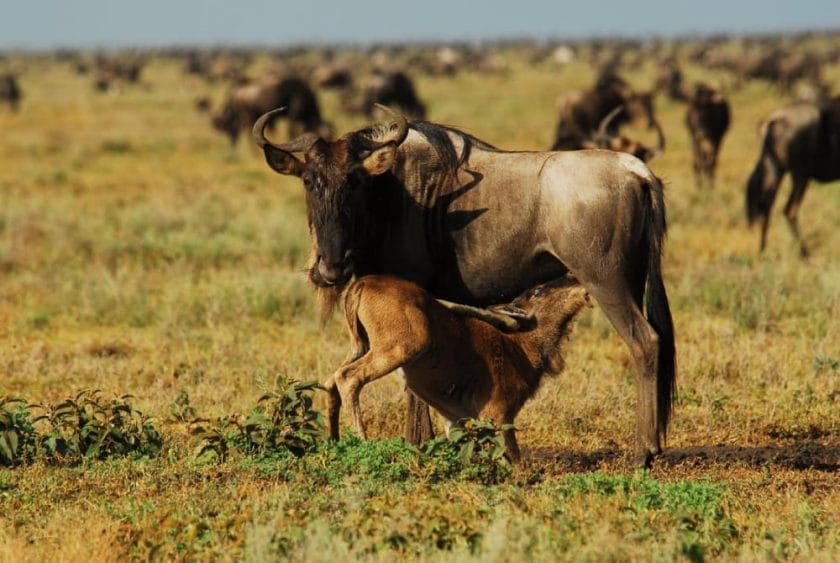
A big draw of the Ndutu Region is to see the full circle of the Great Migration, from the return of the herds to graze in December, and then the calving which takes place in January and February, and then the departure of the herds again in April as they start making their journey northwards. Calving season is particularly dramatic: a million wildebeest give birth to 8000 babies every day, and as these newborns take their first steps, they’re targeted by lion, leopard, cheetah and hyena.
The prime game viewing spot in the Ndutu Region is around Lake Ndutu, where enormous herds congregate between December and April to graze and calve. The forests and granite kopjes around Lake Ndutu are also home to lots of game outside of the migration months.
Sightings of six species of cats – leopard, lion, cheetah, caracal, African wildcat and serval – are a big highlight of visiting the Ndutu Region. You can spot the cats throughout the year, but the best viewing is during the calving months of January and February, when these predators pick on the fledgling baby animals.
A trip to Ndutu is not just about wildlife and landscapes – there’s incredible cultural heritage to explore too. Lying within the Ndutu Region, Olduvai Gorge (also known as Oldupai – the correct Maasai spelling of the word) is one of the world’s most significant paleoanthropological sites, thanks to the discovery of the earliest evidence of the existence of our human ancestors. Visit the dramatic ravine and spend some time in the museum to learn about the fascinating excavations and discoveries that have taken place here. A visit to Olduvai Gorge should be combined with a stop at the nearby Shifting Sands: mysterious and beautiful dunes formed of volcanic ash that move with the winds.
For adventurous travellers, you can do multi-day walking safaris starting in the Ndutu Region and heading into the highlands of the Ngorongoro Conservation Area, and for the very intrepid, you can combine the walking safari with an ascent up the active volcano of Ol Doinyo Lengai.
Day trips to the Ngorongoro Crater are a highlight of staying in the Ndutu Region. The remains of a massive volcano, the Ngorongoro is one of the most superb wilderness areas on the continent, and boasts some of the greatest populations of animals – particularly predators – found in Africa.
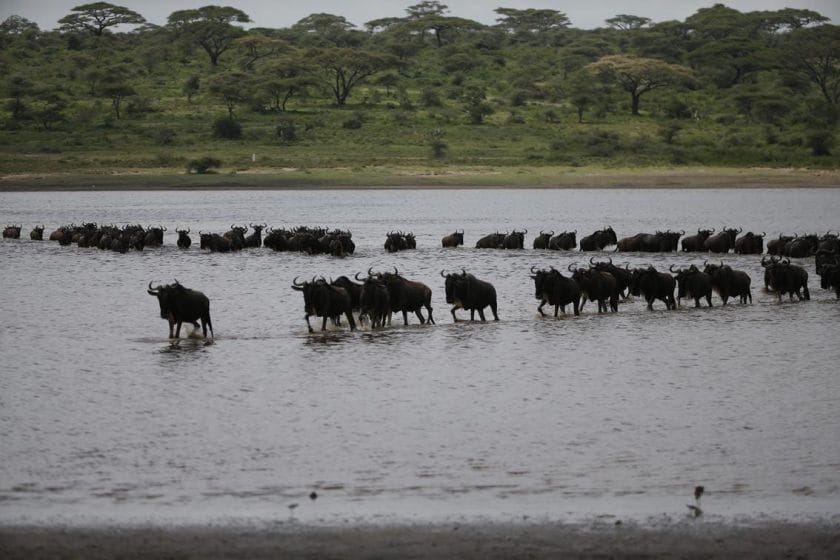
With no public campsites, Ndutu isn’t the best region for budget travellers. Your best budget-friendly option would be to stay at one of the mid-range mobile tented camps that operate in the area.
As with most areas of the Serengeti, camps and lodges are mainly in the upmarket range. Due to the seasonal nature of wildlife, lodges tend to only open for the peak season from November to March.
Camps and lodges in the Ndutu Region can either be located in the Ngorongoro Conservation Area or in the Serengeti National Park, so keep in mind that you’ll need to pay park fees for each park if you’re staying in one park and doing game drives in the other.
You can reach the Ndutu region by road from Arusha, which is around six hours’ drive away through the Ngorongoro Conservation Area. A quicker way to reach your lodge if you’re not self-driving is by air: the Ndutu Region is served by several airstrips, and it’s a quick flight from Arusha.
The Northern Serengeti offers a chance to escape the crowds: this region of the park – wedged between the Central Serengeti and Kenya’s Masai Mara National Reserve to the north – is remote and relatively inaccessible, which means it sees fewer visitors. Travellers who make it to this corner of the Serengeti will be rewarded with gorgeous landscapes of green rolling hills, granite outcrops and acacia woodlands dotting open savanna, incredible wildlife, and most importantly, with massive herds of wildebeest and zebra making dangerous crossing of the croc-infested Mara River during the Great Migration in June and July and again in September, October and November. This sector of the park is also home to the greatest concentration of elephant in the Serengeti, as well as good numbers of lion, leopard, cheetah and hyena and diverse resident animals such as giraffe, topi, eland and hippo.
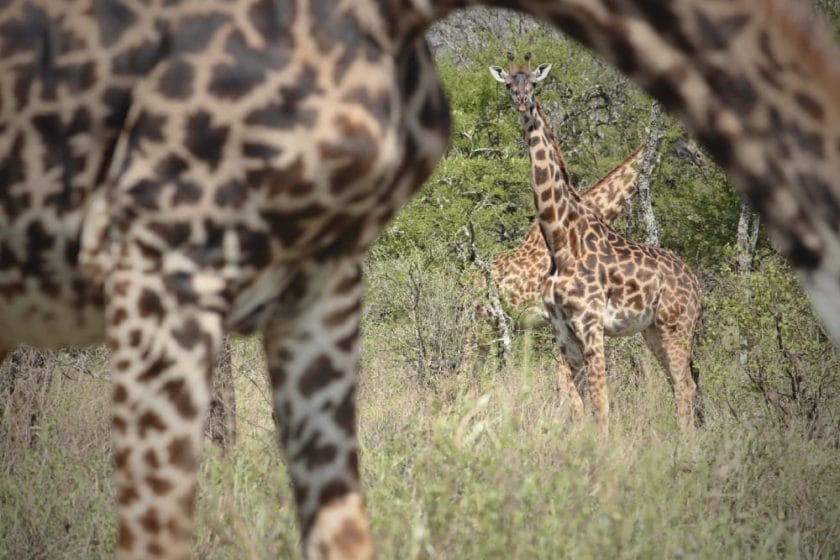
Lying in the park’s north eastern corner, the remote Lobo Valley is a particularly beautiful part of the park, encompassing open plains, rolling hills, dramatic kopjes and woodlands. It’s known for large elephant herds and the second largest lion pride in the Serengeti, and it’s not unusual to spot lion, leopard and cheetah on one game drive. The Lobo Valley is also home to year-round resident game such as giraffe, hartebeest, topi and buffalo, while the herds of the Great Migration pass through the valley in July and August moving north, and then return on their southwards journey between September and November.
Outside of the park’s boundaries to the east and bordering Kenya’s Masai Mara National Reserve and the Ngorongoro Conservation Area, the Maasai-owned Loliondo Game Controlled Area is nearly a third of the size of the Serengeti itself. This private concession is an important wildlife corridor and the herds of the Great Migration pass through here on their southwards march from Kenya in November and December. The benefit of staying in lodges in the Loliondo is seeing all of the wildlife of the Serengeti but with the activities that are not permitted in the national park: night drives and off-road driving. Lodges also offer walking safaris and cultural activities with the Maasai.
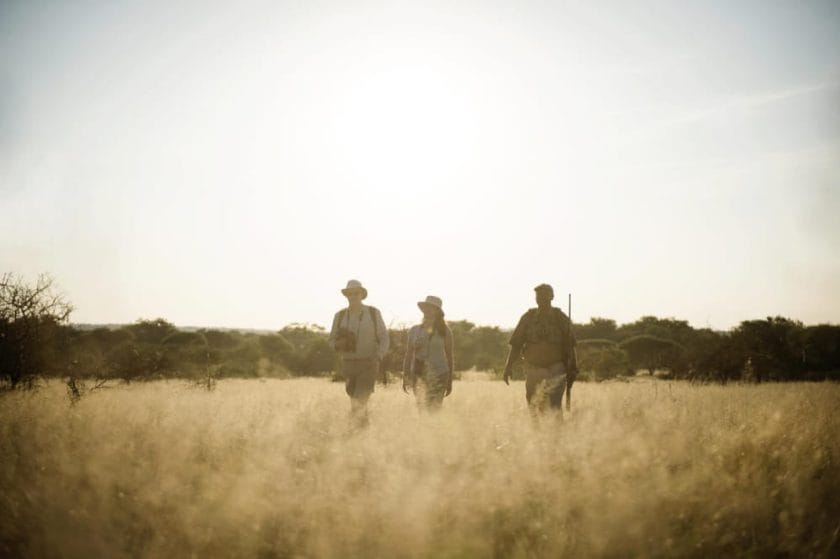
The Mara River, which courses its way through the Northern Serengeti and then into Lake Victoria to the west, is undoubtedly the highlight of this remote region of the Serengeti. The river is home to giant pods of hippos and attracts an abundance of game, from giraffe and elephant to leopard and lion. Between July and September, the Mara River becomes the site of thousands upon thousands of wildebeest and zebra battling currents and huge Nile crocodiles to reach the opposite bank, where they make their way north into the Masai Mara in neighbouring Kenya. These thrilling river crossings are a big highlight of seeing the Great Migration in action, and while across the border in Kenya these sightings can become crowded with game drive vehicles, there are far fewer tourists on the Serengeti side of the river.
Walking safaris are a recent addition in the Serengeti, and there aren’t many places in the park where they are offered. One location is from Kogatende, near the Mara River. On a multi-day adventure, you’ll just carry a day pack, staying at temporary camps with comfortable beds and delicious meals prepared for you by camp staff. Walking in the wilderness is the ultimate way to experience the Serengeti’s wildlife and scenery, and going camping in the bush and sleeping under the stars definitely takes the usual safari experience up several notches.
Go hot air ballooning one morning during your safari in the Northern Serengeti to be treated to sunrise views over the plains and 360-degree wildlife spotting from the air. The magical dawn flight ends with a lavish champagne breakfast when you land on the plains.
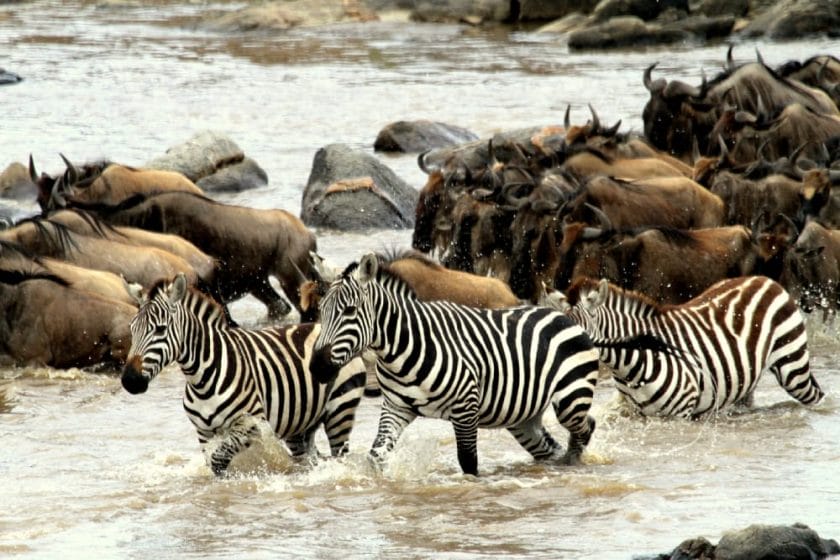
The best months to visit the Northern Serengeti are June until October, while for Mara River crossings the peak months are from July to September.
Lodging options are limited in the Northern Serengeti, as there is only a handful of permanent lodges in the area. During the peak months of the Migration, from July to October, mobile camps move into the area to provide the perfectly located places to stay to catch the exciting Mara River crossings. There are a few mobile camps and lodges in the Loliondo Game Controlled Area on their own private concessions. Lodging is largely in the high-end category, but there is one option for budget travellers – the Lobo Campsite – which is the only public campsite in the north.
If you need to head south through the park after a stay in the north, a scenic – and adventurous off-the-beaten track – alternative to driving through the park is to head out of Klein’s Gate, drive through the Loliondo Game Controlled Area to the beautiful flamingo-dusted Lake Natron, the looming volcano of Ol Doinyo Lengai and the Crater Highlands, before entering the park again.
Grassy plains studded with granite kopjes extend endlessly across the scenically beautiful Southern Serengeti, which stretches from the bottom of the Central Serengeti to the Ngorongoro Conservation Area and Maswa Game Reserve. It’s one of the best areas to see the animals of the Great Migration: visit between December and May to see the huge herds of wildebeest, zebra and gazelle arriving to calve, and then at the beginning of the dry season making their way northwards again in search of green grass. February is a particularly good month to visit the Southern Serengeti to see thousands of baby wildebeest taking their first steps on the savanna – and being targeted by hungry lion, cheetah and hyena, which are in abundance in the region.
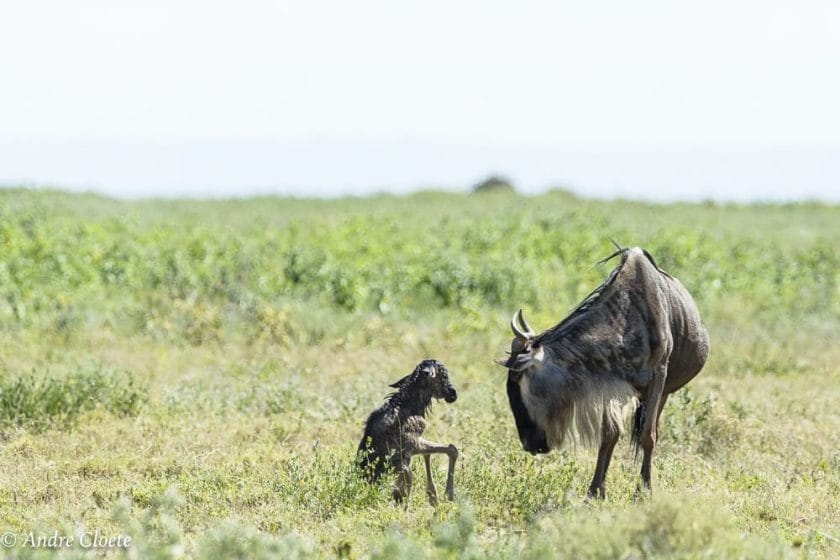
The Southern Serengeti is a seasonal region, as during the dry season, from May to October, when the plains are parched and there’s not much left to graze, most of the herds have left the area.
Because much of the Southern Serengeti lies outside the national park, lodges and camps permit off-road driving, which is not allowed in the rest of the park.
A safari in the Southern Serengeti is all about seeing the Great Migration in action on daily game drives, whether it’s baby wildebeest being born and taking their first steps on the lush green plains in the early months of the year, or watching the vast herds on the move as they track their course northwards towards the Masai Mara. The Southern Serengeti is one of the places where you can see the full circle of the Great Migration: the herds returning to graze in December with the start of the green season, the birth of the babies in January and February, and the departure of the herds as the grass starts to dry at the end of the rains.
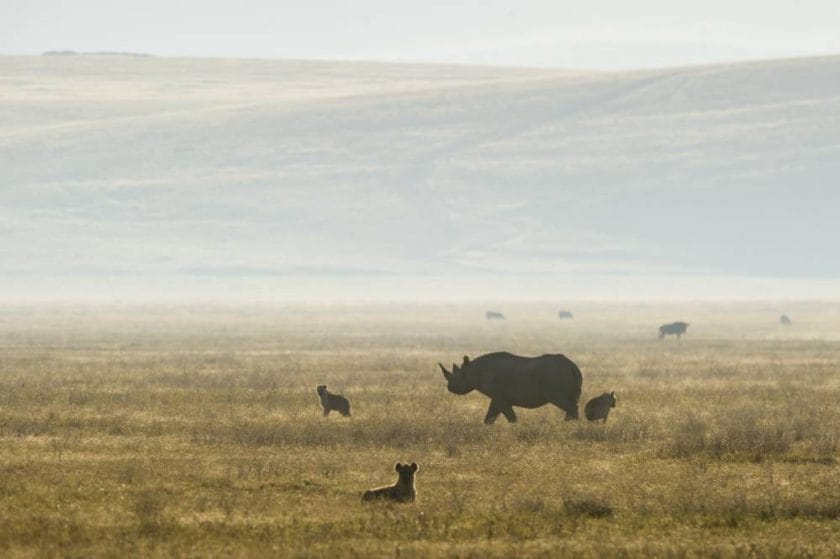
The Southern Serengeti is one of the few places in the Serengeti where you can do walking safaris. Exploring the bush on foot is one of the best ways of immersing yourself in the wilderness, and learning about the smaller creatures that you miss on game drives. And then there’s seeing large game on foot: truly thrilling encounters that make for an exceptional safari experience.
Hot air ballooning is offered in the Southern Serengeti, with a launch site located in the area. A gentle sunrise flight will give you incredible views over the vast plains, and a totally different kind of wildlife spotting. February is an excellent month to do a hot air balloon safari in the Southern Serengeti to see baby wildebeest being born on the savanna.
The Serengeti Cheetah Project, located in the Southern Serengeti, is monitoring cheetah numbers in the hopes of helping to conserve this very vulnerable species. Some camps in the area help the cheetah conservation by asking guests to collaborate in cheetah research by submitting photos and any details about the cheetahs they’ve spotted on game drives.
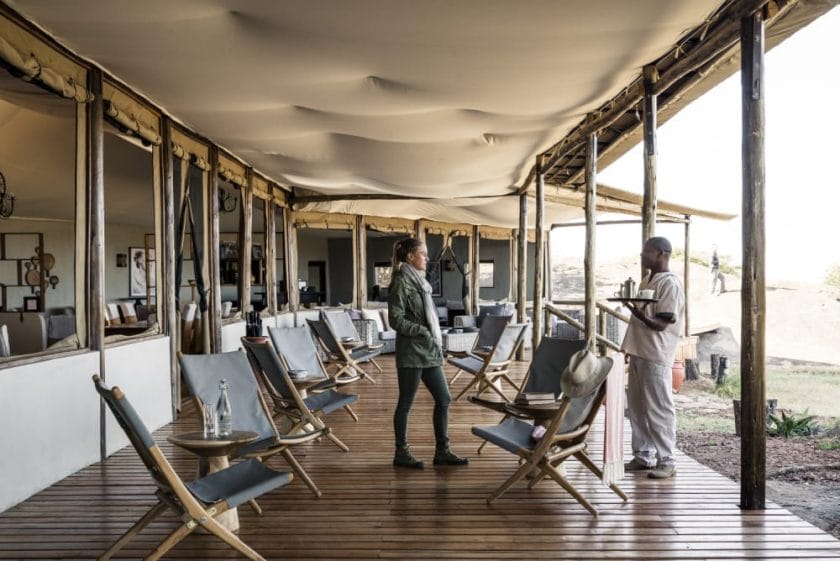
Due the seasonality of game viewing in the Southern Serengeti, there are only a few permanent lodges in the region, as well as one permanent tented camp. There are several mobile camps, ranging from affordable to luxury, that are open during the months of the Great Migration. Other options include lodges situated on private concessions bordering the Southern Serengeti.
Be sure to reserve far in advance for a trip to the Southern Serengeti during the Great Migration months of December to May, as the few lodging options get booked up.
The Southern Serengeti is an excellent area to base yourself in if you’d like to combine your Serengeti safari with a few days in the nearby Ngorongoro Conservation Area.
Stretching across to Lake Victoria, the Western Corridor (or West Serengeti) is a remote, little-visited area of the national park famed for the thrilling river crossings of the Grumeti River during the Great Migration between May and July. A huge valley bordered by hills that ends in Lake Victoria, the Western Corridor is made up of open savanna, woodlands, floodplains and riverine forest which are home to a great diversity of year-round wildlife, including elephant, giraffe, hippo, giant Nile crocodiles, rare Colobus monkeys and the localised kongoni antelope.
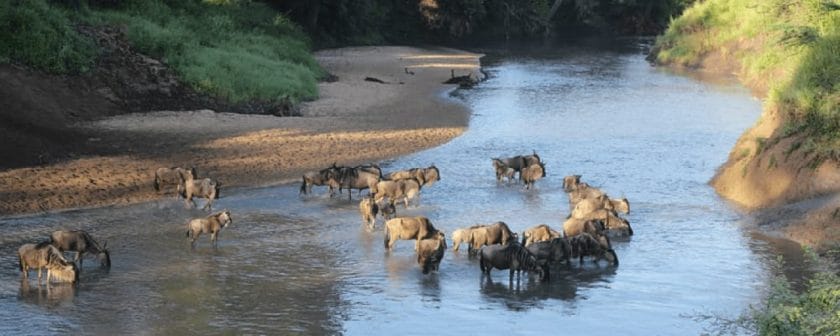
Flanking the Western Corridor is the unfenced Grumeti Game Reserve, a 138 000-hectare private concession which serves as a wildlife corridor for the animals making the migration between the Masai Mara and the Serengeti in June and July. The concession not only offers superb migration sightings with few other vehicles around but also lush, green landscapes of woodlands, rivers and rolling hills, as well as year-round leopard and lion populations.
Seeing the enormous herds of the Great Migration making crossings of the Grumeti in June and July is an excellent reason to visit this part of the Serengeti. While these river crossings are less well known than the Mara River crossings to the north – where the river is more dangerous, wider and has more viewing points – the Grumeti River, which is the first big obstacle for the herds to tackle, still offers some exciting sightings, with the added benefit of fewer tourists at the crossing points.
There are only a few places where you can do walking safaris in the Serengeti, which makes the walking safaris offered in the Grumeti Game Reserve particularly special. Spend hours on foot in the bush with a guide, not only tracking animals and learning about birds and insects, but also discovering fascinating medicinal and cultural uses for indigenous plants.
Visit a local Maasai community to see how people from the tribe live on the edges of the Grumeti Reserve. You’ll get to meet with subsistence farmers and their families and learn about what daily life is like – such as how villagers need to invent non-invasive ways to prevent elephants from trampling their crops.
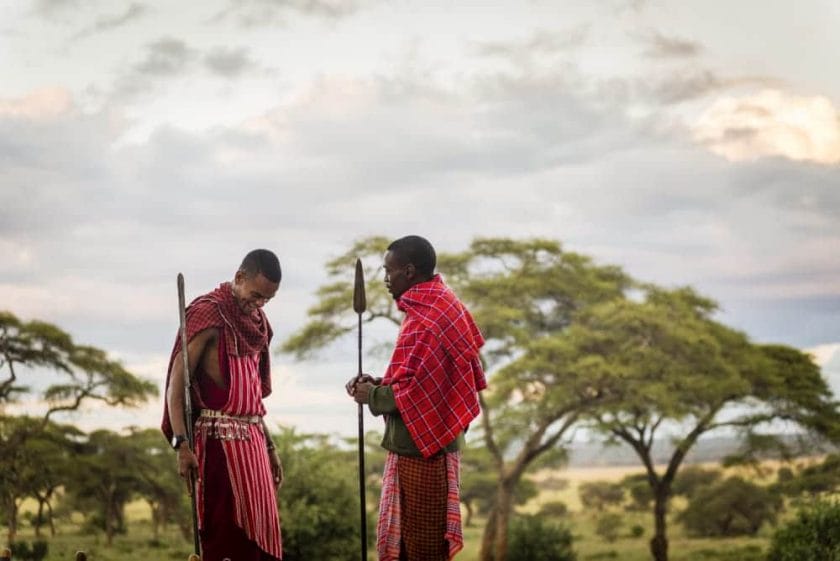
Hot air ballooning is offered seasonally (from the beginning of June to the end of August) in the Western Corridor. A magical sunrise flight in a gently gliding balloon is an unforgettable way to see the Serengeti’s spectacular landscapes and wildlife from a bird’s eye perspective.
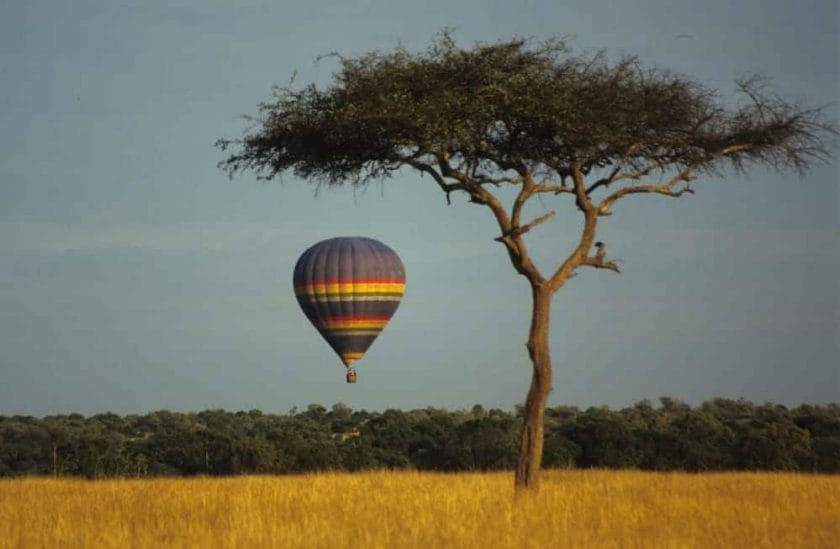
Budget travellers are best off staying in the Central Serengeti, as the Western Corridor and the Grumeti are more geared towards higher end travellers, however there is a campsite located at a lodge near the Ndabaka entrance gate, and a public campsite at the gate itself. Mid-range options in the sector include camps located just outside the park boundaries, while the region is most famous for its superb, intimate luxury lodges and mobile camps – some of which are completely exclusive.
June and July are the most popular times to visit the Western Corridor and the Grumeti to see the Grumeti River crossings and the herds on the move, but September and October are also great months to see the remaining herds of zebra and wildebeest, along with other resident wildlife such as elephant, leopard and lion. If you’re travelling during June and July, you’ll need to reserve lodging far in advance, as there aren’t many places to stay in the region.
Many people choose to fly into their lodge or camp’s private airstrip. Self-drivers hiring a car should pick up their vehicle and supplies from Mwanza, which is just over 130 kilometres from the Ndabaka Gate.
The Serengeti National Park is divided into several distinct regions, each offering unique landscapes and wildlife experiences. Here’s a detailed guide to the key areas within the park and what makes them special:
1. Central Serengeti

Overview: The heart of the Serengeti, known for its abundant wildlife and large populations of big cats. This area is ideal for year-round visits, with peak game viewing during the Great Migration.
Key Highlights:
- Seronera Valley: The central hub of the Serengeti, famous for its resident big cats, including lions, leopards, and cheetahs. This region offers excellent wildlife viewing opportunities throughout the year.
- Retima Hippo Pool: A popular spot to see hippos up close, along with a variety of other wildlife that frequent the area.
Unique Facts:
- The Seronera Valley is often referred to as the “Big Cat Capital” of the Serengeti due to its high density of predators.
- The central Serengeti is a key area for witnessing the Great Migration, particularly during the calving season in the early months of the year.
2. Northern Serengeti

Overview: Less crowded and renowned for the dramatic river crossings of the Great Migration, the Northern Serengeti offers pristine landscapes and abundant wildlife.
- Mara River: Witness the thrilling spectacle of the Great Migration river crossings, where wildebeest and zebras brave the crocodile-infested waters.
- Lobo Valley: Known for its rugged beauty and exceptional wildlife, including large elephant herds and big cats.
- The Northern Serengeti is home to the famous Mara River crossings, a highlight of the Great Migration that occurs between July and October.
- This region offers some of the most remote and untouched safari experiences in the Serengeti.
3. Western Corridor

Overview: Famous for the Grumeti River and its large crocodile populations, the Western Corridor is ideal for visits during the dry season from May to July.
- Grumeti River: See the dramatic river crossings of the Great Migration and the impressive concentration of crocodiles.
- Kirawira: A luxurious safari camp offering stunning views and exceptional wildlife viewing opportunities.
- The Grumeti River area is renowned for its dramatic wildebeest crossings, one of the highlights of the Great Migration.
- The Western Corridor offers a mix of riverine forests, open plains, and woodlands, providing diverse habitats for a variety of wildlife.
4. Southern Serengeti & Ndutu

Overview: Known for the calving season of the Great Migration herds, the Southern Serengeti and Ndutu region are ideal for visiting from December to April.
- Ndutu Region: Witness the incredible calving season, where thousands of wildebeest calves are born, attracting predators and providing dramatic wildlife interactions.
- Lake Ndutu: A hotspot for birdwatching and seeing large herds of animals gathering around the lake.
Unique Facts:
- The Ndutu area is notable for its ancient volcanic soil, which creates nutrient-rich grasslands, sustaining large herbivore populations.
- The Southern Serengeti’s unique topography includes vast plains and rocky outcrops called kopjes, which serve as vantage points for predators like lions and leopards.
5. Eastern Serengeti

Overview: A remote and beautiful region, home to the largest concentration of cheetahs on the continent. Best visited from November to February during the Great Migration.
- Namiri Plains: Known for its stunning scenery and excellent cheetah sightings, this area offers a more secluded and exclusive safari experience.
- Gol Kopjes: Famous for its large prides of lions and panoramic views, ideal for photography and wildlife enthusiasts.
- The Eastern Serengeti is less frequented by tourists, providing a more intimate and off-the-beaten-path safari experience.
- This region is particularly known for its cheetah population, making it a must-visit for big cat enthusiasts.
The Serengeti is expansive, and each region offers special opportunities to see Africa’s incredible wildlife.
Whether you are interested in the dramatic river crossings, predator-rich landscapes, or the serene beauty of the remote plains, there is something for everyone in the Serengeti.
To find out more about each area and plan your perfect safari, visit our detailed guides linked above.
Travel with Confidence
With over 20 years of experience, our team will help you tailor your itinerary to your perfect adventure., 24/7 support, personalised, popular serengeti national park safaris.
Explore the best of the Serengeti’s safari adventures with our curated selection of popular tours. Luxury lodges, thrilling game drives, or immersive walking safaris form part of our range of experiences—offering something for every traveler. Discover your perfect safari today!
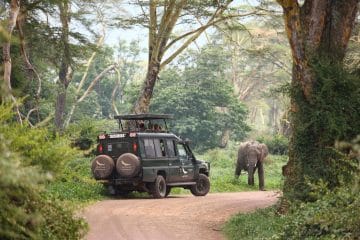
Highlights of East Africa - Luxury experience
East Africa Tanzania Safaris Ngorongoro Crater Serengeti Kenya Maasai Mara
From $ 8900 /USD
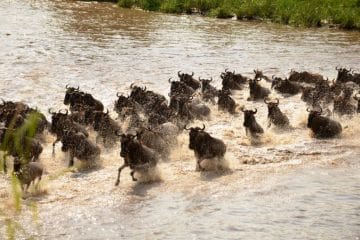
Migration Safari in Kenya and Tanzania With a F...
East Africa Kenya Maasai Mara Tanzania Safaris Serengeti Ngorongoro Crater
From $ 7250 /USD
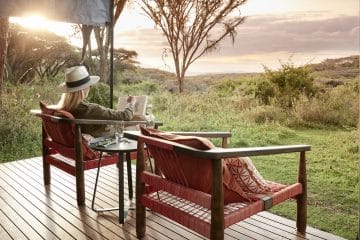
Affordable Fly-in Ngorongoro and Migration Safari
East Africa Tanzania Safaris Ngorongoro Crater Serengeti
From $ 6870 /USD
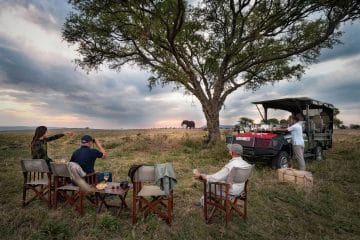
Green Season Migration Safari
East Africa Tanzania Safaris Lake Manyara Ngorongoro Crater Serengeti
From $ 5700 /USD
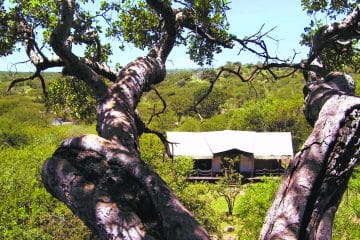
Herdtracker Migration in Central and North Sere...
East Africa Tanzania Safaris Serengeti
From $ 8390 /USD
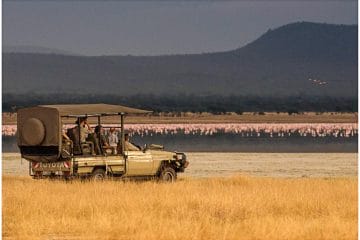
Highlights of Tanzania Group safari
East Africa Tanzania Safaris Lake Manyara Serengeti Ngorongoro Crater
From $ 2600 /USD
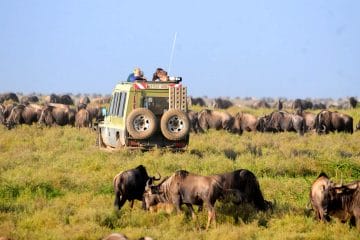
40 Serengeti Safaris to choose from
Stay for 4 - 17 days
Experience our Tailor-made Tours in Serengeti National Park
When is the best month to travel to serengeti national park.
The Serengeti offers year-round safari experiences, with each season providing unique advantages. For detailed insights on the best times to visit and what you can expect during different seasons, check out our detailed guide here.
- Serengeti in January
- Serengeti in February
- Serengeti in March
- Serengeti in April
- Serengeti in May
- Serengeti in June
- Serengeti in July
- Serengeti in August
- Serengeti in September
- Serengeti in October
- Serengeti in November
- Serengeti in December
Our Recommended Tours in Serengeti National Park
Discover the best safari tours tailored for an unforgettable Serengeti adventure. Our recommended itineraries include luxurious experiences, diverse wildlife sightings, and outstanding landscapes. From bespoke luxury safaris, an exploration of the Serengeti’s iconic wildlife spotting regions, or a multi-destination trip to visit Tanzania’s neighboring regions, we have the perfect tour for you. Start planning your dream safari today!
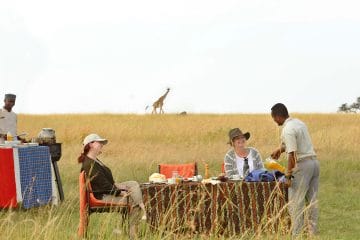
Migration Serengeti Safari Short and Sweet
East Africa Tanzania Safaris Arusha Serengeti
From $ 4990 /USD
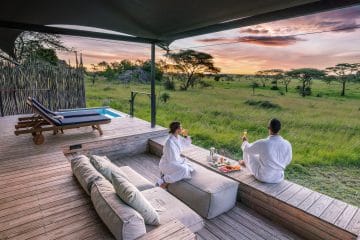
Honeymoon Safari in the Serengeti National Park
From $ 6240 /USD
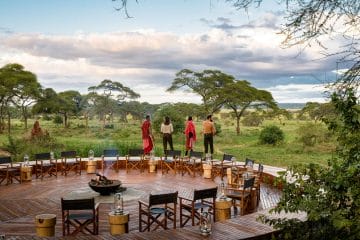
Witness the Great Migration from June to Octobe...
Tanzania Safaris Arusha Tarangire Lake Manyara Ngorongoro Crater Serengeti
From $ 10600 /USD
Looking for Something Unique?
Uncover the magic of the Serengeti with experiences that cater to every traveler’s dream. Whether it’s witnessing the Great Migration, enjoying a tranquil birding adventure, or embarking on a fun-filled family safari, the Serengeti has it all. Revel in the beauty of luxury lodges, savor romantic honeymoons, or explore the wild on horseback safaris. Each adventure promises unforgettable moments and a deeper connection to the stunning landscapes and rich wildlife of the Serengeti. Let us help you discover the perfect experience for you.
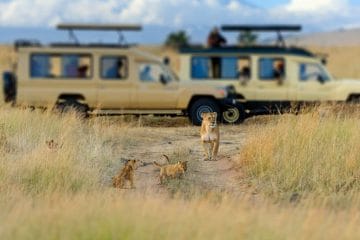
Big Cat Safaris
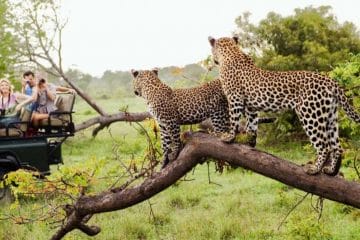
Serengeti Safari Reviews
Hear from our guests who have experienced the wonders of Serengeti National Park. Their stories of exceptional trip planning, life-changing adventures, and memorable experiences reflect the magic of our safaris and the unmatched beauty of the Serengeti.
Susan was incredible, communicative, accommodating and made our trip 5 star and...
15 Day Southern Africa Honeymoon Safari Review
Annie, United States 19 Oct 2023
Two peak challenge.
13 Day Climbing Mount Meru & Mount Kilimanjaro Review
Kevin, United Kingdom 20 Mar 2023
Very helpful, responsive and made my travel planning.
9-Day Cape Town & Kruger Safari Review
Roberta, United States 23 Jan 2023
Incredible honeymoon.
13 Day Safari & Cape Town Honeymoon Review
Sean, United Kingdom 31 Oct 2022
Megan and steve are professional well informed and went out of their....
A Safari holiday in Namibia Review
Jenny, South Africa 01 Nov 2021
Excellent coordination and prompt service.
Masai Mara Safari Review
Dev, Canada 15 Nov 2019
Ready to plan your tailor-made safari.

Steve Conradie, Co-founder, Discover Africa
Free safari planning advice from destination experts
See serengeti in your comfort.
Exploring the Serengeti doesn’t mean sacrificing comfort. The park offers a range of accommodations and travel options designed to provide you with a luxurious and relaxing experience while keeping you close to the incredible wildlife and landscapes.
- Affordable Safari in the Serengeti
- Budget Serengeti Safari
- Luxury Serengeti Safari
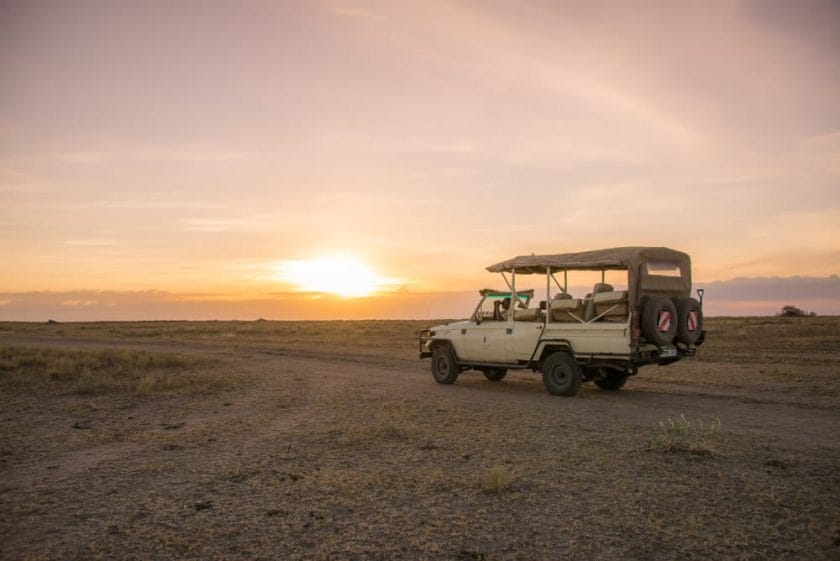
The most affordable way to visit the Serengeti is to book a holiday package which includes transport from Arusha, lodging, meals, park fees, as well as game drives and other activities at the safari lodge. You can also hire your own 4×4 and self-drive in the park, although you can often get better value for money with packages.
While the Serengeti has a concentration of exclusive and luxury camps and lodges, there’s a good choice of mid-range lodging options both inside the park and outside the park gates. The benefit of staying outside of the park boundaries is that you don’t pay park fees for your days of travel to and from the Serengeti, and there are activities on offer – such as night drives – that aren’t permitted in the park.
For discounted rates on lodges and on safari tours, book your trip during the rainiest months of April and May, which are the least popular months to visit the Serengeti. While you’ll have heavy rains, the wildlife viewing is still good, and you’ll get better value for money, as well as fewer other tourists in the park.
While most lodging options in the park cater to high-end travellers, and park fees are pricey (US$60 per person per day), there are a few options available to budget travellers. The most affordable way to do a safari in the Serengeti is to join an overland tour, which will include transport, a guide, the cost of camping, food and park fees.
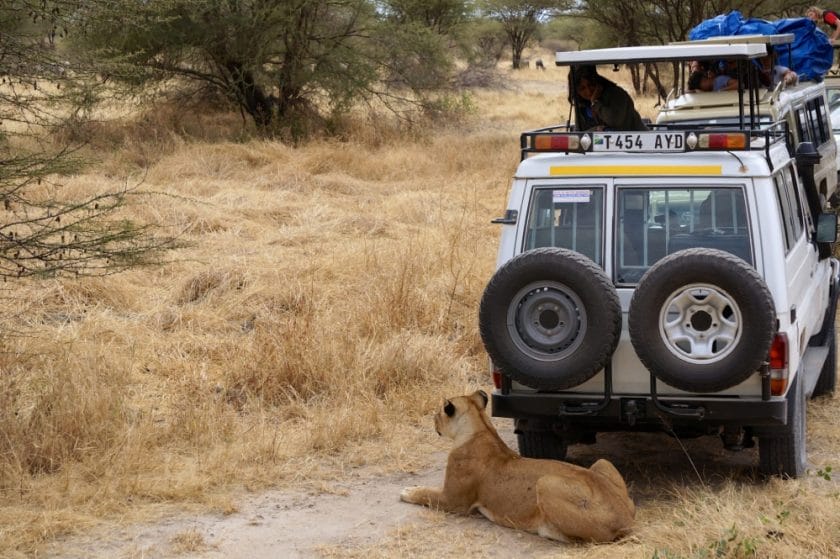
Self-guided independent travellers will need a car to explore the park: you can hire a 4×4 from Arusha or Mwanza, as well as camping equipment, and stay at one of the campsites outside the park gates or at one of the nine public campsites inside the Serengeti: there are six in the Seronera area in the heart of the park, one at Lobo, one at the Fort Ikoma Gate and one at Ndabaka Gate (you can book and pay for these campsites when you enter the park gates). There are also special campsites which you’ll be able to use exclusively for your group. These you’ll need to book in advance through a tour operator or through the Tanzania National Parks Authority. You’ll need to be entirely self-sufficient if you’re camping, so stock up on provisions in either Arusha or Mwanza before you enter the park and bring your own firewood. Many travellers prefer not to drive themselves on the Serengeti’s challenging roads, and instead hire a driver although this will cost a lot more than driving yourself.
The alternative to staying inside the park is to book an affordably priced lodge on the outskirts of the park where your meals and game drives are included in the rate, and spend some time on game drives outside of the park, so you don’t have pay park entrance fees for every day that you’re in the bush.
Travel during the rainy season from January to March, when the Serengeti is at its wettest, to get discounts on lodge rates and safari packages for the best budget deals.
The Serengeti has much to offer high-end travellers, with a wealth of luxury lodges and tented camps scattered across the reserve and on its outskirts. Permanent lodges – which can be small or have dozens of rooms – have the full range of amenities, from tennis courts and gyms to spas and swimming pools where you can watch wildlife drink from water holes while you cool off. Tented camps, which give you a taste of sleeping under canvas without sacrificing any comforts (think king-sized beds, ensuite bathrooms, antique furniture and butler service). Then there are minimal-footprint seasonal bush camps which are only open during the months of the year when the migration is passing through the area, and exclusive, intimate mobile camps, which move a few times during the year with the movement of migrating herds. Mobile camps are an excellent choice for a Serengeti safari, as they get you close to the action in remote, untouched areas, and you get an experience of being immersed in the bush – but this is a long way away from rustic camping. Luxury mobile camps come with hot bucket showers, flush toilets, private butler service and gourmet cuisine served in dining tents, and some offer private and exclusive game drive vehicles and guides for each part of guests.
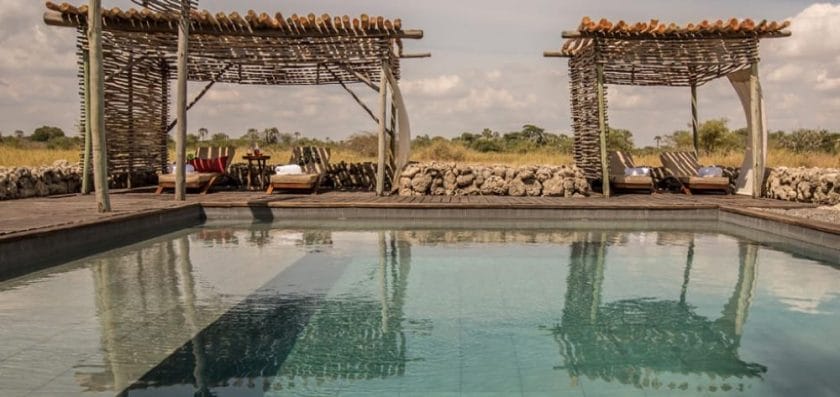
Picking your lodge or camp is a question of when in the year you’re travelling, as the park is vast and there are different attractions in each region at different times of the year. If your priority is seeing the Great Migration, then you’ll need to book a lodge that closest to the action in the month you’re travelling.
You can hire a car, a driver and a private guide from Mwanza or Arusha and travel to the park on your own, or, the much easier and more hassle-free option is to do a fly-in safari, taking a small plane from Arusha to one of the many airstrips located across the Serengeti. Some lodges have their own private airstrips, and a vehicle will be waiting to collect you when you arrive – so your first game drive will be the journey to your lodge. You can also hire a car and a driver and still do a fly-in safari: the driver will travel from Arusha and meet you at the airstrip in the park.
Who is Travelling to Serengeti with you?
Planning your Serengeti adventure? Tailor your journey with experiences designed for every type of traveler. Whether you’re exploring with a loved one, embarking on a family adventure, discovering solo, celebrating a honeymoon, or enjoying a trip with friends, the Serengeti offers unique and unforgettable experiences for all. Select your travel type to find the perfect itinerary and make the most of your safari holiday.
- Serengeti Family Safari
- Serengeti Honeymoon
- Solo Travel in the Serengeti
Having the perfect family holiday in the Serengeti is all about picking the right lodges: while some don’t allow children under the age of 12, others are particularly family-friendly, offering a host of fun kids’ activities such as learning to use a bow and arrow, getting cooking lessons, roasting marshmallows over the campfire. And then there are some camps and lodges allow children under the age of 10 to sleep and eat for free. When choosing your lodge there are a few things to take into consideration, such as picking a place that has a swimming pool so that your kids have something to do during the long hot afternoons in between safari activities.
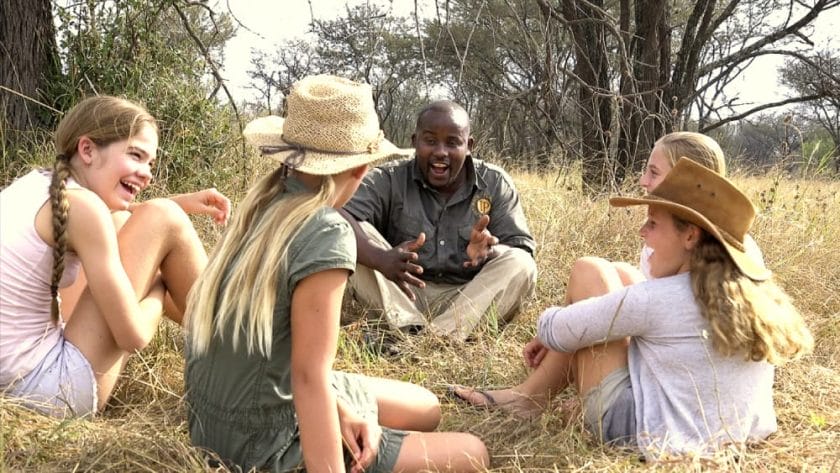
There are family-friendly lodges, camps and mobile camps in all the different regions of the Serengeti, but the wealth of lodging options lies in the Seronera region of the Central Serengeti. If you’re looking to get more off the beaten track, then try the Western Corridor and the Grumeti Game Reserve, or the Eastern Serengeti, while staying in the Northern Serengeti during the months of the Great Migration gives you the chance to catch the exciting and dramatic crossings of the Mara River – thrilling scenes that will keep the kids on the edge of their seats.
In terms of safety, be aware that lodges and camps are unfenced in the Serengeti and you’ll need to keep careful watch over your children, as wild animals can enter the camp at any time. Children should not be allowed to walk around camps on their own. An alternative is to stay at a lodge outside of the park, where children will have more freedom to run around.
While you can fly into the park and get transfers to and from your lodge (and many lodge stays include twice daily game drives), you can also hire a car and a driver for your family, as this gives you more freedom to run on your own schedule and do shorter game drives if you have small children who get restless in the car on long drives.
The Serengeti is the ultimate romantic safari destination: a magical combination of breathtaking landscapes, superb wildlife viewing and the drama of Great Migration sightings, as well as truly memorable luxury lodges and camps situated in remote reaches of the wilderness make for a very special holiday.
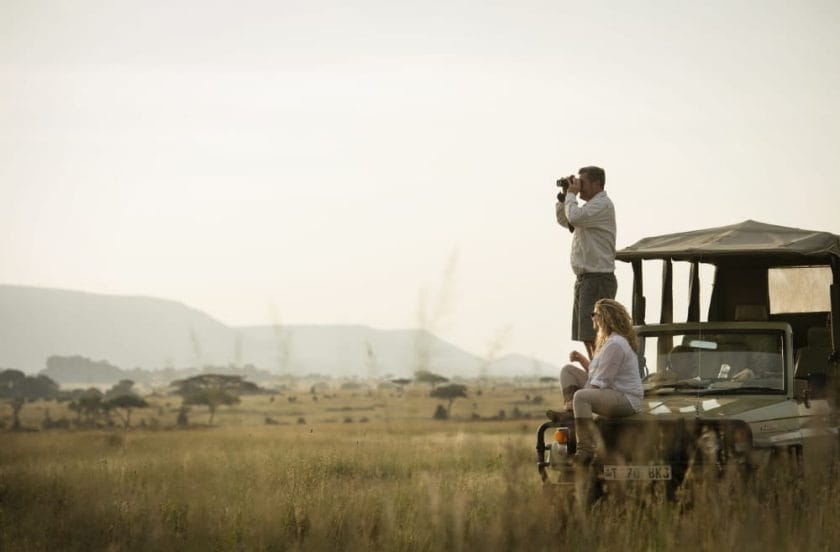
Choosing which region to stay in the Serengeti on your romantic holiday is all about what time of year you’re travelling, as wildlife movements are seasonal and many lodges and camps are only open for certain months of the year. Every region of the park has superb upmarket lodges and camps that cater for romantic safaris – and each region has its benefits, depending on what kind of experience you’re looking for. The Central Serengeti has the biggest array of choices, with the Seronera region in particular boasting the largest concentration of places to stay. For exclusivity, stay at one of the lodges or camps in the Grumeti Game Reserve in the western Serengeti. If you really want to get off the beaten track, stay at one of the few camps in the Soit Le Motonyi region at the far east of the park, which was closed for two decades and only re-opened a few years ago.
Choose to stay in a permanent lodge, which will have a wide range of facilities such as gym, swimming pools and spas, or stay in a more intimate tented permanent camp where rooms may be under canvas but feature king-sized beds, stylish antique furniture and spacious ensuite bathrooms. On the other hand, mobile tented camps are a wonderful choice if you want the feeling of really being in the wild: you can experience giant herds of wildebeest grazing just metres away from your tent. There’s no electricity or running water (although you can expect hot bucket showers) but luxury mobile camps are far from rustic: think large, beautifully decorated tents with ensuite bathrooms and outdoor seating, communal lounge and library areas and gourmet meals.
Many lodges offer special romance or honeymoon packages that include activities such as bush picnics for two, couples’ massages, private sundowners and exclusive candlelit dinners in the bush or on your private deck. For the ultimate romantic safari, book a private safari vehicle through your lodge, so that you’ll be able to go on game drives where it’s just you, the driver and your guide.
The beauty of solo travel in the Serengeti is having the option to be with other travellers, or to enjoy this vast wilderness on your own private game drives.
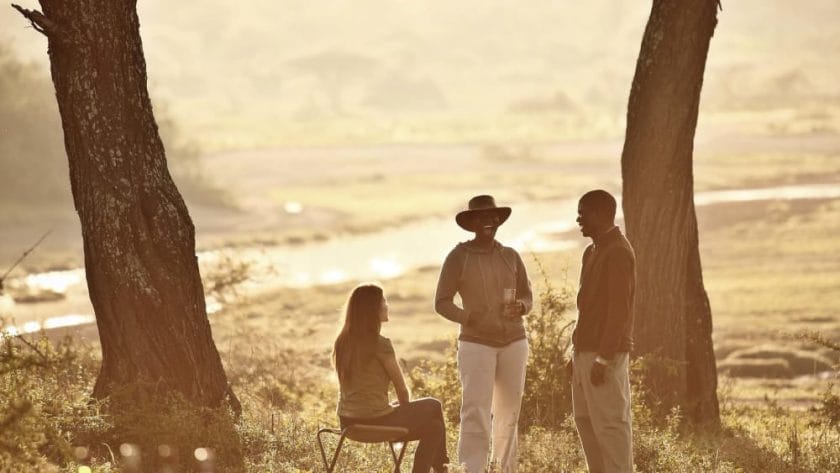
The best option for solo travellers to the Serengeti in terms of getting to meet other travellers and have a value-for-money trip, is to join a safari tour – an all-inclusive package holiday that covers transport, a guide, lodging, park fees, activities and meals. It’s a hassle-free way to travel, and you’ll have the safety and security of travelling in a group.
Independent travellers can hire a car and a drive from Arusha and Mwanza and stay in a camp inside the park, joining up with fellow travellers on game drives from your lodge or camp, or travelling in their own vehicle. Another option is booking a stay at one of the many all-inclusive lodges across the park’s regions, and doing a fly-in safari: take a small charter plane to the closest airstrip servicing your lodge, and start your first game drive as you’re picked up from the runway in the lodge’s safari vehicle. Many lodges include twice daily game drives as part of an all-inclusive package, as well as other activities such as nature walks and Maasai cultural visits where you’ll be able to join other guests.
What You Need To Know
Planning a trip to Serengeti National Park involves considering several important factors to ensure a smooth and enjoyable experience. From understanding visa requirements and health precautions to knowing the best times to visit and local customs, having the right information will help you make the most of your journey. Discover Africa provides essential tips and insights to help you prepare for an unforgettable adventure in this exceptionally beautiful park.
- Wildlife in the Serengeti
- When to Go on a Serengeti Safari
One of the greatest wilderness areas in the world, the Serengeti supports a magnificent diversity and abundance of animals, from the Big Five – lion, leopard, elephant, buffalo and black rhino (although these are rarely spotted) – to giraffe, Grant’s gazelle, impala, kongoni, topi and eland.
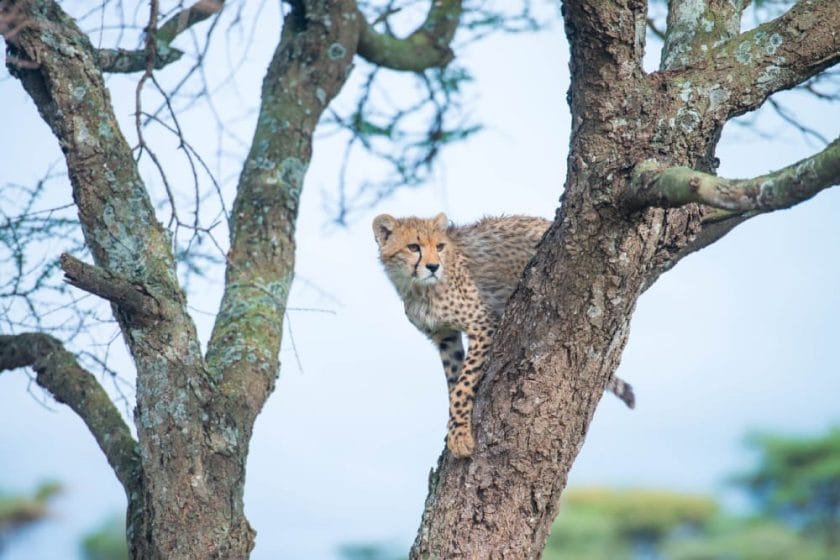
The Serengeti is famous for its predators: you can expect excellent lion and cheetah sightings (and exciting lion kills), and leopards are also regularly spotted. Other predators include serval cats, golden and black-backed jackal, African wild dog and spotted hyenas.
The Great Migration is the stellar highlight of the Serengeti’s wildlife: an annual circular movement of millions of wildebeest, zebra and gazelle northwards into the neighbouring Masai Mara National Reserve in Kenya and back into the plains of Serengeti. This mass movement of animals is accompanied by predators picking off their kills, while the dangerous crossings of the mighty Mara River make for dramatic scenes of struggle and survival as animals battle strong currents and attacks by huge Nile crocodiles.

For birders, there are more than 500 species in the park, including a few Tanzanian endemic species, such as Fischer’s lovebird, grey-breasted spurfowl and rufous-tailed weaver. Other birding highlights include kori bustard, secretary bird, usambiro barbet, yellow-throated sandgrouse, grey-crested helmet shrike, and Hildebrant’s starling.
Planning the best time to visit Serengeti National Park can significantly enhance your safari experience.
Here’s a detailed guide to help you choose the ideal time based on weather, wildlife sightings, and overall conditions:
Dry Season (June to October)

Overview: The dry season is considered the best time for wildlife viewing in the Serengeti. The lack of rain means animals congregate around water sources, making them easier to spot.
- Temperature: Daytime temperatures range from 24°C to 28°C (75°F to 82°F), while nighttime temperatures can drop to 14°C to 18°C (57°F to 64°F).
- Rainfall: This period sees very little rain, resulting in sparse vegetation and better visibility for wildlife spotting.
Wildlife Sightings:
- Great Migration: Increased chances of witnessing the dramatic river crossings of the Great Migration in the Northern Serengeti.
- Big Five: Excellent opportunities to spot the Big Five as animals gather around waterholes and rivers.
- High wildlife concentration around water sources.
- Pleasant temperatures during the day.
- Fewer mosquitoes and lower risk of malaria.
- Cooler nights and mornings require warm clothing.
- The dry landscape may not be as visually appealing as the lush green of the wet season.
Wet Season (November to May)
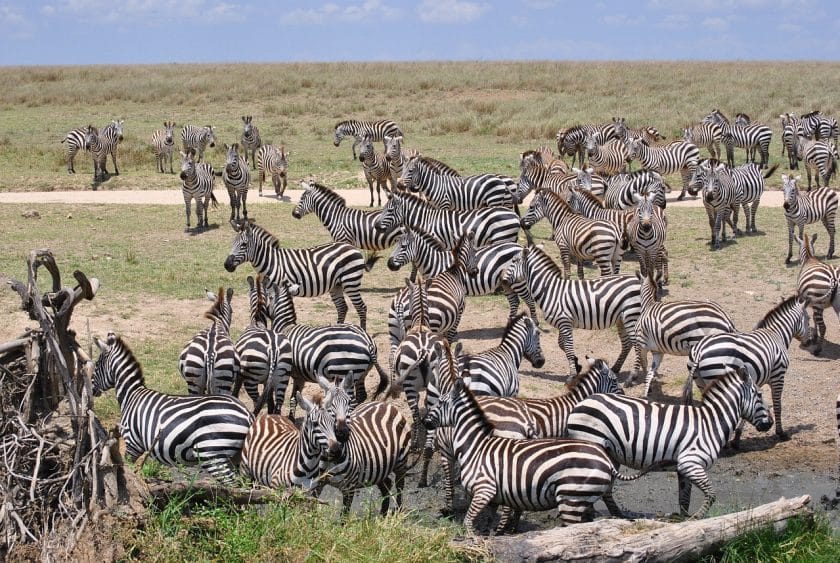
Overview: The wet season is characterized by lush landscapes and an abundance of birdlife.
This is the best time for birdwatching and seeing newborn animals.
- Temperature: Daytime temperatures range from 26°C to 30°C (79°F to 86°F), with high humidity. Nighttime temperatures are mild, ranging from 16°C to 20°C (61°F to 68°F).
- Rainfall: Expect afternoon thunderstorms, particularly from March to May. The rain transforms the park into a verdant paradise.
- Bird Watching: This is the peak season for birdwatching, with many migratory species present.
- Newborn Animals: Many animals give birth during this period, providing opportunities to see young wildlife.
- Lush, green landscapes.
- Excellent bird watching opportunities.
- Lower tourist numbers, leading to a more exclusive experience.
- Higher temperatures and humidity.
- Increased mosquito activity and higher risk of malaria.
- Dense vegetation can make wildlife spotting more challenging.
Key Considerations for Each Month:

June to October (Dry Season):
- June : Start of the dry season; good visibility for game drives.
- July to September : Peak months for witnessing the Great Migration river crossings; excellent wildlife viewing.
- October: End of the dry season; animals still concentrated around water sources.
November to May (Wet Season):
- November: Start of the wet season; park begins to turn green.
- December to February: Hottest and wettest months; best for birdwatching and seeing newborns.
- March: Peak of the wet season; lush landscapes and vibrant wildlife.
- April to May: Transition months; cooler temperatures and decreasing rainfall.
Each season in Serengeti National Park holds its own rewards for nature enthusiasts and first-time visitors.
To learn more about the best time to visit and plan your perfect safari, visit our detailed guide here.

We have 5 rating for 447 reviews
We have 4.7 rating for 35 reviews
We have 4.9 rating for 73 reviews
- Why Serengeti National Park
Join our newsletter
Sign up to receive exclusive offers, safari inspiration, and expert tips straight to your inbox.
By proceeding you agree to our Privacy Policy and Terms & Conditions .
POPULAR DESTINATIONS
Popular tours.
- Luxury Explorers Safari in Botswana
- Romantic Cape Town & Luxury Safari
- Masai Mara and Serengeti Combo
- Wildlife and Gorillas of Rwanda
- Luxury Honeymoon in Mauritius
POPULAR ACCOMMODATIONS
- Sabi Sabi Earth Lodge
- Chobe Game Lodge
- Khwai Lediba
- Camp Okavango
- Khwai Leadwood
QUICK LINKS
- Safari Cost Estimator Tool
- [email protected]
- destinations
- experiences

- Ngorongoro Crater
- Lake Manyara
- Great Migration
- Kilimanjaro
- Mainland Coast
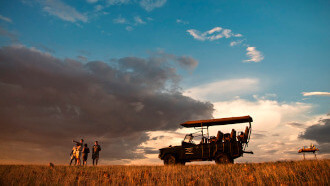
Serengeti Safaris in the Serengeti National Park
- Northern Tanzania

Serengeti Safaris | Tanzania
Map of Serengeti Safaris | Tanzania
Our favourite permanent camps in the serengeti, mobile camps in the serengeti, hand picked serengeti itineraries, a guide to a serengeti safari tour , the serengeti regions explained | where to stay, the central serengeti and the seronera river valley (good all year round), the western corridor and grumeti (may through to mid july), the north, kogatende, lobo and lamai (july to november), the southern short grass plains of the serengeti (december through to march/april), serengeti activities, serengeti or masai mara safari , more about the serengeti: , client reviews.
Lamai Serengeti - Reviews The Nomad Lamai was great. The game drives were really good and we saw just about everything possible including wildebeests crossing the river (all got over safely and the crocs were nowhere to be seen), mating ostriches, rhinos and even a leopard tortoise! * * * * * - A Parker
Namiri Plains - Reviews Absolutely unbelievable, i have been going on safari for 20 years and only ever seen a handful of kills, but at Namiri i saw 5 in 3 nights ! just the best !!!! – we will be back … * * * * * - R Tilson
Alex Walker's Serian Serengeti North - Reviews This was a mobile tent. Far nicer than we expected. Staff was friendly, knowledgeable, and accommodating. Food was very good. A great experience. Could easily have stayed longer. M Goldsmith * * * * * - G Romario
Alex Walker's Serian Serengeti South - Reviews This was one of the best safaris we've been on! The staff, guides, and rooms were fantastic! * * * * * - M Goldsmith
Singita Faru Faru - Reviews All three lodges (Plantation, Singita Mara, Faru Faru) for the safari expeditions were over the top (all fives by our reckoning) and provided a fine experience from all perspectives. Attention to detail and personal service were above and beyond. Animal viewing was exceptional and the guides were among the best we have enjoyed in our African trips. * * * * * - B & T Mitchell
TALK TO ONE OF OUR EXPERTS
Map of tanzania.

- Mt. Kilimanjaro
south & west

BEACHES / ISLES

The Complete Guide for your Serengeti Safari in Tanzania
Without a doubt, Serengeti National Park is the best place to visit for a safari in Tanzania . This UNESCO World Heritage Site is unique for many reasons, but especially because of the Great Migration , the incredible array of wildlife including the Big Five , and the truly wonderful landscapes. Find everything you need to know for a safari in Serengeti , Tanzania.
Why is Serengeti National Park famous?
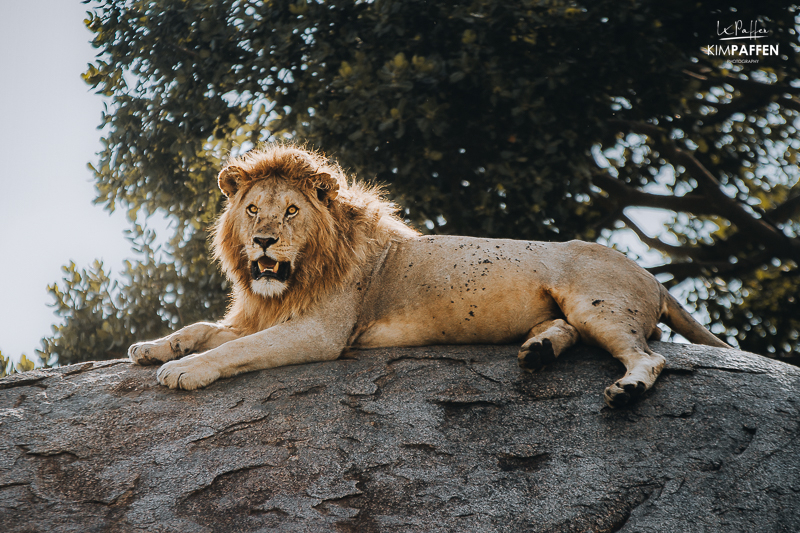
Serengeti National Park is a world-renowned destination for wildlife safaris, famous for its vast grasslands and savannahs, which are home to a spectacular array of wildlife. The park's ecosystem supports one of the largest remaining populations of wildlife in Africa , and is also an important conservation area, with ongoing efforts to protect its wildlife and their habitats.
In 1981, the Serengeti National Park was declared a UNESCO World Heritage Site for its exceptional natural beauty and ecological significance, and for its role in supporting one of the world's largest remaining wildlife populations, including the annual wildebeest migration.
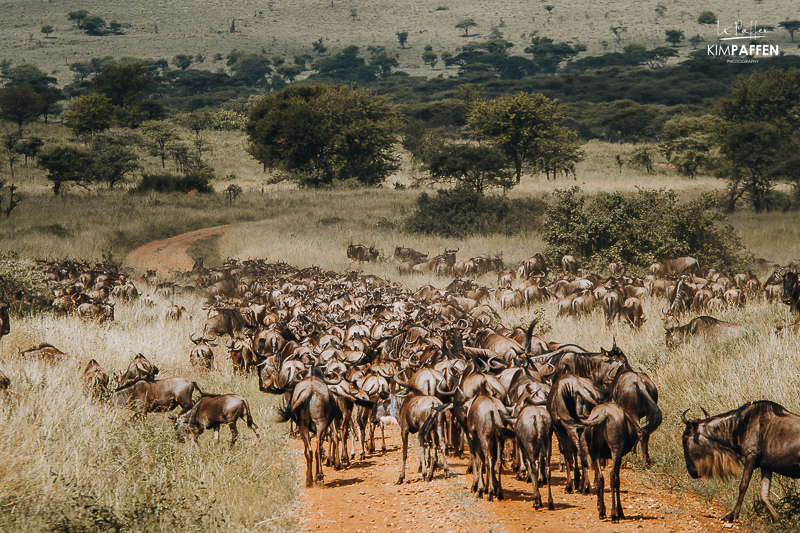
Visitors come from all over the world to experience the park's incredible wildlife, stunning landscapes, and unique cultural and historical heritage. The park's popularity also helps to support the local economy and promote conservation efforts in the region.
The beauty of the Serengeti’s Landscape
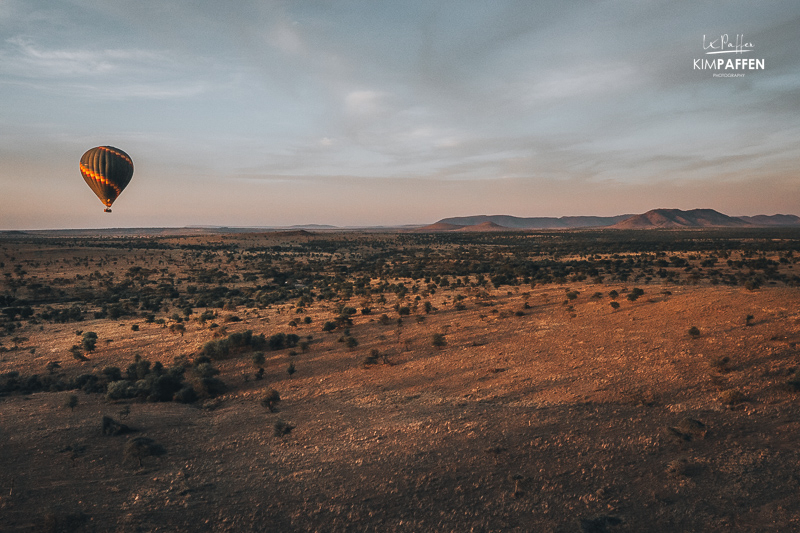
The Serengeti National Park has a diverse landscape that includes vast grasslands, savannahs, woodlands, and riverine forests.
The park's grasslands and savannahs are the dominant landscape, covering approximately 80% of the park's area. The grasslands are characterized by short-grass plains in the south and long-grass plains in the north, and they support large herds of herbivores, including wildebeest, zebras, and gazelles, which in turn attract predators such as lions , leopards, cheetahs, and hyenas. The woodlands and riverine forests are found along the park's river courses and in areas of higher rainfall.
The soils of the Serengeti consist of volcanic rock and ash. For that reason, you will find ancient crystalline rocks in the Serengeti National Park, which are also called "kopjes". Some of them contain African rock paintings. They harbor and are popular resting spots for big cats because they provide shade and drinking water. Can you spot the pride of lions in the image below?
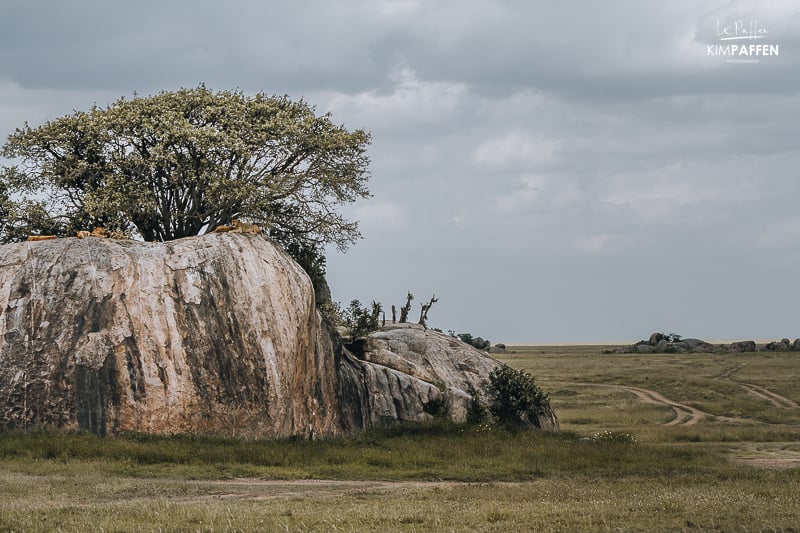
Serengeti Safari Tours
Find popular Serengeti safari tours in Tanzania that include Serengeti National Park.
Where is the Serengeti National Reserve located?
The Serengeti National Reserve is located in Northern Tanzania , East Africa. It covers an area of approximately 14,750 square kilometers and is part of the larger Serengeti-Mara ecosystem that extends into neighboring Kenya . The Serengeti-Mara ecosystem is one of the largest and most protected ecosystems on earth, spanning 40,000 square kilometers and taking in the Serengeti National Park and Maasai Mara National Reserve in East Africa. Serengeti National Park also borders the beautiful Ngorongoro Conservation Area.
Serengeti National Park Map Source: African Safaris Ltd
How do you get to the Serengeti?
The nearest city and the city most Serengeti safari tours begin from, is Arusha. The distance between Arusha and Serengeti National Park is approximately 320 kilometers (200 miles) and takes about 7 to 8 hours by car, depending on traffic and road conditions. Alternatively, you can also take a flight from Arusha to one of the Serengeti airstrips . These flights take around 1 to 2 hours depending on the flight route and airline. By far the most popular way to get to Serengeti is by road. You can always choose to fly back from Serengeti to either Arusha Airport, Kilimanjaro Airport, or Dar es Salaam.
Serengeti safari by road from Arusha
Arusha is located in northern Tanzania and is a common starting point for visitors embarking on a safari to the Serengeti National Park. There are many different tour operators and packages available for a Serengeti safari from Arusha , so visitors can choose an itinerary that suits their interests and preferences. Some tours may include game drives , guided walks, and visits to local Maasai villages or conservation projects.
The most popular safari packages in Northern Tanzania include Lake Manyara, Ngorongoro Crater, and Serengeti National Park, for example, these 5-day Tanzania safari tours that include the highlights of the Northern Tanzania Safari Circuit or this 7 to 10-day Tanzania safari including Tarangire National Park, the Ngorongoro Crater, Serengeti National Park, Lake Natron, and Lake Manyara.
Booking a safari tour package can be a convenient option since everything is taken care of, including transportation, accommodation , meals, and activities. This means you don't have to worry about logistics and can focus on enjoying your safari experience. It can often be more cost-effective than planning your own safari plus these safari tours are usually operated by experienced guides.
Many safari tour operators offer customized packages that can be tailored to your interests and preferences. This means you can choose the parks, activities, and accommodations that best suit your needs and budget.
Serengeti by plane
There are several options for traveling to the Serengeti National Park by plane. The main airport that serves the park is the Seronera Airstrip , which is located in the central part of the park.
You can fly to the Seronera Airstrip from Arusha, Kilimanjaro International Airport, Dar es Salaam, or Zanzibar . Several airlines operate flights to the Seronera Airstrip, including Coastal Aviation and Auric Air. If you are visiting other parks in Tanzania, such as the Ngorongoro Crater or Tarangire National Park, you can also fly to the Serengeti National Park via a connecting flight. Many lodges and camps inside Serengeti Park offer transfer services to and from the airstrip.
In addition to the Seronera Airstrip, there are several other airports in the Serengeti region that you may be able to use to access the park. These include:
- Grumeti Airstrip : located in the western part of the Serengeti National Park, near the Grumeti River. It is primarily used by lodges and camps in the western corridor of the park.
- Kleins Airstrip : located in the northern part of the Serengeti National Park, near the border with Kenya. It is primarily used by lodges and camps in the northern part of the park, such as Klein's Camp.
- Kogatende Airstrip : located in the northern part of the Serengeti National Park, near the Mara River. It is primarily used by lodges and camps in the northern part of the park, such as Sayari Camp and Lamai Serengeti.
It's important to note that not all lodges and camps in the Serengeti have their own airstrips , and some may require ground transfers from nearby airstrips. It's best to check with your lodge or tour operator to determine which airport is most convenient for your specific itinerary.
Private transfer by car (taxi)
There are several transport services in Tanzania that offer private taxis, shuttles, and bus services to the Serengeti National Park. Most transportation companies are located in Arusha. Serengeti National Park is large, so the costs depend on where you want to go (total distance). Note that private transfers to Serengeti are often expensive as the cost of the return trip also needs to be covered. Additionally, the driver also needs to pay entrance fees if you want to be taken to a lodge inside the park.
Many tourists choose to combine Serengeti National Park with other parks that are located near Serengeti, such as Lake Manyara National Park, Ngorongoro Crater, or Tarangire National Park.
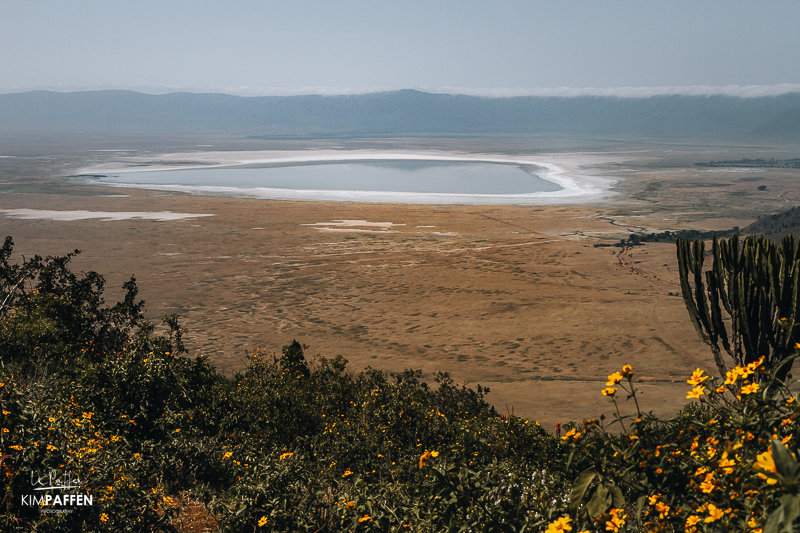
I highly recommend combining a Serengeti safari with other National Parks and booking your customized safari package through a tour operator, for example via SafariBookings.com .
Public transport
Determined to explore Serengeti on a budget? Public transport is the cheapest way to travel in Tanzania. Large buses and ‘daladalas’, which are small public transport buses, crisscross the country and link the major towns. Longer routes even link Dar es Salaam with Nairobi and Mombasa in Kenya. Public transport is quite efficient between big cities, but it gets slower, less comfortable, and more challenging when you intend to reach smaller towns. To cover short distances, tuk-tuks and boda-bodas can be used.
In Tanzania’s National Parks, there's no public transport, so you cannot access Serengeti National Park without a private vehicle. This means you can only use public transport for the part of your trip which is out of the park, but this will be an adventure.
Self-drive in the Serengeti
Self-driving in Serengeti National Park is allowed, however, it is important to keep in mind that careful planning is necessary when driving through the park by yourself. A 4x4 vehicle is required to be able to access all roads throughout the year, and it is important to be familiar with the park's rules and regulations. It is also recommended to have a good understanding of the park's geography and to carry a detailed map. Additionally, it is important to be aware of the risks and challenges of driving in the park, such as navigating rough terrain and encountering wildlife on the roads. Therefore, it is generally recommended to use a reputable local tour operator or guide to ensure a safe and enjoyable experience in Serengeti National Park.
What is the best time for a safari in Serengeti, Tanzania?
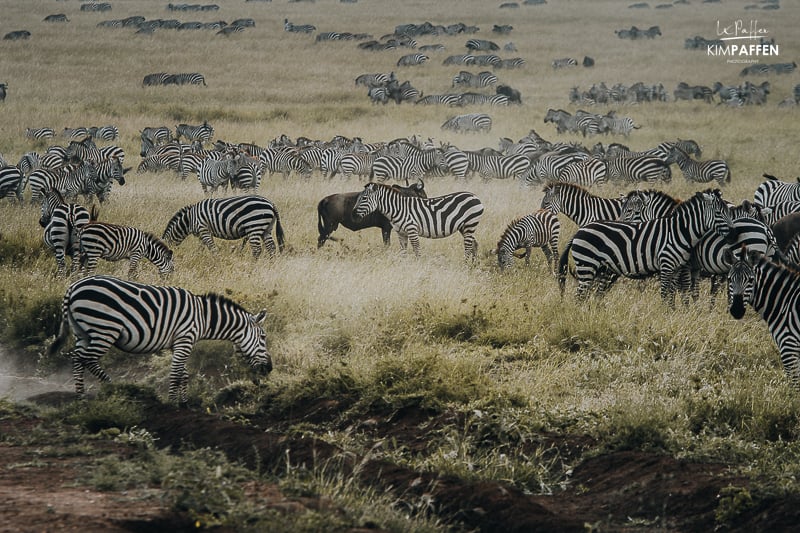
The best time for a safari in Serengeti depends on what you want to see and experience. The annual Great Migration is one of the main attractions in Serengeti, and it usually takes place from November to August. The best time to witness the wildebeest migration is from December to July when the herds of zebras and gnus are in southern and central Serengeti. However, visiting the Serengeti in December can be tricky due to the unpredictable weather. From July to October the Great Migration will take place in the northern part of Serengeti and the Masai Mara in Kenya.
The best time for safari in Serengeti, Tanzania is also influenced by the weather. The dry season, from June to October, is considered the best time to visit as it offers clear skies, lower humidity, and good visibility for wildlife viewing. The rainy season, from November to May, is when the park is lush and green, with many newborn animals and migratory birds, but it can also make the roads difficult to navigate.

If you're interested in seeing big cats, such as lions and leopards, the dry season from June to October is the best time to visit. During this time, the vegetation is sparse, making it easier to spot these elusive predators.
If I had to pick a favorite time to visit, I would choose October as the best month to visit Serengeti . It’s when the dry season ends and the wildlife gathers around water sources, making it easier to spot them. It's also the time when the wildebeest migration is in full swing, the weather is mild, and there is little rain, making it a comfortable and less crowded period to visit. You gotta love these shoulder seasons!
How safe is Serengeti?
Visiting Serengeti National Park is safe , but it's important to respect the animals and park rules and regulations, including the prohibition of littering and feeding animals, and follow the advice of your safari guide , who is a trained and experienced professional. The reserve is protected by certified park rangers , ensuring your safety, so inside Serengeti National Park there is no need to worry about safety.
How many days do you need in Serengeti?
The length of your visit depends on your preferences and schedule, but I would recommend spending at least three to four days in Serengeti Park to fully experience its beauty and wildlife because Serengeti has a lot to offer. The more time you have, the better.
Visiting Serengeti National Park for three days should give you enough time to explore the park, spotting various animal species, and experience the different landscapes. If you have a specific interest in seeing the Great Migration in Serengeti or want to go on longer game drives, a 4-5 day visit is more ideal.
Is Serengeti expensive?
How much does a safari in Serengeti cost? Serengeti National Park can be expensive, but the cost of visiting the park depends on a few factors, such as the type of accommodation, the time of year you visit, and the activities you plan to do.
Accommodation in Serengeti ranges from budget camping sites to luxury lodges, so the cost of your stay will depend on your preferences and budget. Generally, the more luxurious the accommodation, the higher the cost.
The costs of safari activities in Serengeti , such as game drives, hot air balloon safaris , and guided walks, can also vary depending on the operator you choose and the duration of the activity.
Furthermore, the Serengeti Park Entrance Fees for foreign visitors are relatively high, with a daily fee of $83 per person per day for adults and $24 for children (as of 2024). These fees are subject to change, and there may be additional fees for certain activities.
For instance, this budget 3-day Serengeti safari package starts at $728 per person including park fees, activities, transportation, budget camping, and meals.
Which part of Serengeti is best?
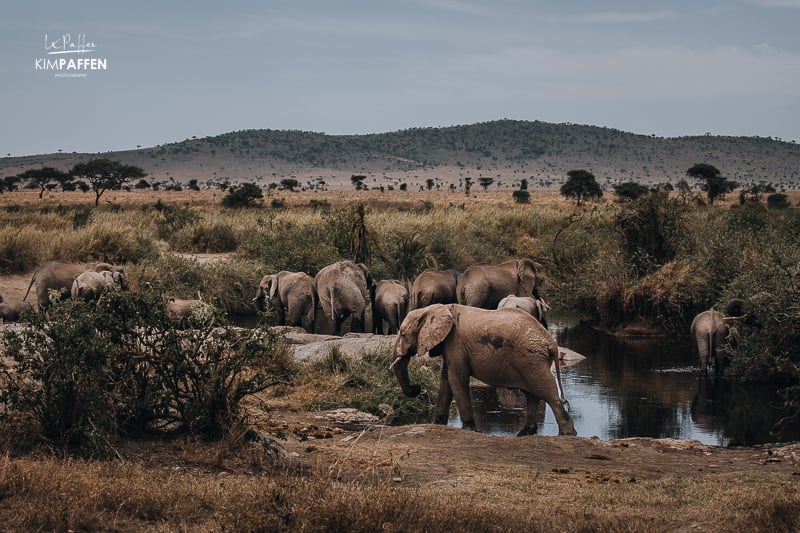
Serengeti National Park is divided into several different regions, each with its own distinct features and wildlife viewing opportunities, making it hard to say which part of Serengeti is the best.
The Seronera region is the heart of the Park, located in Central Serengeti. It is known for its wide-open savannah landscape and abundant wildlife, including the Hippo Pool full of countless hippos. Simba Kopjes, a group of rocky hills, is a popular area in Seronera, famous for its lion sightings and high density of leopards. However, note that the Seronera Valley is the busiest area of the Serengeti park.

Northern Serengeti is a more remote and rugged region, home to the Mara River, which is known for its scenic beauty and wildlife, including spectacular river crossings and predators such as lions and crocodiles.
The Western Corridor is located in the western part of Serengeti National Park, with the Grumeti River running through it, attracting various predators and hosting large herds of wildebeest and zebras during the migration season.
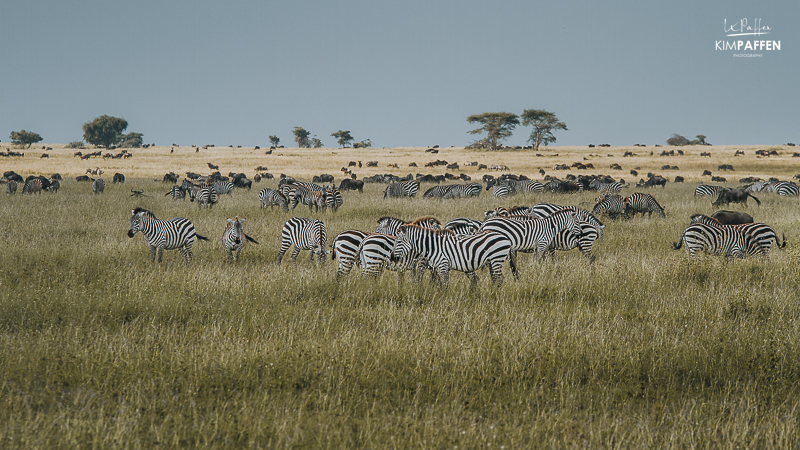
Eastern Serengeti is known for its open savannah grasslands and is less visited than the other regions, but still home to a variety of wildlife, including giraffes and elephants.
Ndutu , located in Southern Serengeti and part of the Ngorongoro Conservation Area, is another popular area to visit. It is famous for its large open plains and is the breeding ground for wildebeest and zebras during the calving seasons in March and April, attracting plenty of predators such as cheetahs and lions. As there are no fences between the parks, the animals are free to roam.
Serengeti Balloon Safari
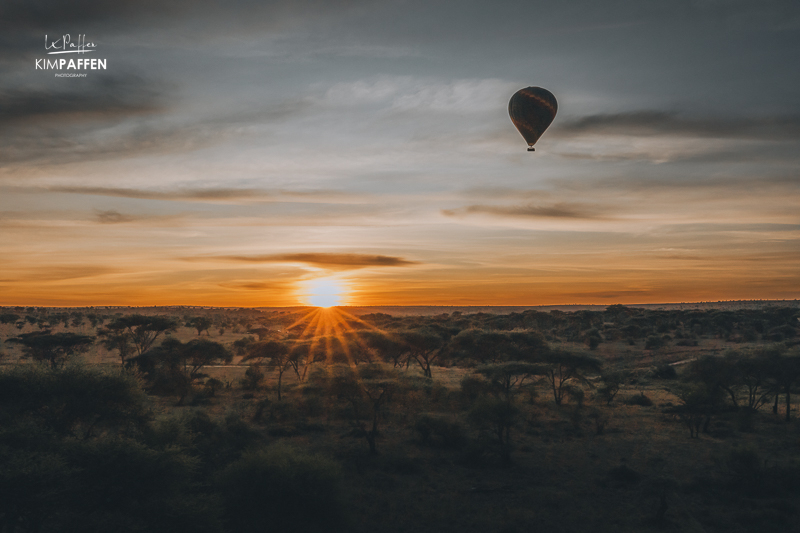
To get the best out of your Serengeti experience, you should definitely book a balloon safari . A Serengeti Balloon Safari is a popular activity and is a unique way to experience the park and see its wildlife from above. The balloon safari takes place early in the morning, just before sunrise. The balloon flies low over the Serengeti's plains and savannahs, providing a panoramic view of the landscape and wildlife below.

During the flight, passengers can expect to see a variety of animals, including elephants, lions, giraffes, zebras, and wildebeest. The flight typically lasts for about an hour, after which the balloon lands and passengers are treated to a champagne breakfast in the middle of the Serengeti wilderness.
Serengeti Travel Tip: Read more about a Serengeti balloon safari if you're interested in a hot-air balloon ride in Serengeti. That article also includes an attractive discount!
Is Serengeti better than Masai Mara?
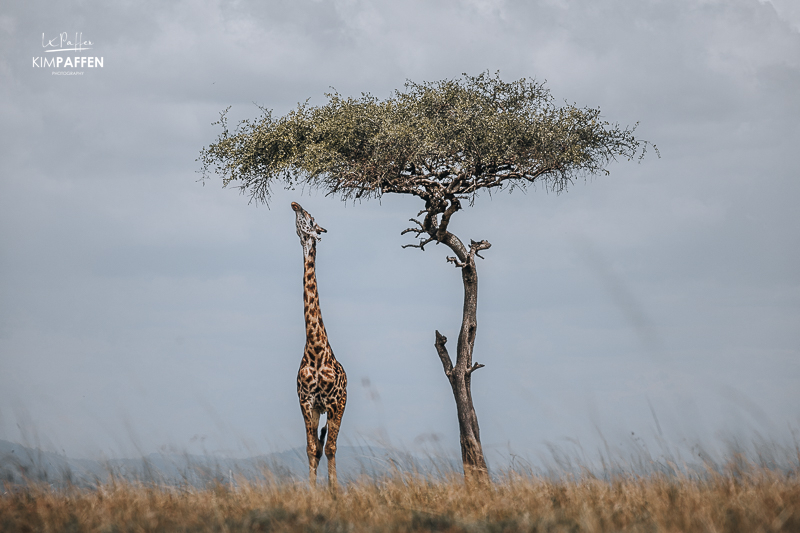
Serengeti and Maasai Mara are two incredible safari destinations that share the same ecosystem, wildlife, climate, and types of landscapes, yet they have some distinctions. While both offer an exceptional safari experience, there are some notable differences between them. For instance, Serengeti National Park is larger than the Masai Mara National Reserve and relatively more expensive. The primary reason for the price discrepancy is that tourists typically stay within the Serengeti, where they are required to pay a daily concession fee in addition to the National Park fee (140 USD in total).
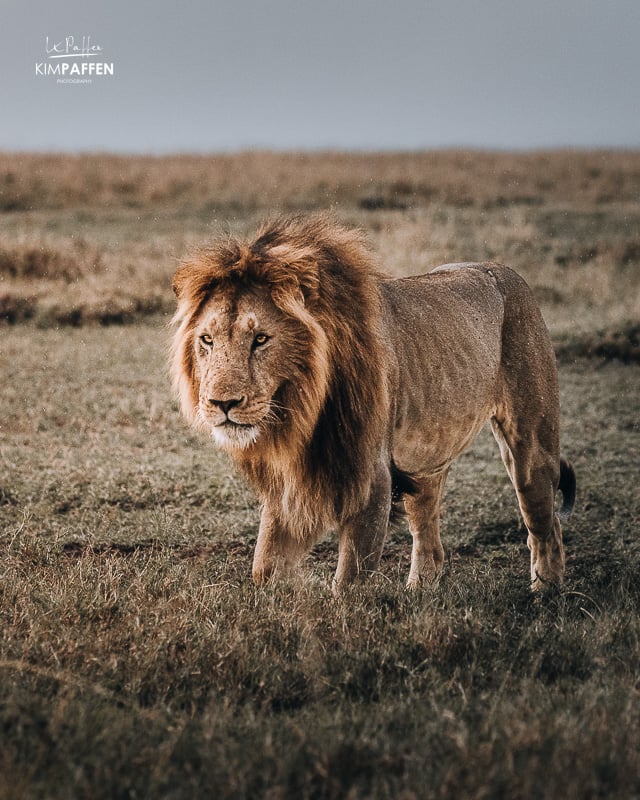
Determining whether the Serengeti or the Masai Mara is better is difficult, as both offer unique and memorable safari experiences. However, personally, I love to spend time in the Mara Conservancies, bordering the Masai Mara National Reserve.
Is Serengeti malaria-free?
Serengeti National Park is located in a malaria-endemic region, and there is a risk of contracting malaria while visiting the park. Due to the limited water sources, the high altitude, and the prevalence of short grasslands within the Serengeti National Park, the mosquito population is relatively low, which results in a reduced risk of contracting malaria while visiting the park.
However, it's important to note that even though the park has fewer mosquitoes and lower chances of malaria cases, it doesn't completely eliminate the presence of mosquitoes in the Serengeti. It's always advisable to consult with a healthcare professional before traveling to a malaria-endemic area and to take preventive measures against malaria, such as wearing long-sleeved clothing and pants, using insect repellent, and sleeping under a mosquito net.
Is Serengeti fenced?
Serengeti National Park is not entirely fenced. The park is part of a larger ecosystem that includes several wildlife reserves and protected areas, and wildlife can move freely between these areas. This is especially true during the annual wildebeest migration, where millions of animals move across the Serengeti-Mara ecosystem. However, there are some smaller fenced-off areas within the park, such as some of the lodges and campsites that have fences for the safety of guests.
How to enter the Serengeti National Reserve?
The Serengeti National Park is primarily accessible by plane or via road transportation. The park has multiple entry gates into Serengeti , including Naabi Hill Gate, Kleins Gate, Fort Ikoma Gate, Ndabaka Gate, and Habdajega Gate.
There are four main entry and exit points into the Serengeti:
- Naabi Hill Gate is the main gate, and the busiest entrance point, located about 45 kilometers from Seronera. The gate is open daily from 06h00 to 18h00.
- Ndabaka Gate is the primary access gate for the Western Corridor area, which is approximately a 1.5-hour drive from Mwanza and 145 kilometers from Seronera. The gate is open daily from 06h00 to 18h00, but the last entry is at 16h00.
- Klein’s Gate is situated in the far northeast of the Serengeti and is open daily from 06h00 to 18h00, with the last entry at 16h00.
- Bologonya Gate is located en route to or from Kenya; do check if the gate is (still) closed as it was closed for a while.
Best places to stay in Serengeti
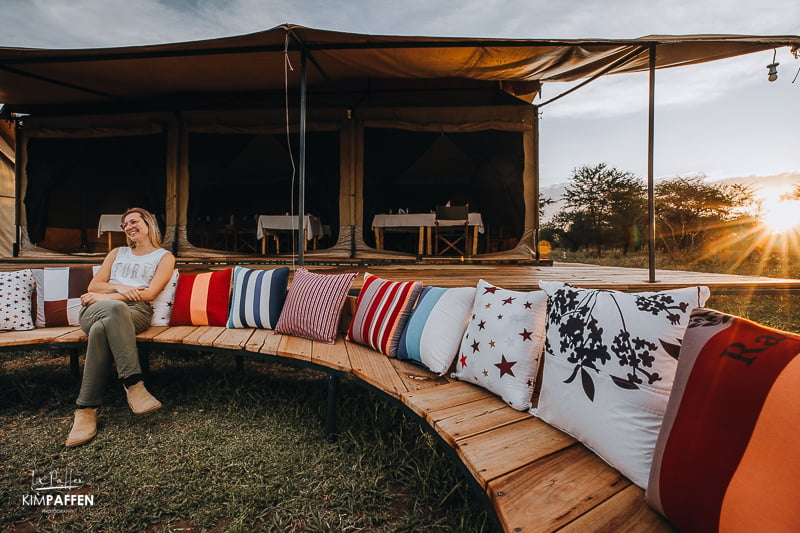
There are many excellent places to stay in Serengeti , ranging from luxurious lodges to budget-friendly campsites. The best place to stay depends on your preferences, budget, and travel style.
If you're looking for luxury, some of the best lodges include Singita Sasakwa Lodge , Four Seasons Safari Lodge Serengeti , and AndBeyond Grumeti Serengeti Tented Camp . These lodges offer top-notch amenities, personalized service, and breathtaking views.
For mid-range options, you might consider places like Serengeti Serena Safari Lodge , Lemala Kuria Hills Lodge , or Serengeti Explorer Camp . These lodges offer comfortable accommodation, good food, and a range of activities.
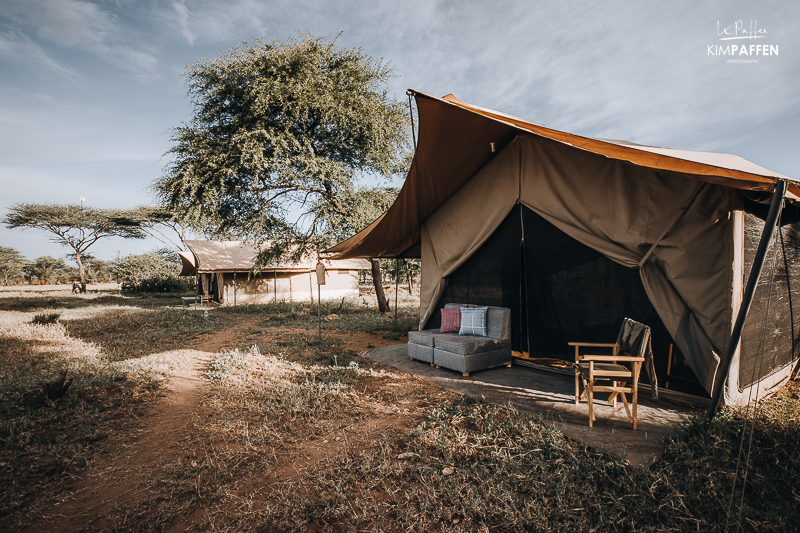
If you want to visit Serengeti on a budget , there are several campsites and budget-friendly lodges in and around the park, such as Ikoma Tented Camp , Serengeti Acacia Camp s, and Tanzania Bush Camps . These accommodations offer basic amenities but still provide a great safari experience.
During my last Serengeti trip with the Tanzania Tourism Board, we stayed in the lovely Pamoja Serengeti Luxury Camp , situated at the center of the vast Serengeti National Park, in Seronera. We absolutely loved staying at this intimate privately-owned wilderness camp because of the outstanding staff, delicious buffet, lovely views from our luxury tented suite, and overall exclusivity.
The proximity to wildlife is one of the reasons that makes Pamoja Serengeti Luxury Camp unique. If you're lucky (like us), you will even spot elephants or cheetahs passing by your tents or the lounge area; the ultimate bush feeling!
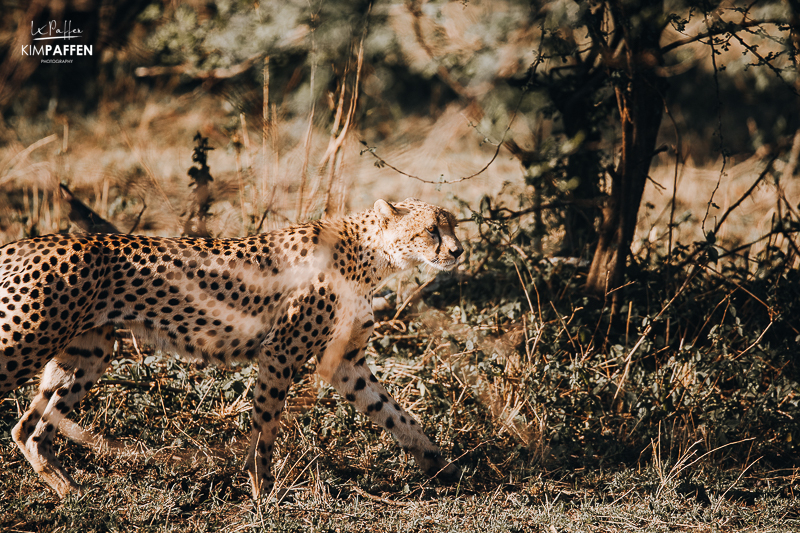
Is a safari in Serengeti worth it?
A safari in Serengeti is definitely worth it. Serengeti National Park is one of the most famous and spectacular wildlife reserves in the world , renowned for its abundant wildlife, stunning landscapes, and unique cultural experiences. Visitors can witness the Great Wildebeest Migration , which is one of the most incredible wildlife spectacles on earth, where millions of wildebeest, zebras, and other grazers move across the Serengeti ecosystem in search of fresh grass and water.
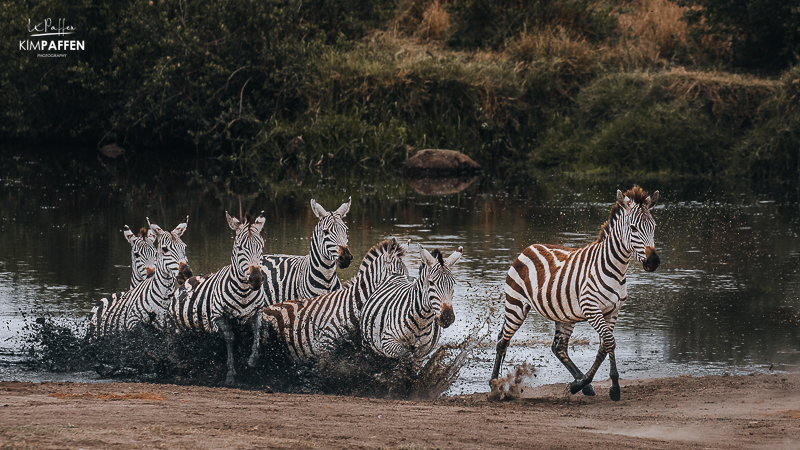
Serengeti offers an opportunity to see a diverse range of wildlife including lions, leopards, cheetahs, elephants, giraffes, hyenas, and many more. The park also has a rich cultural heritage , with the Maasai people living in and around the park and offering visitors an opportunity to experience their unique way of life.
Whether you go for a luxury family safari, a solo trip, or a customized tour, a Serengeti safari won’t disappoint you.
Looking for more Tanzania inspiration? Check my Serengeti travel guide to read about the top safari destinations in Tanzania like the Ngorongoro Crater, and the tallest mountain in Africa; Mount Kilimanjaro, and more featured Safari Tips for Tanzania.
Serengeti Safari in Tanzania
Feel free to contact me if you have questions about a safari in Tanzania or getting around in the Serengeti National Park. If you are planning your first-ever safari, it might be useful to read the following articles:
- Tanzania Northern Circuit: 10 best places to visit
- What to expect on a hot-air balloon safari in Serengeti?
- What to expect on a game drive in Africa? 15 things you need to know
- 7 tips to make the most out of your safari game drive
- What to pack for a safari in Africa? Use this Safari Packing Guide
I hope this article was helpful for you to plan your Serengeti safari itinerary. If so, I would be extremely thankful if you'd share this blog on social media and leave a comment below.
Pin this guide to a Serengeti Safari in Tanzania for later use!

- Search Please fill out this field.
- Newsletters
- Destinations
- Africa & Middle East
Serengeti National Park, Tanzania: The Complete Guide
:max_bytes(150000):strip_icc():format(webp)/DSC00412-5b73daf7c9e77c0057ca2198.jpg)
Things to Do
The great migration, where to stay, accessibility, how to get there, tips for your visit.
TripSavvy / Felicia Martinez
Named for the Maasai word siringet, which translates roughly as “the place where the land runs on forever,” Serengeti National Park is among the oldest game reserves in Tanzania . It’s also one of the most iconic safari destinations in Africa. Located in the north of the country, it partly adjoins the Kenyan border and together with the Masai Mara National Reserve provides the backdrop for the annual Great Migration —considered by many to be the planet’s most impressive natural event. The park covers over 5,700 square miles (14,700 square kilometers), including vast expanses of grassland plains and tangled riverine forest.
For more than 200 years, the Serengeti ecosystem provided fertile grazing land for nomadic Maasai tribes. The first Europeans visited the area in 1892, and thereafter it became a popular haunt for big game hunters. In 1921, the colonial British administration addressed the decline in the Serengeti’s lion population by forming a partial reserve in the area. This was converted into a full reserve eight years later and eventually established as the Serengeti National Park in 1951. The colonial government evicted Maasai living within the park’s borders in 1959, two years before the country gained independence from the British. In 1981, Serengeti National Park was inscribed as a UNESCO World Heritage Site in recognition of its incredible ecological importance.
Traditionally, the park is divided into three distinct geographic regions. The largest of these is the southern Serengeti plains—an iconic, largely treeless savannah landscape that serves as a breeding ground for the wildebeest and antelope that congregate here from December to May before beginning their migration north. The Western Corridor includes the Grumeti River and its adjacent forests. Visitors flock to this area of the park from May to July when the wildebeest migration passes through, but it’s also a great place to spot water birds and other aquatic species all year round. Finally, the remote northern Serengeti woodlands are the best place to spot elephants and giraffes, and to observe the spectacle of the migration’s Mara River crossings.
A traditional jeep safari is just one of several wildlife viewing experiences offered by lodges in and around the Serengeti. Although night safaris are banned within the park itself, many operators offer after-dark game drives in the private concessions of the greater Serengeti ecosystem. These are the only way to see the region’s fascinating nocturnal wildlife. Other exciting options include walking safaris, horseback safaris, and charter flight safaris. There is even a sunrise hot air balloon safari —a very expensive and exclusive experience that will stay with you long after you return home.
In the unlikely event that you tire of wildlife spotting, you can also take part in a cultural visit to one of the Maasai villages located just outside the park boundaries; or drive south to the archaeological site at Olduvai Gorge . Here, a small museum gives you an insight into the life’s work of Louis and Mary Leakey, whose anthropological discoveries both at Olduvai and nearby Laetoli inform our understanding of human evolution.
Read more about the best things to do in Tanzania .
Serengeti National Park is home to the greatest concentration of plains game in Africa. This includes approximately 2 million wildebeest, 900,000 Thomson's gazelles, and 300,000 zebra. Other antelope species range from the abundant Grant’s gazelle and Coke’s hartebeest to rarer creatures like the dik-dik and the roan antelope. This proliferation of prey animals inevitably results in healthy predator numbers. Indeed, the Serengeti boasts Africa’s largest population of lions and is one of the best places in the world to spot the elusive leopard. Here, it’s also possible to see cheetahs , two species of hyena, and the endangered African wild dog. Smaller felines and nocturnal animals like the aardwolf and ground pangolin come out at night.
It is possible to see all of the Big Five in the Serengeti, although the small reintroduced population of black rhino is exceptionally difficult to spot. The June to October dry season is the best for general game viewing, as the foliage is less dense and animals congregate at the waterholes, making them easier to spot.
Those with a passion for birdwatching will feel right at home in the Serengeti, which boasts no fewer than 500 resident and migratory bird species. Five of these are endemic to Tanzania, including the grey-breasted spurfowl, the Rufous-tailed weaver, and the gorgeously colorful Fischer’s lovebird. Near-endemic specials like the Usambiro barbet and the Hildebrandt’s starling also deserve a place on your Serengeti wish list.
The park provides a refuge for several species of endangered or critically endangered vulture and has the highest ostrich population in Africa. It’s also home to the continent’s largest flying bird, the kori bustard. The November to April rainy season is best for birding because resident birds are in breeding plumage and migrant species arrive at this time from North Africa and Europe.
For many, the Serengeti’s No. 1 attraction is the opportunity to witness the Great Migration. Many safari operators and mobile camps are dedicated to putting you at the heart of the action; whether that’s watching newborn calves take their first steps in the grasslands of the south, or experiencing the drama of a Mara River crossing. To view the migration, you’ll need to time your trip carefully, as the herds’ movements are dependent on the rains and can change from year to year. Regardless of when you travel, a standard game drive gives you a front-row seat to the Serengeti’s incredible biodiversity.
However, if you want to see the wildebeest migration, the herds gather in the south from December to May, then move into the Western Corridor from May to July. To see the herds crossing the Mara River, you’ll need to be there in July, August, or November.
Read more about how to experience the Great Migration in Kenya and Tanzania .
Serengeti National Park is famous for its five-star camps and lodges that are notoriously expensive. Among the park's options to choose from. Permanent tented camps combine the romance of staying under canvas with the decadence of formal furniture, staff, and gourmet dining, while mobile tented camps follow the migration, making sure that you’re always at the heart of the action.
- Four Seasons Safari Lodge Serengeti : Offering a high caliber of luxury, the Four Seasons offers beautiful suites and villas and is located next to a watering hole that is frequently visited by animals.
- Mbalageti Safari Camp : This highly-rated camp provides 360-degree views of the plains and the Serengeti River and a variety of suites that can accommodate families.
- Kirawira Serena Camp : Inspired by historic hunting camps, this luxury hotel has 25 tented suites and provides five-course lunches and dinners.
- &Beyond Serengeti Under Canvas : This roaming camp follows the Great Migration, operating multiple private campsites in key locations where accommodations have been preassembled.
For those on a tight budget, the only relatively affordable option is the park’s public campsites. Amenities are basic, and you’ll need to be entirely self-sufficient, bringing with you your own food, water, and cooking equipment. You’re likely to share the space with overland tour groups , which can be a pro or a con depending on how much you value peace and quiet.
Read more about the different accommodation types in the Serengeti .
While the park does not have much in the way of accessible trails, the majority of the safari experience can be done from inside a vehicle. Some, but not all, tour operators can accommodate travelers with disabilities and the same goes for lodges. However, there are not a lot of accessible vehicles and in most cases, wheelchair users will need to be physically lifted into the car. Look for tour agencies like Responsible Travel or GoAfrica that can help make arrangements to accommodate your needs. Other travel agencies like Explore Africa Safaris can also help you find a sign language interpreter or guide.
Dasar / Getty Images
Those that travel to Serengeti National Park by road will most likely enter through the Naabi Hill Gate in the southeastern section of the park. The gate is a 2.5-hour drive from Ngorongoro Conservation Area and a seven to eight-hour drive from northern Tanzania’s safari capital, Arusha. Some companies will arrange road transfers from Arusha, while others pick you up from one of several airstrips located within the park: Kusini and Ndutu in the south; Seronera in the center; Lobo, Kleins, and Kogatende in the north; and Grumeti or Sasakwa in the Western Corridor. These small airstrips are served by charter flights from Arusha or Kilimanjaro.
Read more about how to travel between the Masai Mara and the Serengeti .
- If you'll be in the southern part of the park, winter is the best time to see the Great Migration. In the northern and western regions of the park, summer and fall are the best times to go.
- If you plan to travel during the heavy rains of April and May, be aware that some lodges and roads may be closed and mosquitoes are at their worst.
- A visit to the Serengeti is also a good opportunity to visit the Ngorongoro Crater 41 miles (66 kilometers) away.
- Although it is possible to visit the park and stay overnight in a private campsite independently, the safest option is to travel with an experienced guide.
- Book far in advance if you plan to visit during the Great Migration, as this is the park's busiest time and safari camps are quick to fill up.
- During the game drives, you will spend a lot of time in the sun so make sure to pack sunscreen with a high SPF and a wide-brimmed hat.
Related Articles
More related articles.
Serengeti safari prices and cost factors
Renowned as a luxury safari destination, the Serengeti National Park in Tanzania offers prime game viewing with the incredible Great Migration of millions of wildebeest, stunning scenery and beautiful beaches, reflected in the excellent safari experience visitors have come to expect.
Correspondingly, safari prices tend to be higher here compared to other African nations. Visitors often wonder about the approximate cost of Serengeti and if affordable safari packages are possible.
Below, we have listed the various elements that impact Serengeti safari costs and detailed the price averages for each.
Table of Contents
Elements that influence Serengeti safari tours price
The flight to tanzania.
There is no direct flight between Tanzania and most countries. Therefore a stopover in Cape Town, South Africa may be required before reaching Dar es Salaam, the main Tanzania tourist hub on the east coast.
Due to this stopover, flights to Tanzania tend to be more expensive than other destinations offering direct flights to other African safari destinations.
The prices of flights from the U.K. or U.S. can vary according to the dates of the stay and the chosen airline.
Several transport options are available in Tanzania but not all offer the same experience and speed of connection visitors want when travelling between parks and reserves.
Intercontinental flights
Arriving into Tanzania will typically involve taking a connecting flight from Dubai, Amsterdam or Johannesburg, South Africa, adding to the overall cost of a safari, the cost of which will vary depending on time of year and the flight distance.
International flights into the country also arrive via Dar es Salaam (DAR) airport for visitors wondering how to get to Tanzania . DAR airport is located 18km south of Dar Es Salaam and a Tanzania visa .

Local transport
Due to this, private charter flights are commonly used to quickly access isolated private reserves and concessions, sometimes the only way to access them.
Others choose to go on self drive safaris and rent their own cars/4×4’s and use the roads of the national parks. This is a more affordable option and offers visitors the comfort of staying as long as they wish in each location.
Flights from Serengeti to Dar es Salaam
Flights can start from USD $300, flying from Dar es Salaam Serengeti (DAR) airport to Seronera (SEU), a distance of approximately 690 km taking 2 hours and 20 minutes.
Accommodation
The quality of accommodation options available in the Serengeti is generally quite high. There are many luxurious lodges available, some of which can only be accessed by plane transfer however, thus adding to the costs.
More budget friendly accommodation options include camping options, of which many parks have at least 1-2 designated areas.
Most lodges will typically have some or all of breakfast, lunch and dinner options included in the overall lodge safari package.
Parks entrance fee
National parks and reserves charge park fees per person including entrance fees for guides, as well as vehicle entry fees. Entrance fees for the Serengeti include:
- Adults $60: USD
- Children (5-16 years): $30 USD
- Children below 5 years of age: Free
The cost of the entrance fee may be included in your lodge or camp overall price.
Many visitors will also be interested in other activities beyond the main safari and wildlife excursions including walking safaris, mountain biking on Ngorongoro or quad biking adventures, all of which add to overall costs. Comparable to Europe, these prices are lower.
A Serengeti balloon flight costs US$599 per person (this includes the Tanapa ballooning fee of US$40).
This rate includes a transfer from your lodge or camp to the departure balloon site, the balloon flight itself, and a champagne breakfast (after landing). The flight will last between 50 and 70 minutes.
There are multiple activities and things to do in Tanzania that can be added to your safari including walking safaris .
Travel Insurance
Safari trips can result in unfortunate events happening, like contracting an illness from contaminated water or falling ill from a mosquito bite.
Visitors may need medical attention while abroad so it’s important to ensure an adequate travel insurance policy is in place which will cover you in the event of an accident or injury.
Visitors should check to see if they have already through their credit card company and workplace benefits. If not, it is recommended to ensure travel insurance is purchased prior to travel to cover:
- Medical expenses and hospital benefit
- Personal accident and liability
- Cancelling and cutting short your holiday
- Covid-19 specific cover
- Abandoning your trip
- Delayed departures
- Accommodation cover
- Personal belongings and baggage
- Personal money, passport and travel documents
- Legal expenses
Vaccinations
Tanzania vaccines are another expense which may need to be taken into consideration prior to the safari trip, especially if visitors are planning to visit the north of Tanzania, an area with an increased risk of malaria.
Visitors are recommended to consult with their local doctor before arrival and consider antimalarial prophylaxis as recommended.
Other expenses
Gasoline, tips, souvenirs can also impact a visitors budget.
Budgeting for a trip to the Serengeti
Transportation.
For a flight to Serengeti from the U.K, it will cost around £800/$1,060 per person, and more from the U.S. Prices can change and are certain to increase during the summer months.
If on a budget, visitors can save two thirds of their daily expenses on transport costs by opting for a car/4×4 rental compared to plane transfers.
Car rental costs start from £90/$115 for a package with basic insurance. Tanzania safari prices increase if visitors book a 4×4 safari vehicle or campervan.
Guests staying at lodges should note the lodges will likely pick up guests and drive them to the lodge, with prices often included in the accommodation.
Accommodation and food
This will vary significantly depending on the type of accommodation selected. Guests can budget £15/$20 a night and upwards for one night camping and can purchase groceries at local supermarkets.
For lodges, nightly rates will cost several hundred dollars, typically with meals included.
Is a cheap Serengeti safari possible?
Safari prices in the Serengeti are expensive in general, especially for accommodation. However, visitors can be smart and take measures to keep their bank balance in check including:
- DIY organize your own safari
- Sleeping in a campervan/van with a rooftop tent
- Drive yourself around the country
- Prepare your meals and limit eating out at restaurants
- Limit your activities other than the main safari excursions
Travel seasons
Visitors looking to avail of a cheap Serengeti safari on a lower budget should travel in the low season which is December to March. This time of year however is also unfortunately a period of hot, muggy weather.
April and May (northern circuit parks still get quite a few visitors unlike the southern and western circuit parks, where many lodges close down). June and July are the best months to see the wildebeest migration.
May is still mid-season and will allow for cooler weather at still reasonable rates.
- Visitors planning an 8 night stay during Peak Season (July – Oct) in a premier camp can expect to pay around $9,000 to $10,000 per person
- Visitors planning an 8 night stay during Off-Peak Season (Sep – Dec) in a moderate camp can expect to pay around $5,500 per person
Affordable lodging options
If budget is the primary concern, and visitors don’t mind camping, then there are some overland camping trips (called mobile safaris) available as well as budget Serengeti safari packages.
Excluding international flights and plane transfers:
- Visitors planning a 6 night safari staying at two different tented camps can expect to pay around $3,600 – $4,300 per person
- Visitors planning a similar 6 night mobile camping safari can expect to pay around $2,200 per person, prices can vary
Affordable Serengeti safari packages tend to be for longer safaris (7+ nights) whilst higher cost safaris are typical of a shorter 3 or 4 night safari.
Serengeti safari approximate costs
The cost of a trip to the Serengeti can start from around US$140 per day for an all-inclusive package, including shuttle service to and from the Delta, accommodation, game viewing and meals.
Visitors can spend much more than this with customised trips and add-ons such as trips to Ngorongoro Crater, Selous Game Reserve and neighbouring Kenya.
Note that off season rates from January to March are usually much lower than normal, with both mid and high-end lodges knocking as much as 50% off.
Summary: The average price of a safari in the Serengeti
Estimating the cost of an average safari isn’t straight forward, given the range of factors noted above that can impact prices. However, two examples are provided below to give visitors an idea of average costs to expect.
Affordable Serengeti safari prices
The cost of an affordable safari in Tanzania includes:
- International flights
- 4 × 4 rental with a tent on the roof
- Campsite accommodation
- Parks entry for game drives
Based on the above, we can estimate prices of at least £340/$450 per person based upon a 10 day stay.
Luxury Serengeti safari prices:
The cost of a luxury safari in Tanzania includes
- International flights and transfers
- Transfers by plane and/or private drive
- Lodge accommodation
- Guided game drives
Based on the above, we can estimate costs of at least £940/$1240 per person based upon a 10 day stay.
This trip includes visiting the Serengeti National Park, Ngorongoro Crater, Selous Game Reserve during peak season. Prices are indicative only and may vary depending on travel conditions.
The following is a pricing summary of the main costs a safari visitor in the Serengeti can expect:
How much does a safari cost in the Serengeti?
The Serengeti is one of the premier African safari destinations with the accompanying price tags, however it is possible to go on a safari budget friendly trip to the Serengeti. Average prices are difficult to calculate given the various elements of the trip to take into account.
Are credit cards and debit cards accepted in the Serengeti?
All major forms of credit card are accepted in East Africa, although it is best to travel with either Mastercard or Visa as these are accepted most widely. Amex can be useful to withdraw dollars from banks in the major cities including Dar es Salaam and Arusha.
When to go on a safari in the Serengeti?
Overall, June to October is the best time to visit the Serengeti during the dry season for a safari trip to any of the national parks.
Wanderlust Travel & Photos
Seeing the world one trip at a time.
- Work With Me
- Travel Journal
- Privacy Policy
- Browse by Continent
- South Africa Travel
- Tanzania Travel
- Thailand Travel
- Dominican Republic Travel
- Italy Travel
- Spain Travel
- Canada Travel
- Australia Travel
- New Zealand Travel
- Peru Travel
- Browse by Region
- East North Central
- East South Central
- Mid-Atlantic
- New England
- South Atlantic
- West North Central
- West South Central
- Central America
- North America
- South America
- Travel Vlog
- Instagram Photos
The Ultimate Serengeti National Park Safari Guide
LAST UPDATED: 7/24/24 – Serengeti National Park Safari Guide
The Serengeti National Park in Tanzania is one of the most famous wildlife habitats in the world. This large park in Northern Tanzania, along with its sister park (the Masai Mara) in Kenya, plays a pivotal role in the great wildebeest migration.
This great migration, which also features zebra, gazelle, and other grazing animals, brings over two million grass feeders through the parks as they follow the rains each year. It is quite an unbelievable spectacle to behold while on a Serengeti National Park safari.
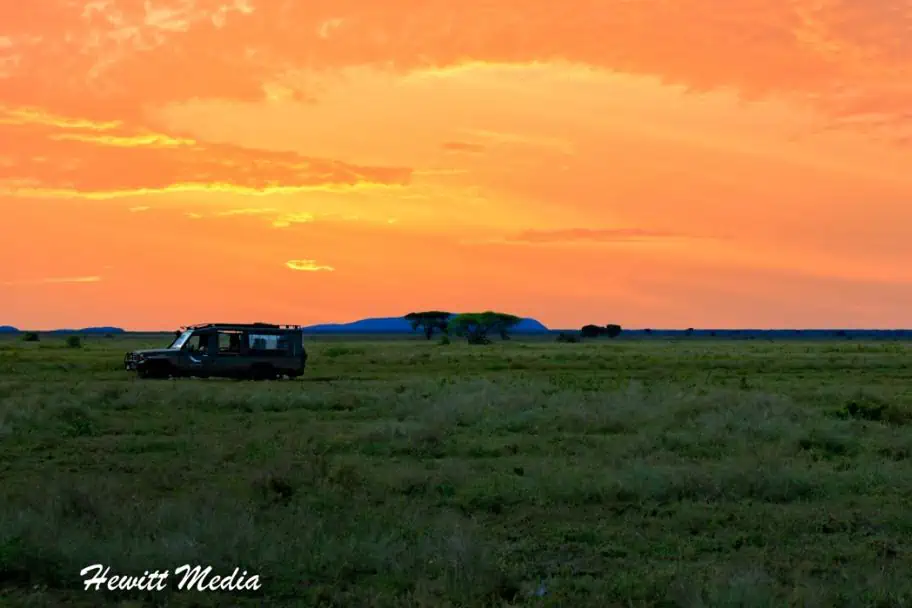
The Great Migration is a Must-See Wildlife Event
It is because of this migration, and its sheer volume of migrating animals, that the Serengeti National Park in Tanzania has become so famous. The park provides visitors with a front-row seat to see the migration and all of the drama that unfolds with it.
These migrating wildebeest, zebra, gazelle, and other animals have to cross rivers that are infested with large Nile Crocodiles, navigate savannas that are teaming with ambushing lions and leopards, outmaneuver aggressive clans of Spotted Hyenas, and outpace the lightning-fast cheetahs that hunt on the open plains of the parks. All are in search of fresh grass that sprouts after the rainstorms that they instinctively follow.
This is what makes going on a Serengeti National Park safari so special, and why it is a place that I will never forget. In few other places in this world can you see nature at its most beautiful, and at its most cruel. The sheer number of animals that live in and migrate through the park gives visitors an almost unprecedented opportunity to see the wildlife they came to see.
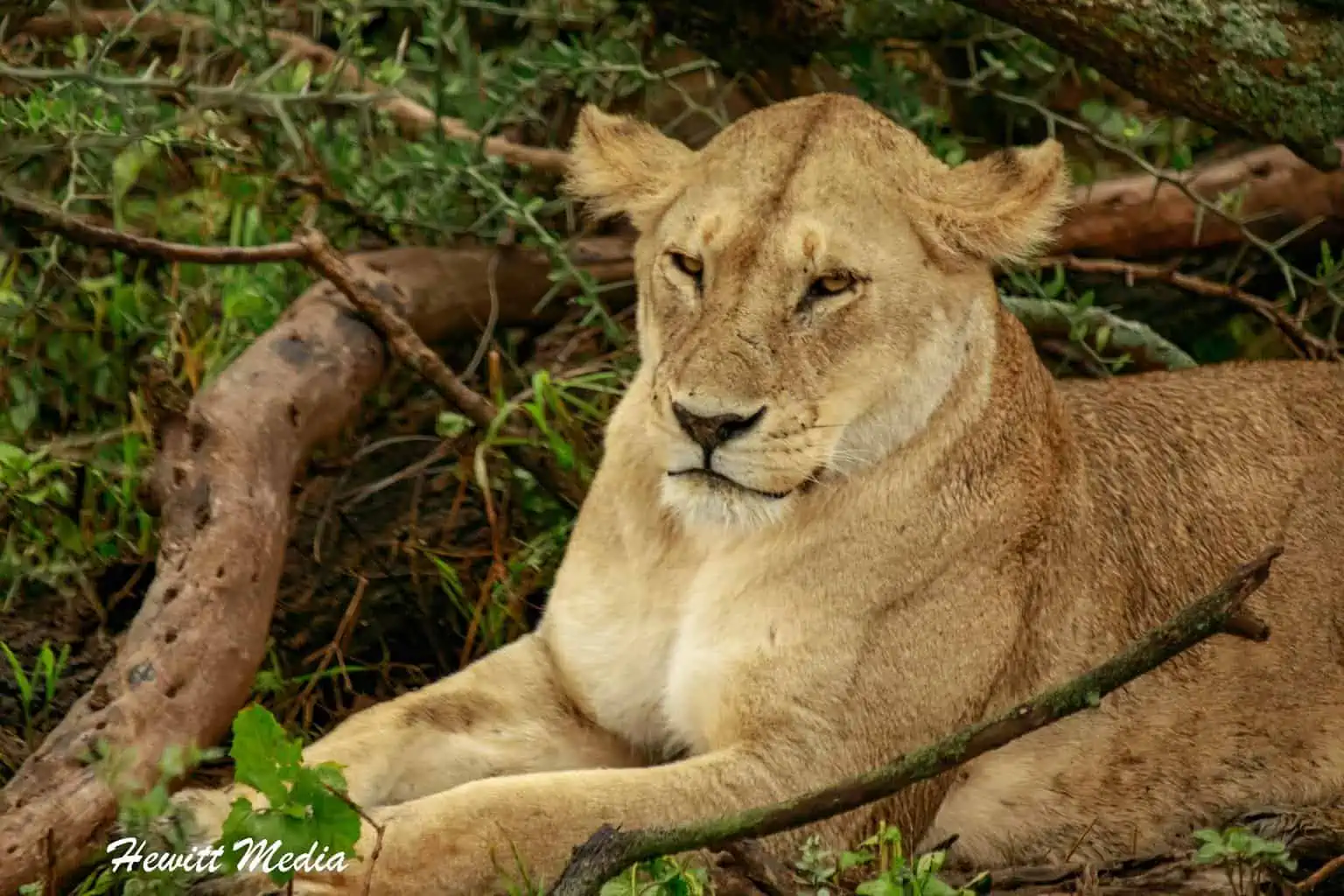
See the “Big Five” of Africa
In our short, two-day Serengeti National Park safari, we were able to see both a mother lioness protecting her newborn baby cubs in a thicket, as well as the rest of her pride feasting on a fresh wildebeest kill that they had made. These experiences are what make the Serengeti National Park such an amazing wildlife destination.
If you are looking for a great place to go on a safari in Africa, then your search should start with the Serengeti National Park in Tanzania and the Masai Mara in Kenya. These parks provide visitors with the ability to see the “Big Five” animals of Africa (lions, elephants, buffalo, rhinoceros, and leopards), as well as a plethora of other amazing wildlife. And if you plan your visit right, you might get to see the great migration unfold in this amazing place!
Serengeti National Park Guide Navigation Menu
Tanzania entrance requirements.
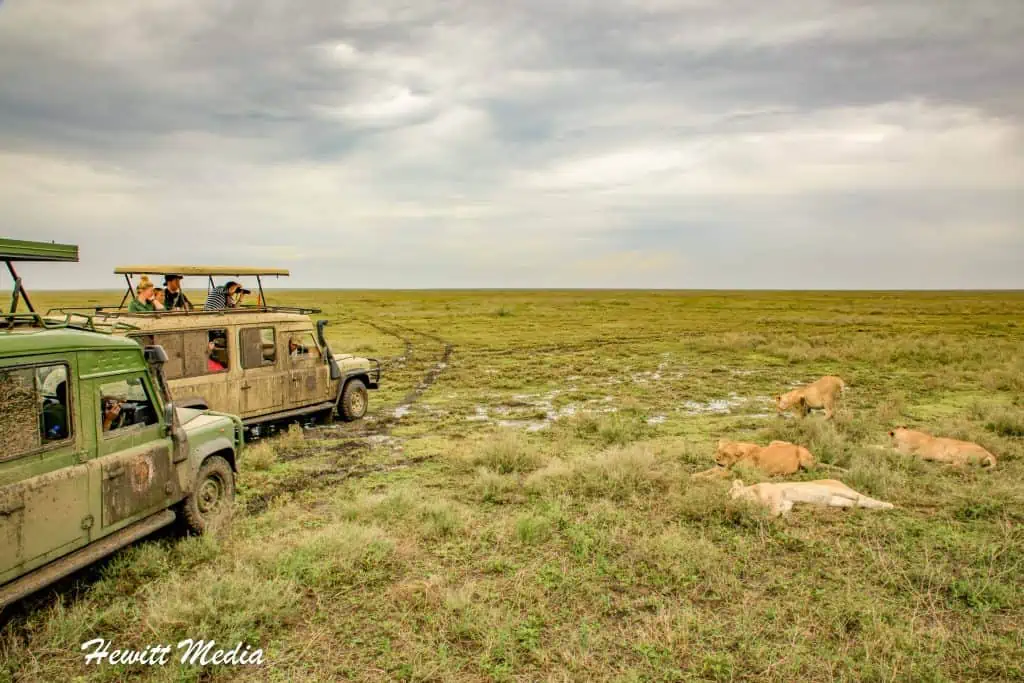
Before you can even start to think about your Serengeti National Park safari, you need to make sure that you can meet the Tanzania entrance requirements.
If you don’t meet the requirements, you will not be allowed entry into the country. This will put a huge damper on your safari plans. To assist you in ensuring you meet the requirements, I have linked to my Tanzania Entrance Requirements guide for you to review below.
Tanzania Travel Immunizations

Before you leave for your trip to Tanzania to go on your Serengeti National Park safari, you need to make sure you have all of the proper vaccinations. Not only to protect yourself but to protect others. In fact, depending on where you are visiting from and whether you are making any stops before visiting Tanzania, you might not even be allowed in the country without the proper vaccinations.
Travel Vaccination Advice
You may have questions on what immunizations you will need and what to look out for when you go to get them. In this case, I have linked to my Tanzania Entrance Requirements guide for you to review below. In this guide, I outline the various vaccinations and precautions you can take while visiting Tanzania to stay healthy.
What to Bring to the Serengeti
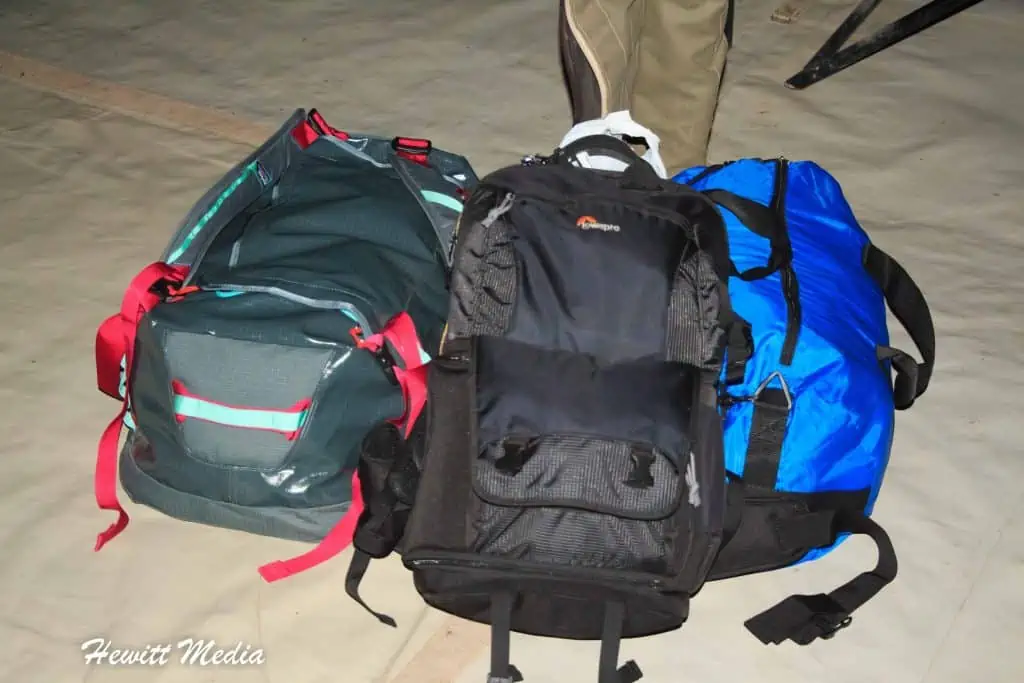
If you are going on safari for the first time, you might not know what to bring with you. To help prepare for your Serengeti National Park safari, I have developed several guides that you should review.
What to Expect When Visiting Africa for the First Time
First, my article on the “20 Tips for Those Visiting Africa for the First Time” will help get you prepared. The article outlines what you can expect when you visit Africa for the first time. It outlines what you should and should not do while visiting. It also gives you some tips on what to expect during your first visit to Africa.
Then, as you prepare for your trip, you will want to review my “Essential Safari Packing List”. This guide will ensure that you have all the gear you need for your safari. It also outlines what you should not bring with you.
Finally, my last article covers taking pictures while on safari. My “Tips for Photography on African Safaris” guide will help you take the best possible photos of your epic adventure. Not only does it include photography gear I recommend, but it also covers my recommended camera settings.
Getting to the Serengeti National Park
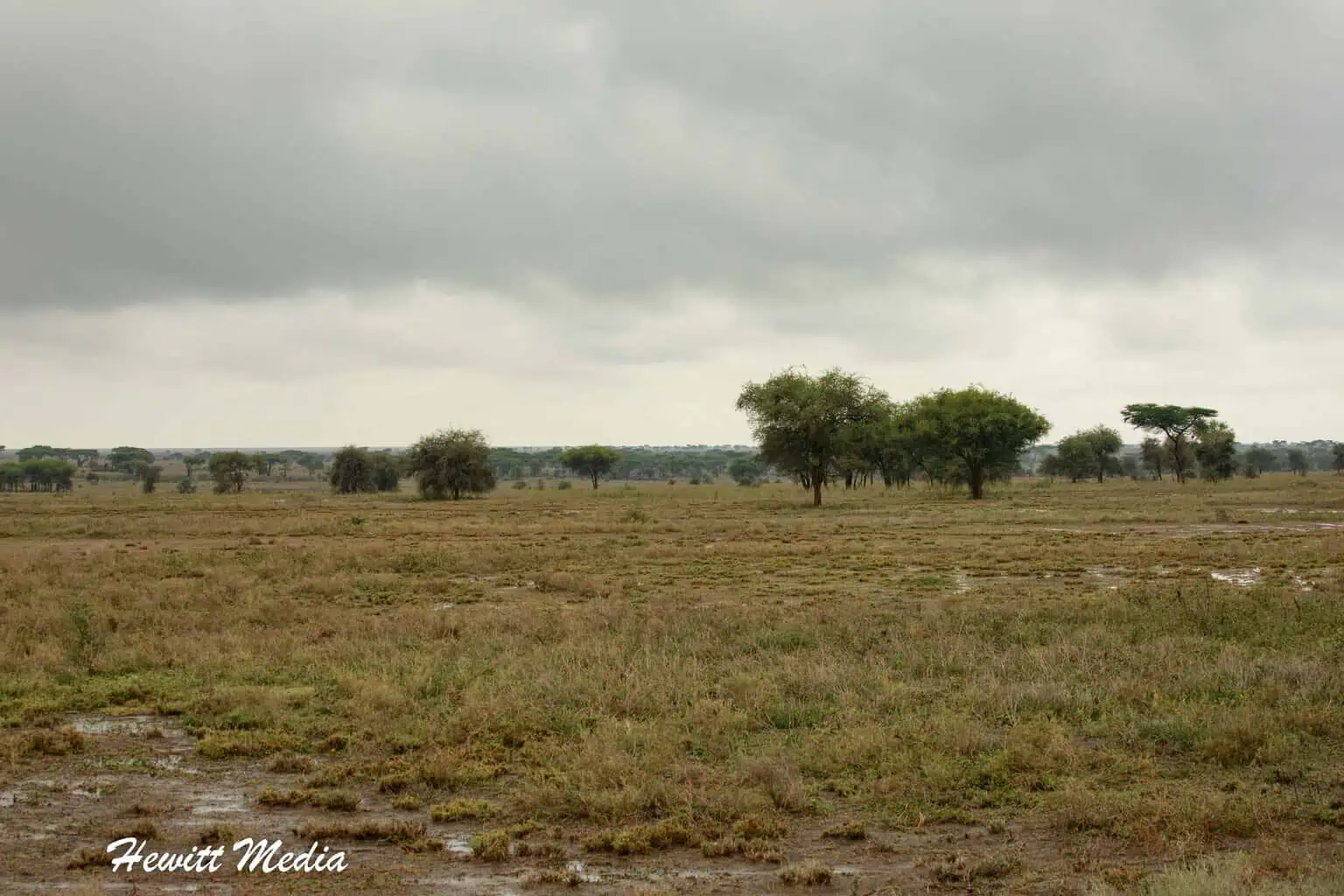
The Serengeti National Park is located in Northern Tanzania, right on the border with Kenya. In fact, the Serengeti National Park continues into Kenya, where it becomes the Masai Mara National Reserve. The huge area created by these parks, along with the Ngorongoro National Conservation Area that joins to the East of the Serengeti, makes it one of the largest wildlife conservation areas in the world.
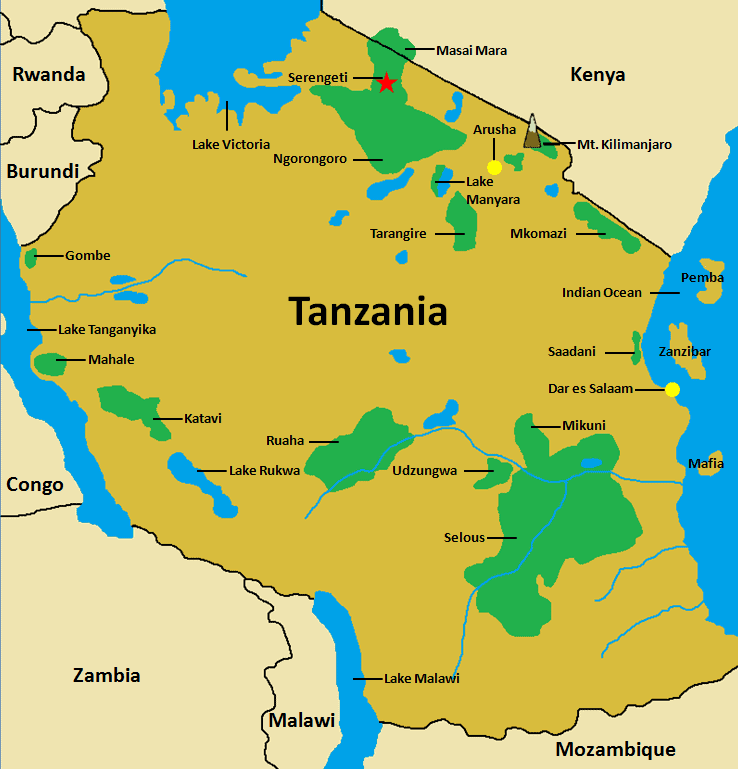
If you are planning on a safari trip to Tanzania and Kenya, there are other parks that we would recommend in addition to the Serengeti and Masai Mara.
The Ngorongoro Crater
The Ngorongoro Crater, which we wrote about previously, is one of the most unique wildlife areas in the world because it is an enclosed, protected wildlife sanctuary that is located in the crater of an extinct volcano.
Wildlife in the crater doesn’t migrate because there is water in the crater year-round, so it affords visitors some of the most predictable wildlife viewing experiences of any wildlife area in the world.
Lake Manyara National Park
In addition to the Ngorongoro Crater, the Lake Manyara National Park is a unique and incredible wildlife park because of its abundance of animals and its unique tree-climbing lions.
It is a park that we visited during our trip, and we absolutely loved it. There are also the Tarangire, Arusha, and Mount Kilimanjaro National Parks in the area that are absolutely worth exploring.
Depending on the length of your stay, you can combine many of these parks into a single safari vacation and get to see many of the beautiful wildlife areas in Tanzania and Kenya.
Recommended Serengeti Tours
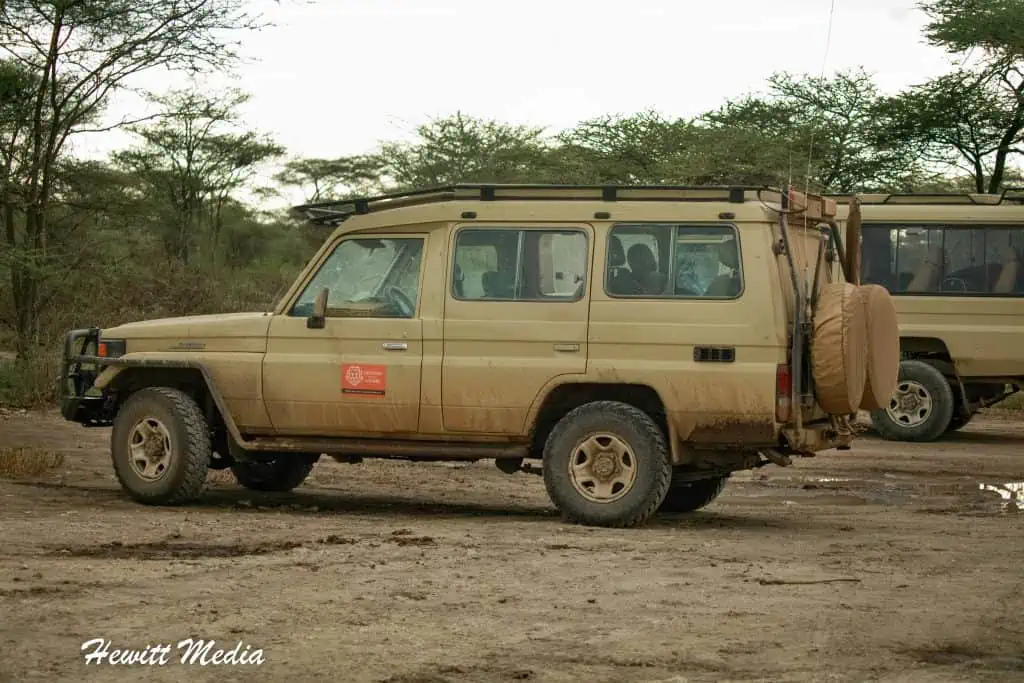
We used Tanzania Choice Safaris for our safari, and we absolutely loved them. We have relatives who lived in the country and had used them on multiple occasions and had a lot of really great things to say about them.
They were very courteous, well-organized, and extremely knowledgeable about the parks and the wildlife. We would absolutely recommend them to anyone considering a safari in any of the national parks in Tanzania. If you are looking for a safari tour of the Serengeti National Park, here are some good ones I can recommend:
My Top Recommendation
Best time to visit the serengeti.

Before you decide when to take your Serengeti National Park safari, I would suggest thinking about when you want to go. There is never really a bad time to visit the Serengeti. However, depending on what you want to see, some months are better than others. The information in this section of my guide will give you all the information you need to make this decision.
Average Temperature (℉)
The climate around the Serengeti National Park is typically very moderate and pleasant throughout the year. It never gets scorching hot like it does in Botswana and Zimbabwe, but it does get hot.
In the mornings and evenings, it is consistently cold throughout the year. You will need to bring a jacket with you for early morning game drives and evenings. The good news is, that Tanzania uses closed safari vehicles, so the morning game drives won’t be that cold.
Average Precipitation (Inches)
The dry season in the Serengeti is from June until October. Most people believe there is only one wet season, but there are actually two. There are short rains from November until December.
Then, the long rains last from March until May. This is what most people refer to as Tanzania’s wet season. During the wet season, you’ll rarely see it rain all day long. However, you will consistently see afternoon rain showers.
Best Months of the Year to Visit
What the “best” months of the year to visit will largely depend on what you want to see. For instance, do you want to see the wildebeest migration at its height? Or, are you more interested in seeing baby animals? Perhaps you want to see some crocodile activity at the river crossings?
These are the ultimate factors you will want to consider. However, if you ask me, some months are better than others. For information on which months of the year I think are best to visit the Serengeti, please see the chart below.
The Seasons in the Serengeti
If you are interested in seeing baby animals, the wildebeest calving season is between January and February. The period between June and September is great for general wildlife viewing and you have a great chance of seeing wildebeest and other animals do river crossings of the Grumeti River in June and July and the Mara River in September.
During the wet season, which is typical during March and April, the area can get quite a bit of rain. These are the storms that the herds of wildebeest, zebra, gazelle, and other grazing animals follow to take advantage of the fresh grass that grows after the storms. If you are looking to see the wildebeest migration at its height, visiting during June and July is your best bet.
The Great Wildebeest Migration
The wildebeest will be heading from the heart of the Serengeti on their way North towards the Masai Mara in Kenya. These months typically have the best weather as well. If you would like to understand the wildebeest migration and where the animals will typically be during certain parts of the year, I have included a map below that gives you an overview of the migration.
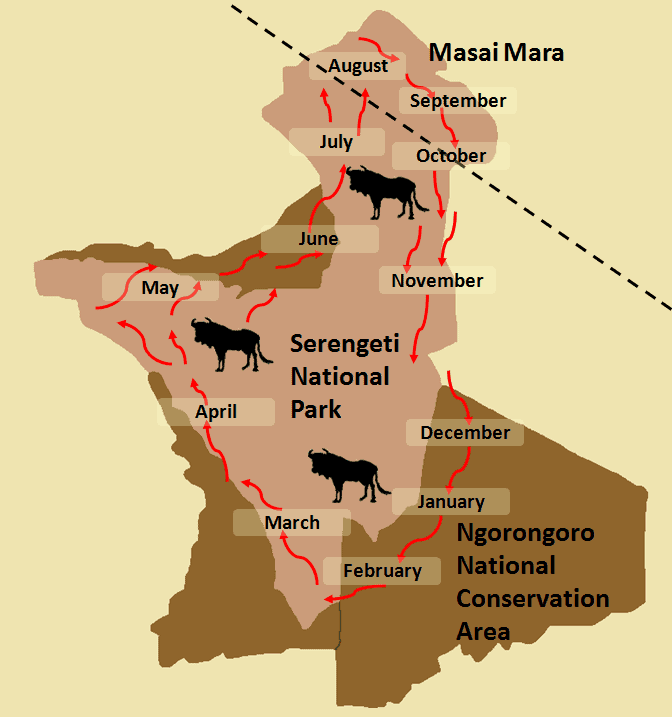
View Larger Map
June to October (The Dry Season)
- Best time to see the wildebeest migration. They tend to be in the Western part of the park between June and July and in the Northern part of the park between August and September.
- The animals are typically easier to see because the vegetation isn’t as thick, and the animals tend to gather around water sources.
- This time of year typically has the best weather.
- The park is the most crowded.
- Mornings and evenings can be quite cold because this is the wintertime in Tanzania.
November to May (The Wet Season)
- Late January into February is the best time to see baby animals as this is the wildebeest calving season. It is also a great time to see predators in action as they tend to target the young wildebeest.
- The animals can be more difficult to spot because water is plentiful, so there is no need to congregate around water sources, and the vegetation is the thickest.
- April and May are the low seasons, so the park is less crowded, and the rates are the lowest.
- Migratory birds are typically in the park, so it is the peak season for bird watching.
- March through May is the peak of the wet season, but storms typically occur in the afternoon, so there is still time to go on safari early in the day.
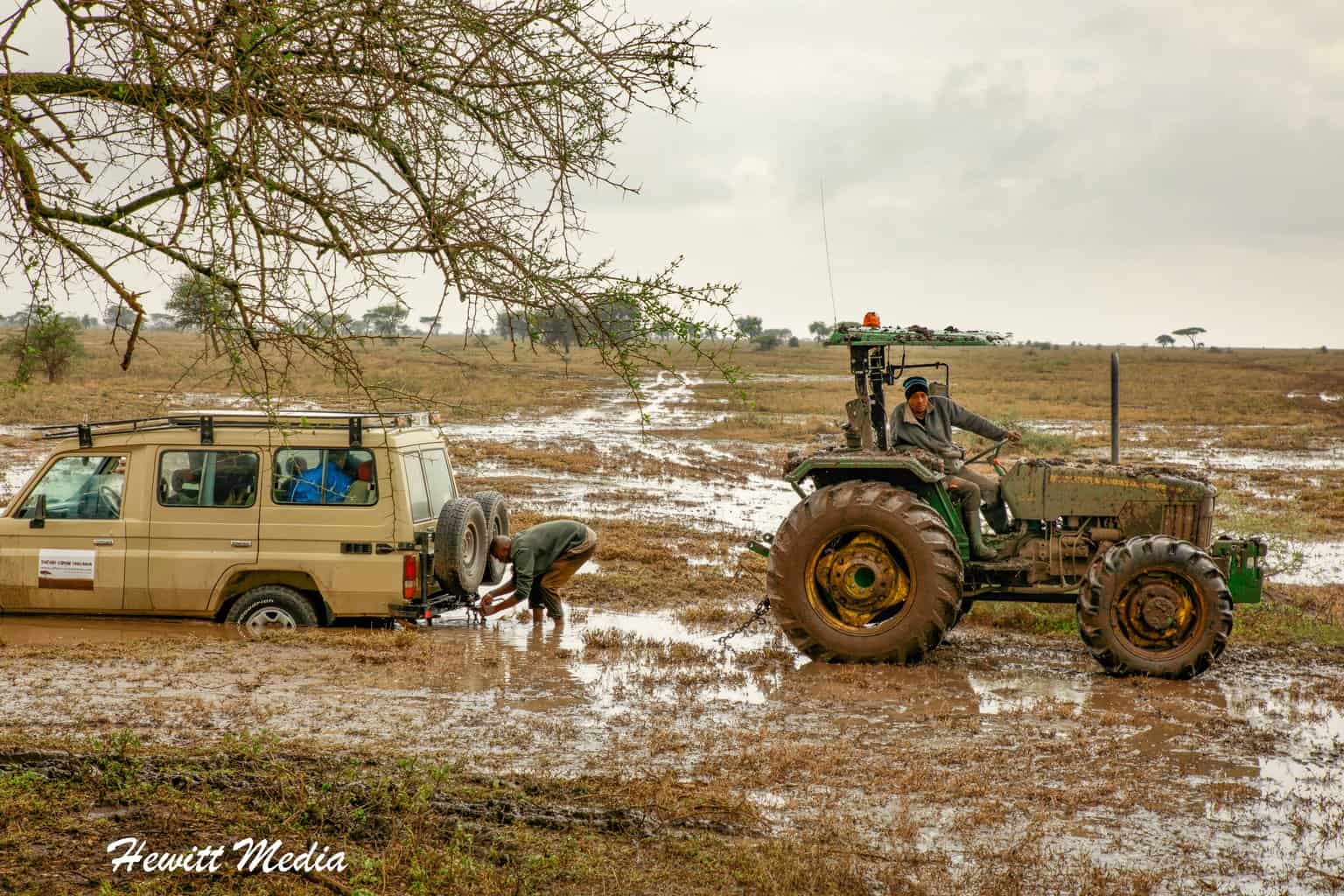
Where to Stay in the Serengeti
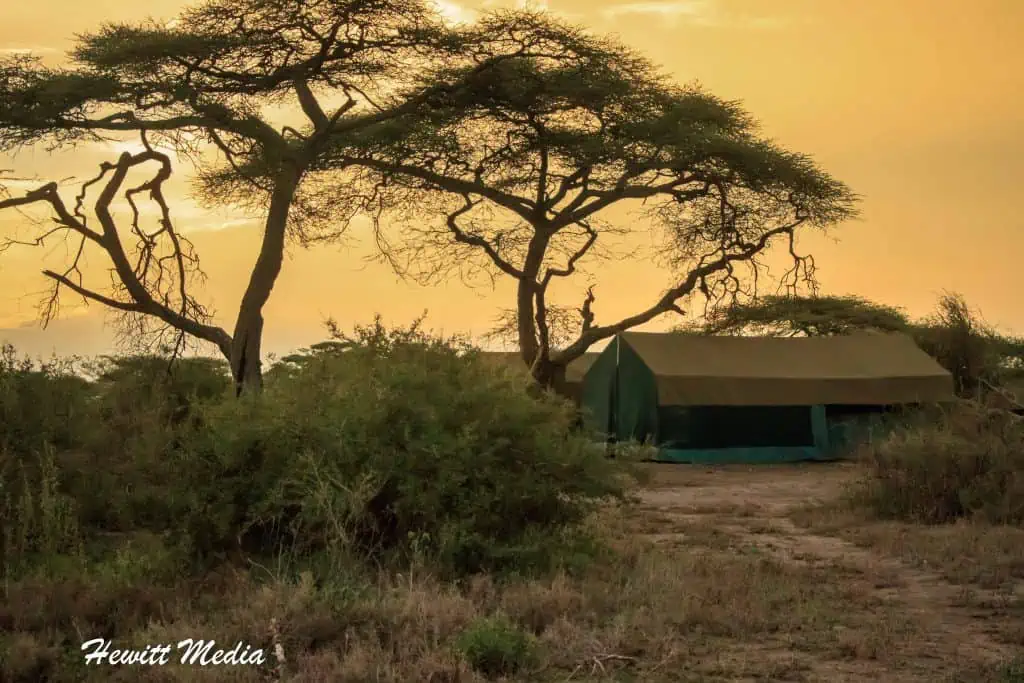
One of the most memorable experiences we had while on our Serengeti National Park safari was our experience camping in the park. If you are planning on going on a safari in Africa, I would absolutely recommend that you spend at least one-night camping.
Camping in the Serengeti is an Amazing Experience
There is absolutely no better way to get an authentic safari experience and really feel like you are part of the environment. I wrote about our night camping in the Serengeti National Park in an article that I linked below.
It was such a surreal experience to sit by the campfire, drinking a hot beverage and chatting with other like-minded adventurers, in the middle of one of this world’s most infamous wildlife sanctuaries.
Being woken in the middle of the night by a clan of hyenas passing through our camp was both thrilling and exhilarating, to say the least. If I had to point to one experience on my safari adventure in Tanzania as the most memorable, it would be the night that we camped.
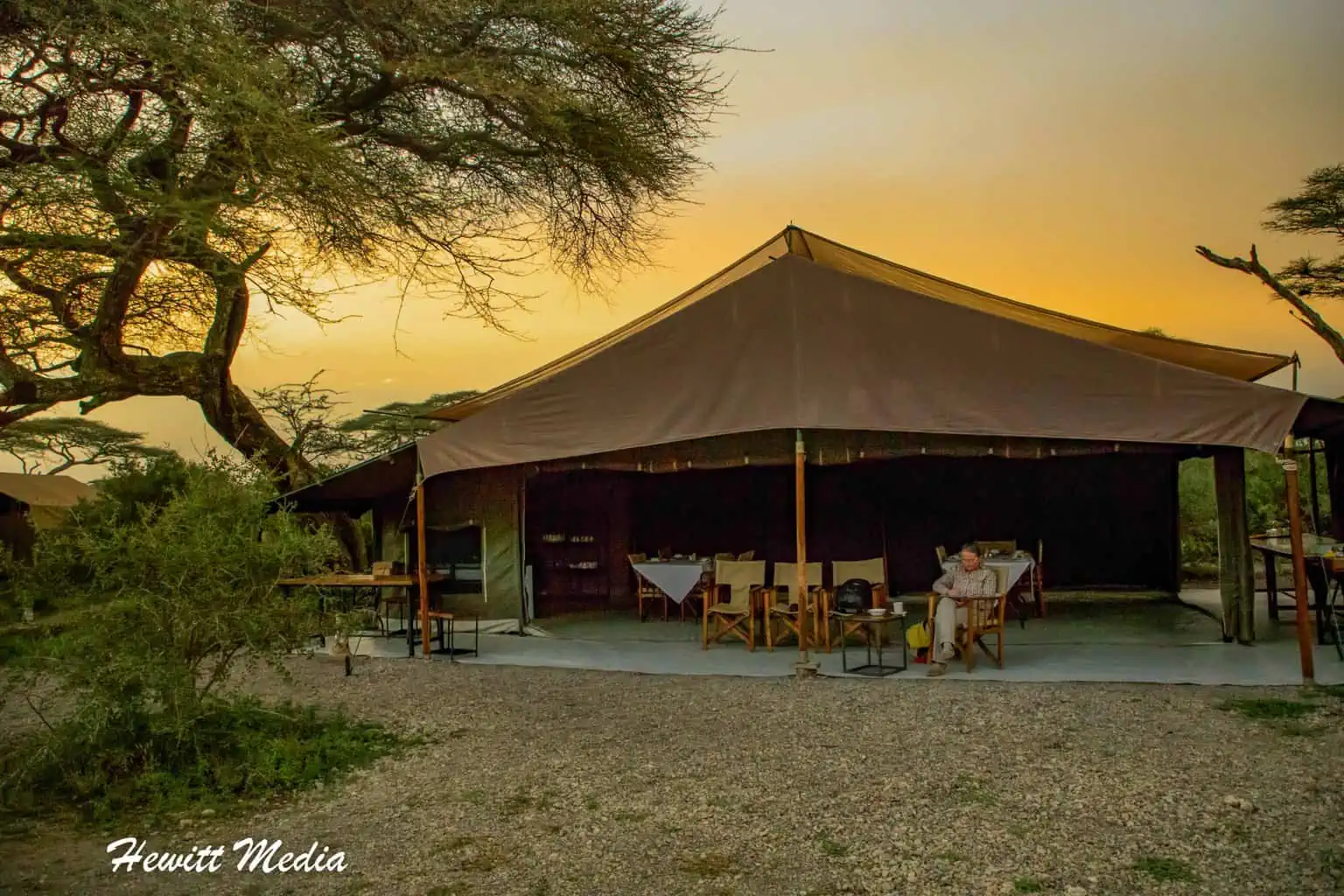
Now, before you start to worry about safety, let me assure you that the accommodations are very safe and secure. These aren’t the typical camping tents that you sleep in while on a camping trip.
These are thick canvas tents that have a bathroom and shower inside. As long as you follow the proper safety guidelines and do not leave your tent when it is dark, you are perfectly safe sleeping in these tents.
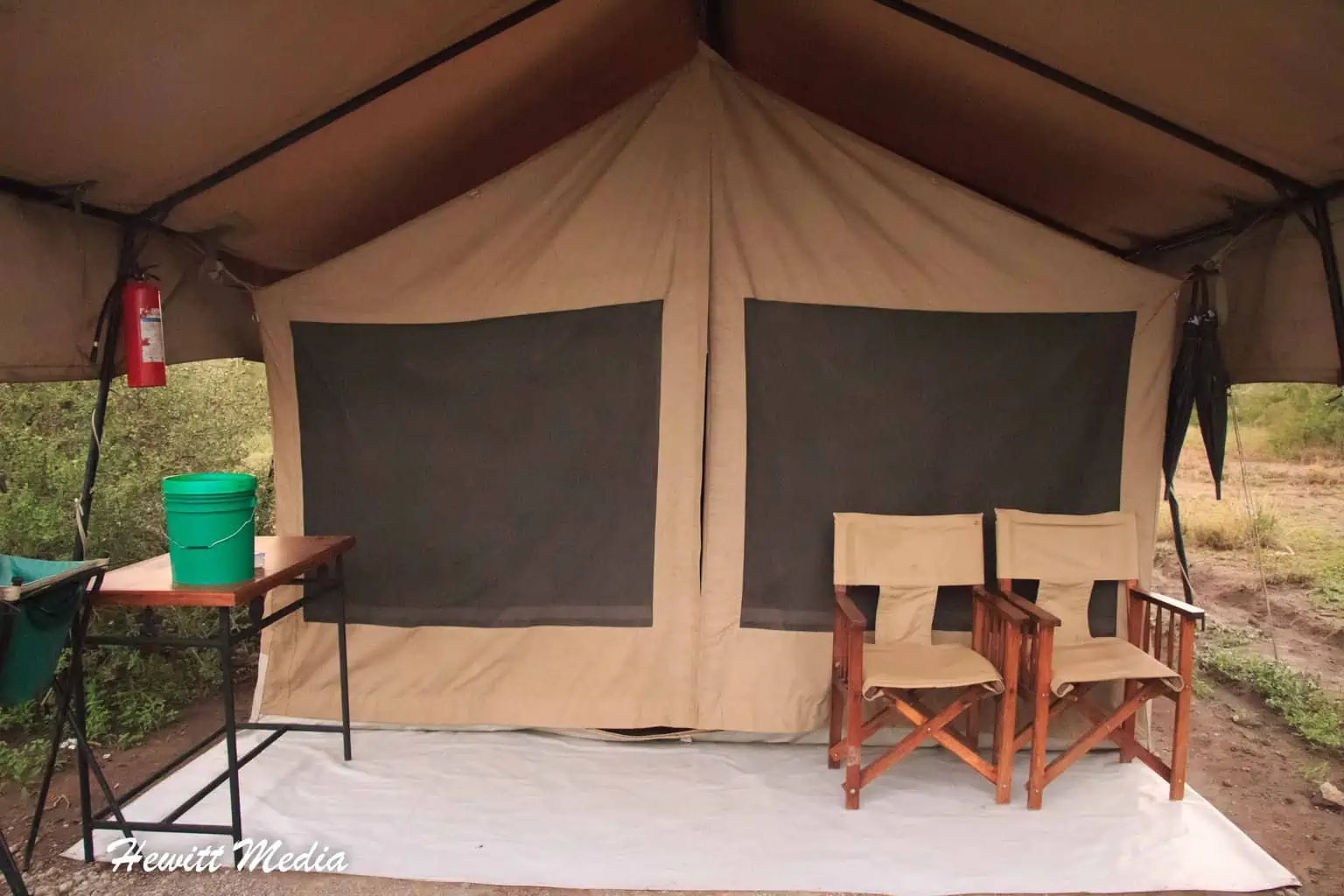
It may not have all of the luxuries you might be accustomed to back home, but nothing beats being out in the middle of the Serengeti and among the very wildlife you came to see. It is truly an amazing experience that I absolutely recommend to anyone who is considering going on safari in the Serengeti National Park.
Campsite and Lodging Recommendations
Below you will find a detailed map of the Serengeti National Park and the surrounding park and conservation lands. The map includes plenty of lodges and tented camps that you can consider when going on safari in the area.
Pro Tip: Make sure you decide which parts of the Serengeti and surrounding areas you want to see first and then look into the accommodations. In most cases, your safari operator will have recommendations for lodges and camps in the areas that you will be visiting and will make the arrangements for you.
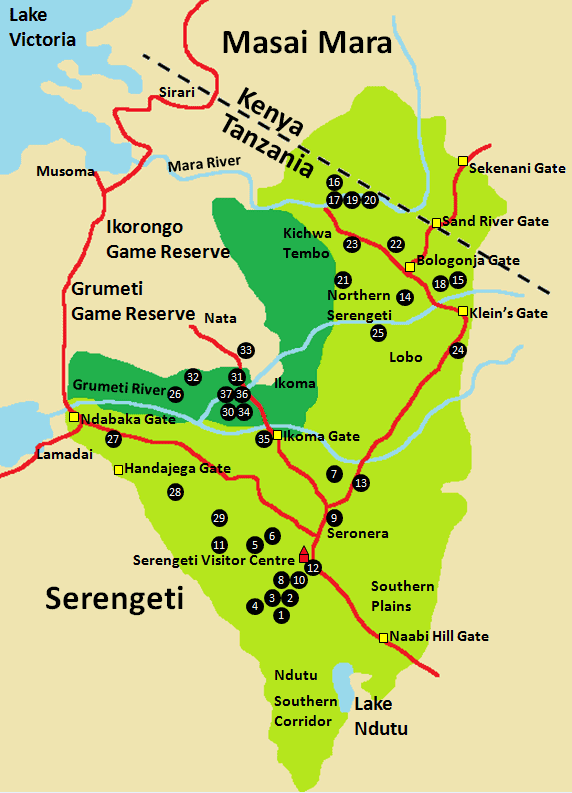
Accommodations in the Central Serengeti
Accommodations in mara – the northern serengeti, accommodations in lobo – the northern serengeti, accommodations in the western serengeti, accommodations in the ikoma region, serengeti national park fees.
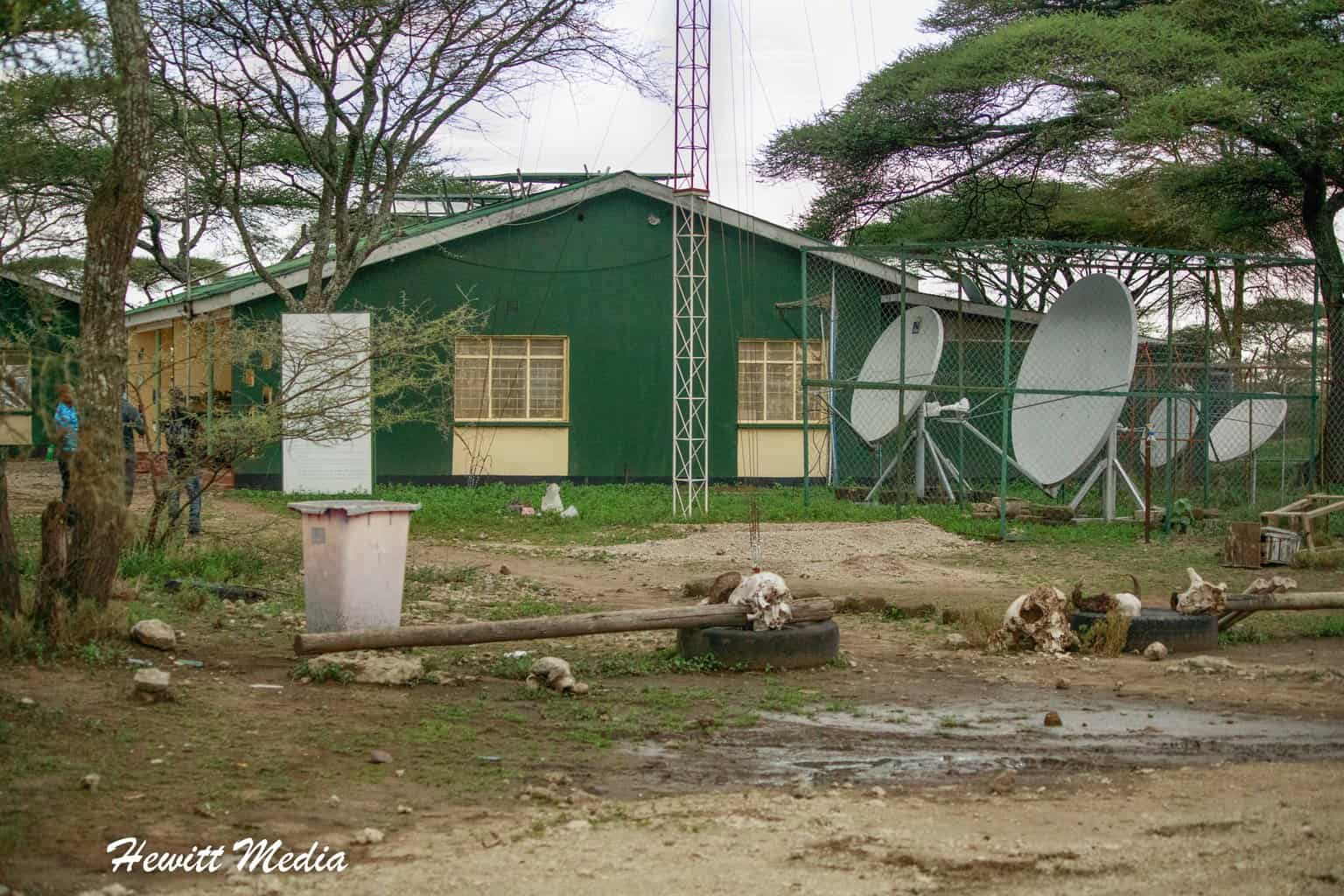
Important: Make sure you read the section below carefully so that you understand how long your permit for the Serengeti National Park is good for. I have read a lot of stories about people who had their trips ruined because they did not properly understand the rules.
To enter the Serengeti National Park, you must purchase a permit. The permits are obtained on a per-person basis, and they are good for 24 hours.
This is important when considering when you are going to enter the park. Should you enter the park at mid-day, you will be expected to exit the park at mid-day the next day. If you stay past the 24 hours allowed by your permit, you will need to pay for a permit for an additional full day.
In most cases, your safari operator will take care of purchasing your safari permits for you and will handle the logistics of when you enter and need to leave the park. However, if you are planning on doing a self-drive through the Serengeti, please check the Tanzania Parks official website for the current fees .
The Wildlife You Might See in the Serengeti
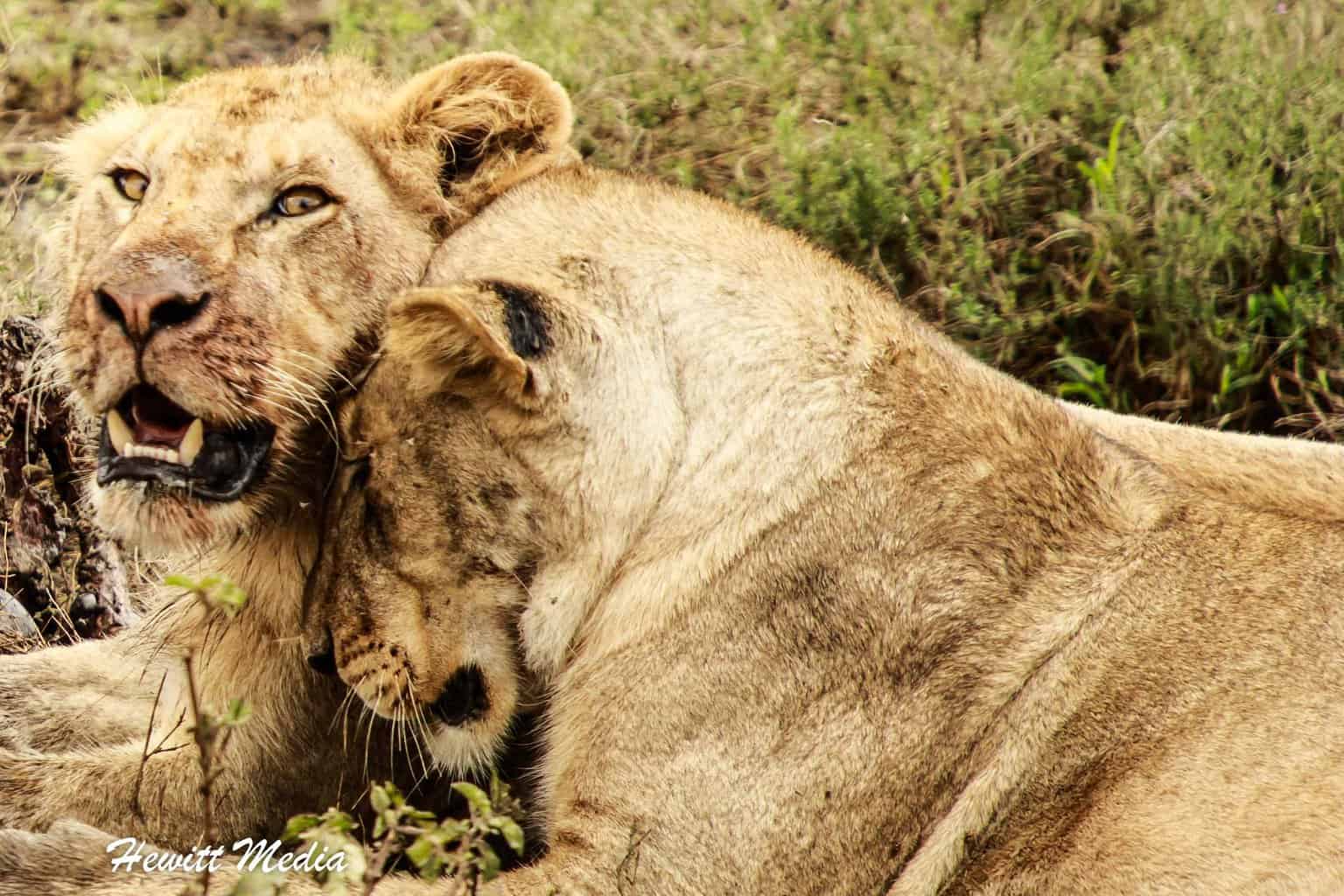
The landscape in and around the Serengeti National Park is truly remarkable in and by itself, but the main reason people flock to go on a Serengeti National Park safari is to see the wildlife.
And let me tell you, the wildlife does not disappoint. With the large numbers of migrating animals and all of the predators that congregate to feast upon them, there is no shortage of wildlife in the savannas of the Serengeti.
When you are on a Serengeti National Park safari, you can expect to see most, if not all, of the animals that you came to Africa to see. In addition to the “Big Five” animals of Africa, which include elephants, rhinos, lions, leopards, and buffalo, you have a good chance of seeing spotted hyenas, cheetahs, hippos, giraffe, zebra, wildebeest, and many of the other grazing animals that Africa is known for.
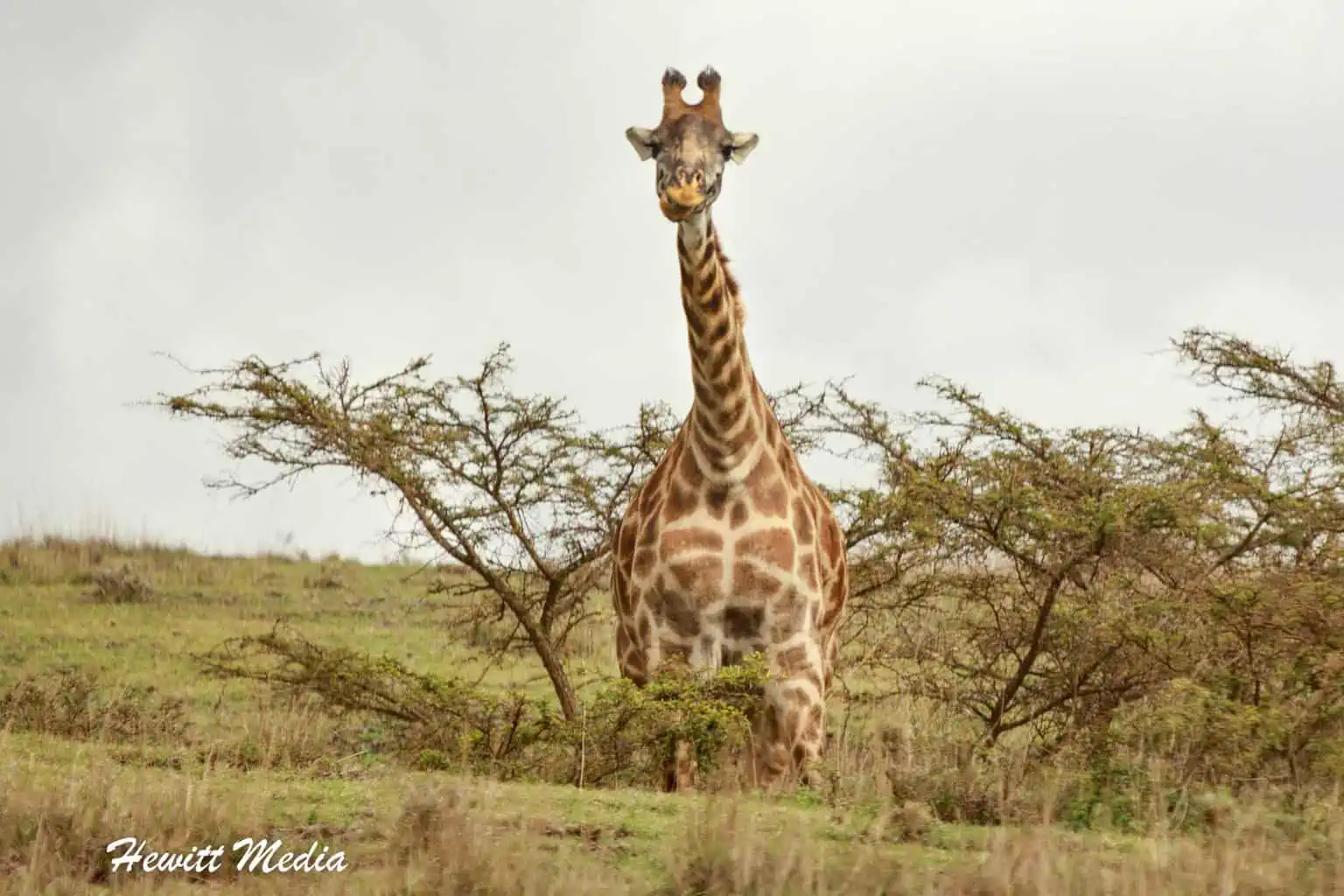
The Serengeti is a Great Place to See Predators
If you are looking to see some action, a Serengeti National Park safari also provides you a great chance to see some predator action first-hand year-round, but this is especially true during the calving season in late January and February and during the height of the great wildebeest migration.
When we were on safari in the Serengeti, we got to see lions feasting on a wildebeest, which was a very surreal experience. It was sad to see a life lost, but we were happy to see that all of the little lion mouths would be fed that day.
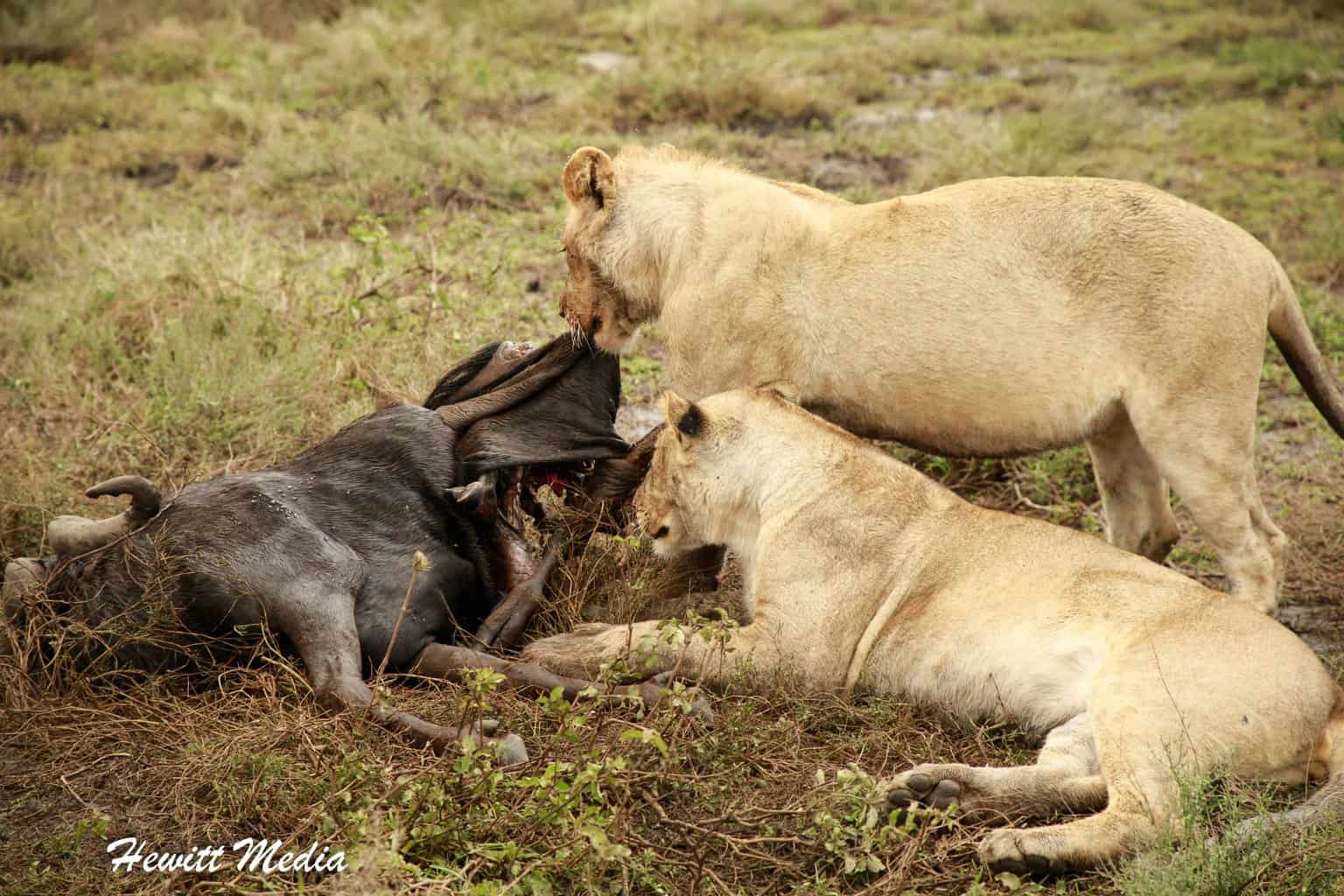
The Serengeti is a big place and there is so much to see, so make sure you communicate with your safari guide. If you let them know which animals you are really interested in seeing, they will be able to put you in a better position to see those animals.
In addition to their years of experience guiding and tracking these animals, they also have two-way radios that they use to communicate with other drivers and share information about what is happening throughout the Serengeti.
Serengeti Safari Tips
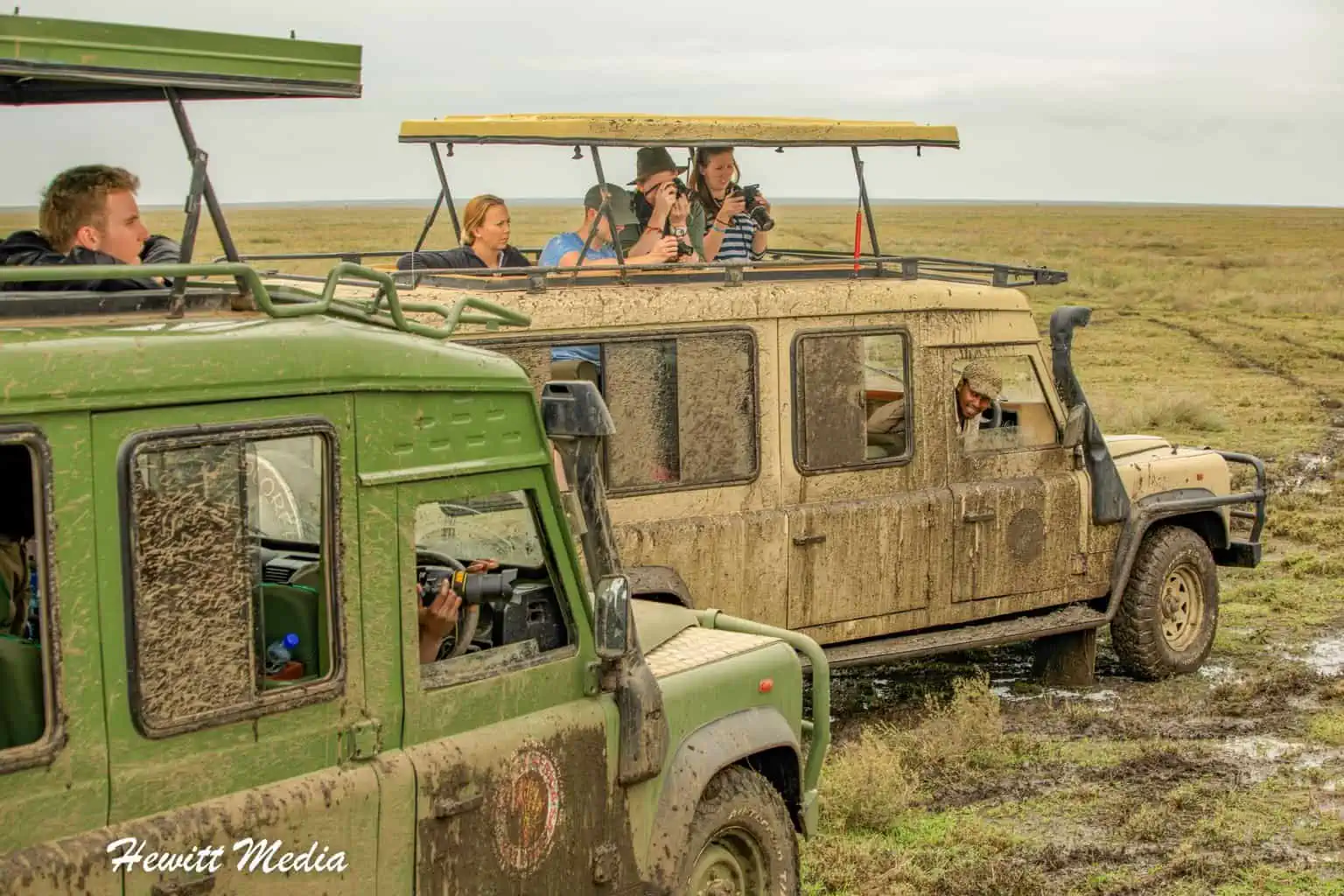
When you are on your Serengeti National Park safari, where animals are abundant, it is easy to get lost in the experience. Being on safari is such an amazing experience and you should enjoy every single second of it. However, if you aren’t careful, you might not get everything out of the experience that you could have.
To make sure that you get everything out of your safari experience in the Serengeti that you possibly can, I have provided some general safari tips below for you to review.
Be Patient and Open Minded
When you are on safari, everything isn’t going to go according to plan. The weather, the animal’s behavior, and other factors are going to impact where you go and what you see.
Safety First
It is really easy to get caught up in the safari experience and want to get the best pictures you possibly can. However, safety should always be the primary concern. To give you some help in how to remain safe while on safari in the Serengeti, I have outlined some general safety tips for you to review later in this guide.
Don’t Get Stuck Behind Your Camera
Everyone wants to get great pictures while on safari, and you should absolutely bring your camera and take a lot of pictures. However, if you spend your entire time in the Serengeti looking through your camera, you are going to miss out on some of the experience. I would recommend setting your camera down every once in a while and just enjoy being in such an amazing place.
Ask Lots of Questions
Make sure you ask your guide a lot of questions while you are in the Serengeti. It is easy to get caught up in the moment and forget to ask which type of animal you are looking at or why they are doing what they are doing, but your safari guide is there to answer these questions for you. And believe me, they enjoy answering these questions. Don’t get home and regret not asking those questions.
Be Conscious of Time
You are going to see some amazing things while you are on safari in the Serengeti. However, as I mentioned before, the time that your daily permit is good for is limited.
Don’t get too caught up in one place within the Serengeti for too long as you might regret not having time to do other things later. By no means am I suggesting that you should rush through the park, but you might not want to linger watching one thing for hours upon hours either.

More than anything else, the best tip I can give you is to just have fun. Going on a Serengeti National Park safari should be a trip of a lifetime, and you should enjoy every single second of this adventure. Don’t get caught up on the little things that might go wrong. Before you know it you will be back at home and left with just the memories and pictures of your adventure. Make those memories great ones!
Safari Safety Tips
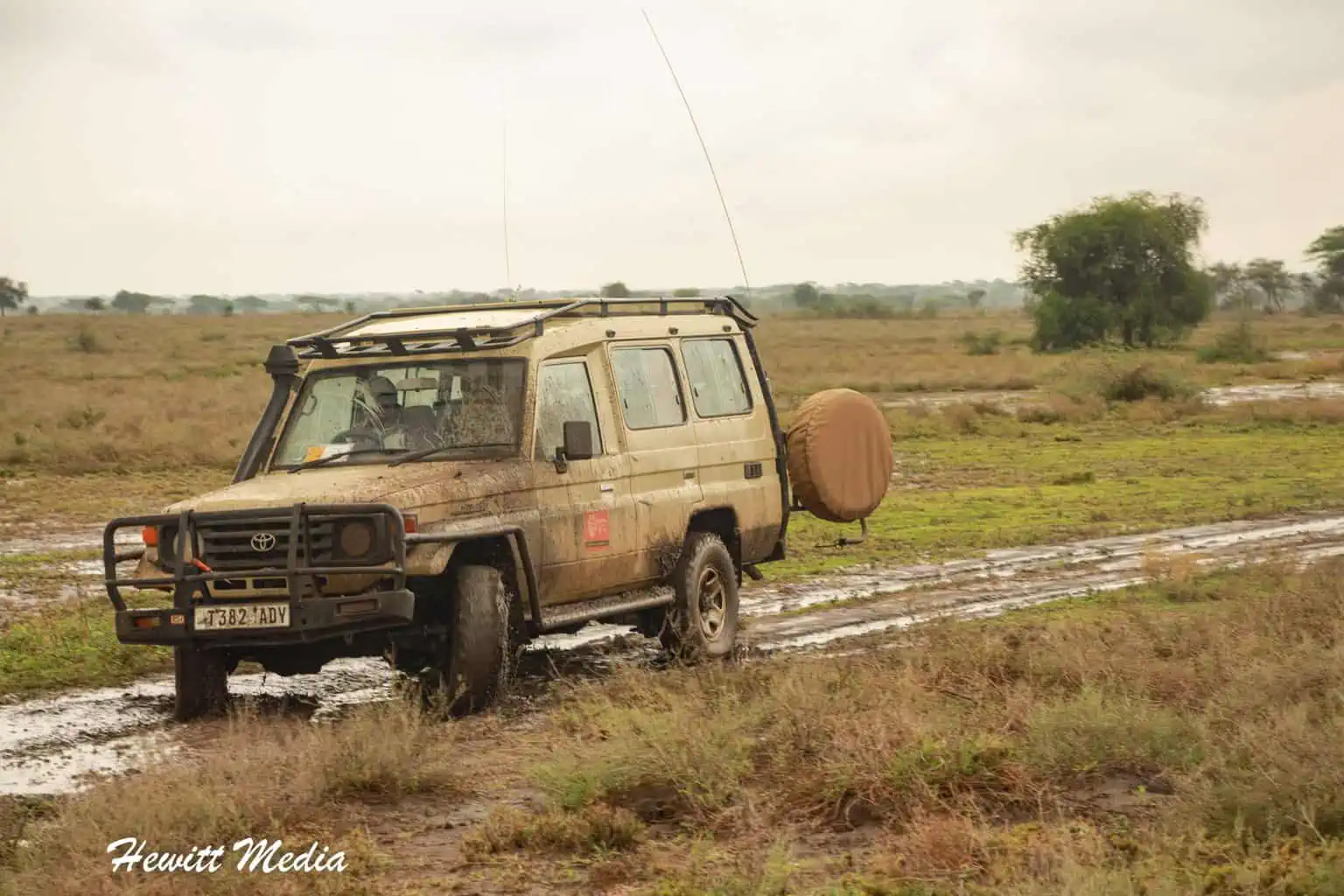
Being on a Serengeti National Park safari can be an amazing and exciting experience, but it can also be a very dangerous experience if you don’t follow the proper safety rules. To ensure that your safari experience is a memorable and safe one, I have outlined some general safari safety rules for you to review below.
Obey Your Safari Guide at All Times
The most important safari safety tip of all is to listen to your safari guide and obey them at all times. They are there to keep you safe, so let them.
Don’t Stick Anything out of the Safari Vehicle
It is never a good idea to stick anything outside of a safari vehicle. Whether this be your arms, your feet, or your camera as you try to get a great picture, keep them inside the vehicle at all times.
Don’t Make Frantic Movements
When you are in the safari vehicle, the animals tend to think of the vehicle, and everything associated with it as one homogeneous entity. However, if you make sudden and frantic movements, or do something else to make you stick out as apart from the vehicle, you may become an object of interest to them.
Never Get Out of the Vehicle
This point cannot be stressed strongly enough. Never, and I mean never, get out of your safari vehicle unless your safari guide explicitly instructs that it is safe.
Never Leave Your Tent or Lodge at Night
This is another point that I cannot emphasize strongly enough. You should never leave your tent or lodge room at night without a chaperone. The African bush can be a dangerous place, especially at night, so make sure you follow whichever procedures your safari guide gives you for getting assistance at night. If they don’t mention this, make sure you ask ahead of time.
Walk, Never Run
If you do find yourself outside of your vehicle and confronted by an animal (hopefully this never happens), then make sure that you stay as calm as possible, walk away slowly (never turning your back on the animal), and NEVER, EVER run away.
Be Careful Around Lakes and Rivers
Unless you are explicitly told by your safari guide that the waters are free of hippos and crocodiles, you should never attempt to swim in a lake, river, or pond. Even then, I would think twice about doing it. Hippos kill more people in Africa than any other animal, and crocodiles are not far behind on the list, so you always have to be safe when even approaching bodies of water.
Stuck in the Serengeti
It wasn’t all fun and games while we were on our Serengeti National Park safari. On our second to last day of safari, we managed to get stuck in the mud in the Serengeti. It was an interesting experience, to say the least. Check out the short video below to find out how it could have been much worse for us.
Serengeti Safari Photo Gallery
Serengeti National Park is one of the most amazing wildlife destinations in the world. Below is a gallery of just some of the wonderful pictures we were able to take while on our Serengeti National Park safari.
If you would like to see more of my travel photography, I would also encourage you to give me a follow on Instagram . Putting this blog together to pass on my free guides, itineraries, and travel photography tips is a lot of work and your support in the form of a follow-on Instagram would be so very much appreciated!
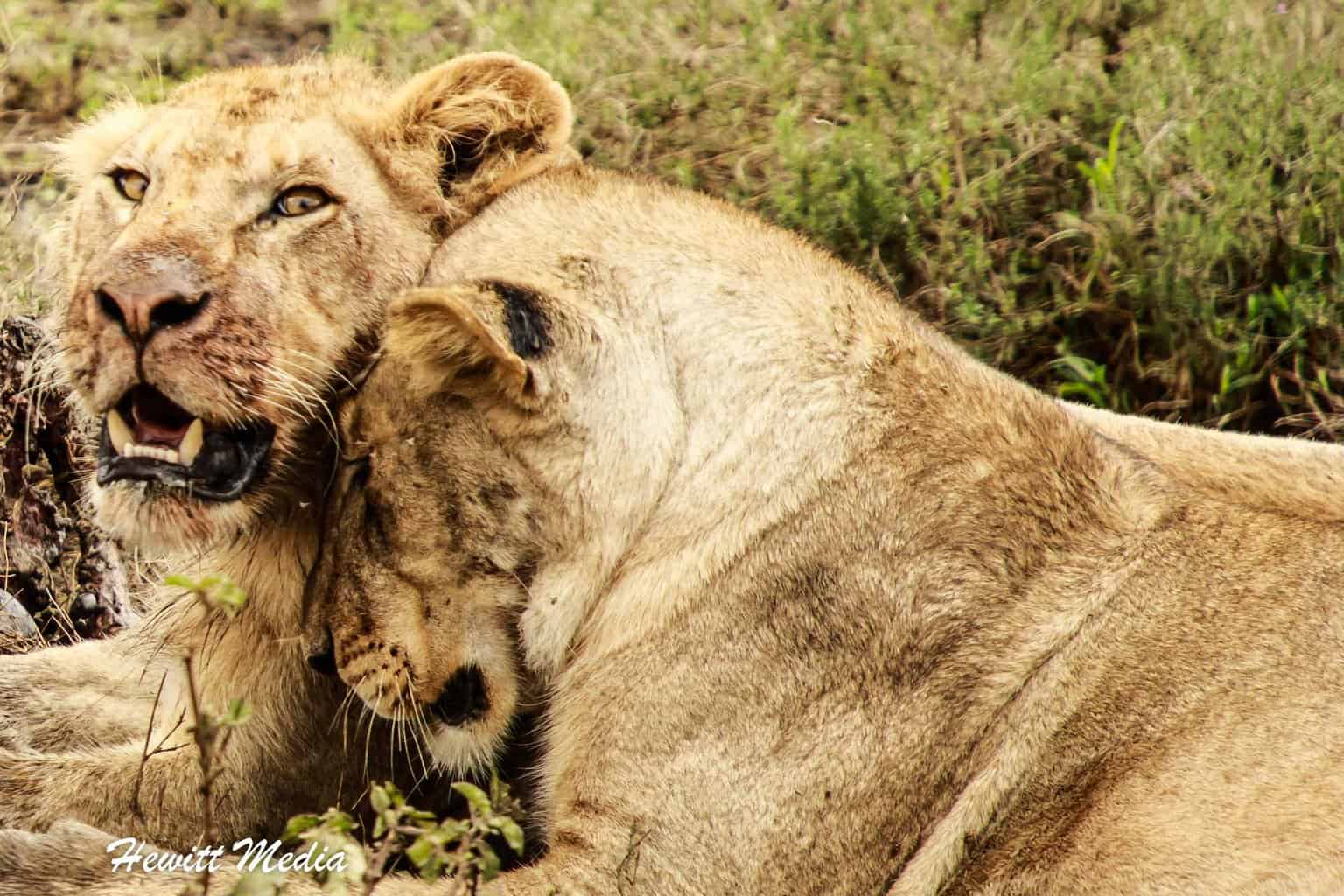
Don’t Forget to Subscribe to My Adventures!
Type your email…

Let Me Help You Save On Your Next Adventure!
‘start exploring today’ merchandise available now.
Published by Josh Hewitt
Avid traveler and photographer who loves to see new places, meet new people, and experience new things. There is so much this world can teach us, we just need to explore! View all posts by Josh Hewitt
Related Articles

Unforgettable Experiences: The Top 25 Things to Do in South Africa

How to Safely Take on a Multi-Day Road Trip

Unforgettable Adventures: Top 30 Things to Do in New Zealand
Leave a reply cancel reply.
[…] The 20 Best Travel Accessories for 2024: An Essential Guide – https://wanderlustphotosblog.com/2024/01/24/the-20-best-travel-accessories-for-2024-an-essential-gui… […]
Discover endless entertainment with KheloYar, the go-to platform for online gaming enthusiasts. Offering a diverse selection of games, from fantasy…
Hi Michael. I would walk in with you wide angle on your camera and have your 100-500 in your bag.…
Heading to Peru in a week. I was going to take my wide angle plus 100-500 lens. Is there a…
Discover more from Wanderlust Travel & Photos
Subscribe now to keep reading and get access to the full archive.
Continue reading

Subscribe To My Adventures!
Serengeti National Park
All serengeti lodges & camps.
A myriad of accommodation options is available in Serengeti National Park. From adventurous mobile tented camps following the Great Migration to family-oriented lodge style accommodations and anything in between, you can be sure to find the perfect spot just for you.
Make use of the filters below to search for accommodation options within your budget. Specific rates are displayed on each individual lodge description page. You can also search by location or search by season (Great Migration).
- Price $$$$$
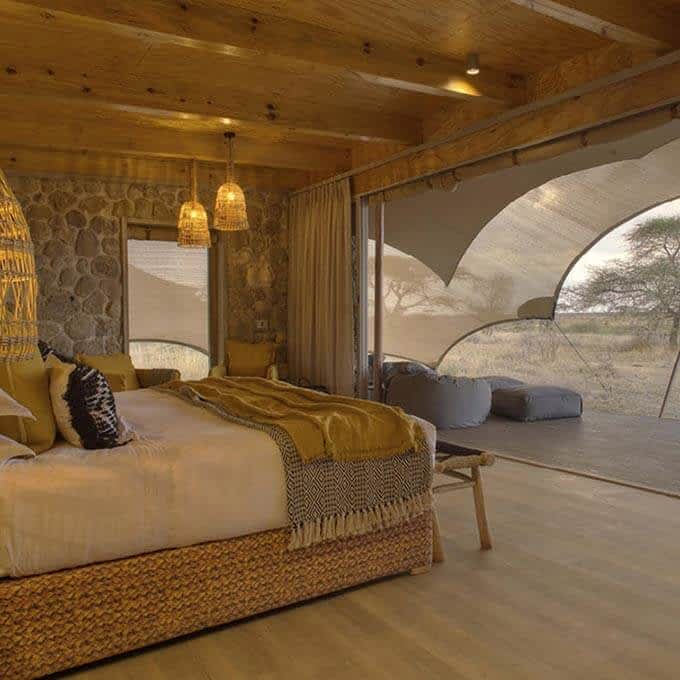
Namiri Plains
lodge location Central Serengeti
A home away from home on the plains. This lodge is all about luxury, cheetah conservation and wildlife. Namiri Plains is a remote camp, yet close to all the action. Spacious tented suites offer spectacular and uninterrupted views across Serengeti National Park.

from US$ 629 per person per night
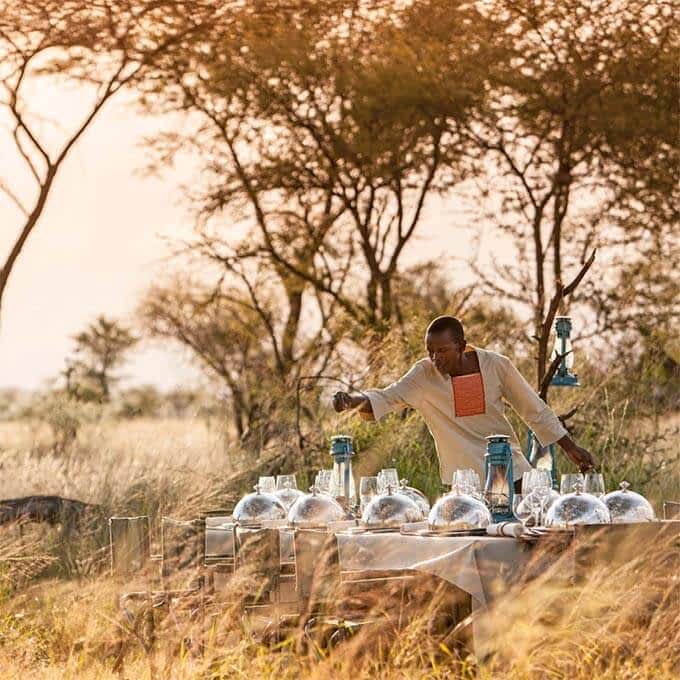
Four Seasons
Indulge yourself with great game drives, soothing spa treatments, a cocktail bar with the best possible views, a gourmet food experience as well as many excursions options and more. Get ready for an immersive safari experience at the Four Seasons Serengeti Safari Lodge.

from US$ 902 per person per night
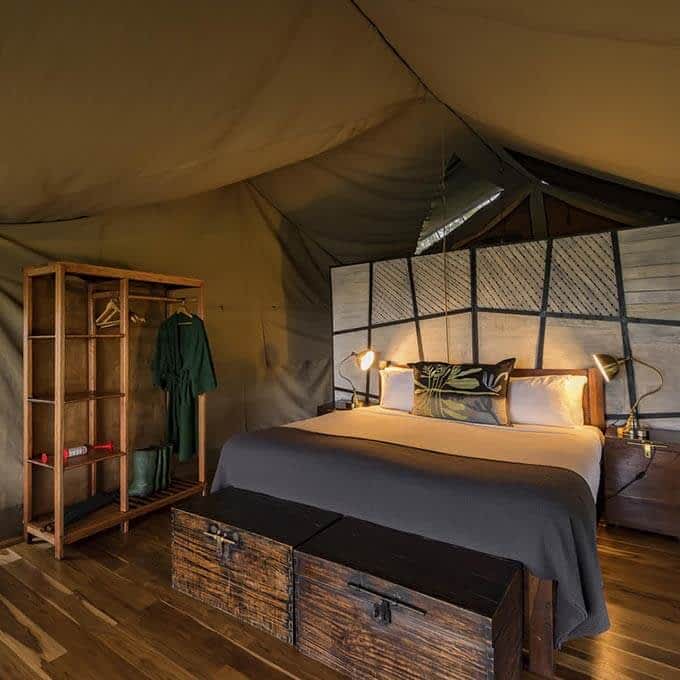
Best of the Serengeti, extraordinary, setting breathtaking – these phrases are just a selection of the reviews written about Dunia Camp in Serengeti National Park. Explore this accommodation yourself and discover why everybody wants to return.

from US$ 494 per person per night
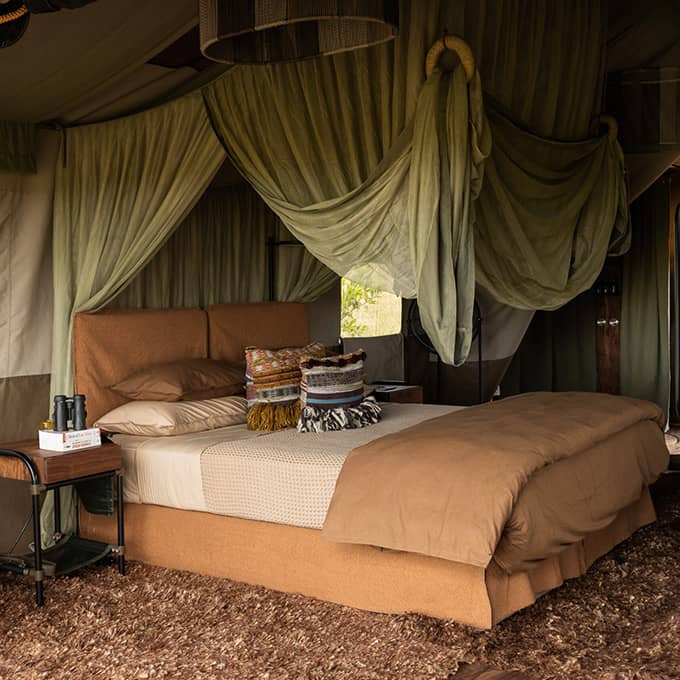
Singita Mara River Tented Camp
lodge location Serengeti Mara
From one of just six (!) luxury tents at Singita Mara River Camp, you will find yourself overlooking the illustrious Mara River, and perhaps some of its resident wildlife. In the distance grazing zebras, right behind you your beautiful, luxurious tented suite.

from US$ 2,045 per person per night
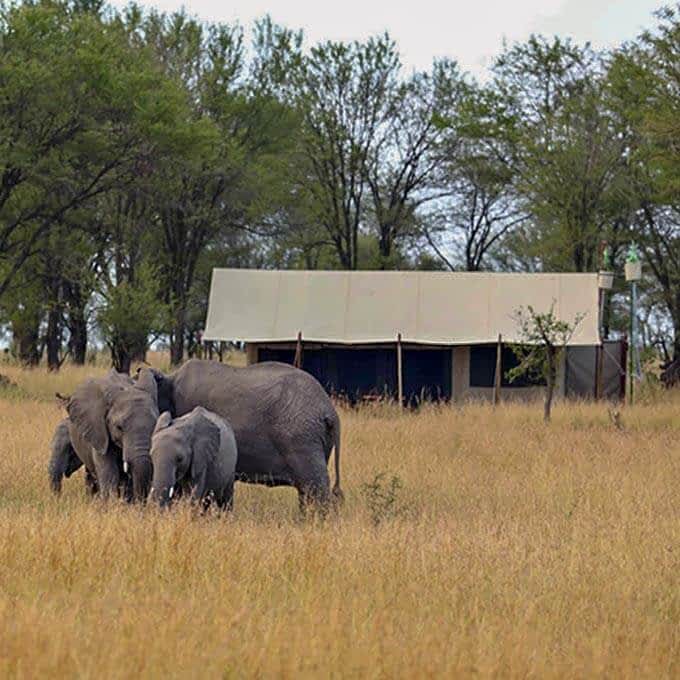
Olakira Migration Camp
lodge location Migration Area
With just nine airy and luxurious safari tents, which moves completely twice a year to follow the Serengeti Great Migration, this warm camp radiates a family atmosphere. Simply because the owners put their people – guests and staff - first.

from US$ 920 per person per night
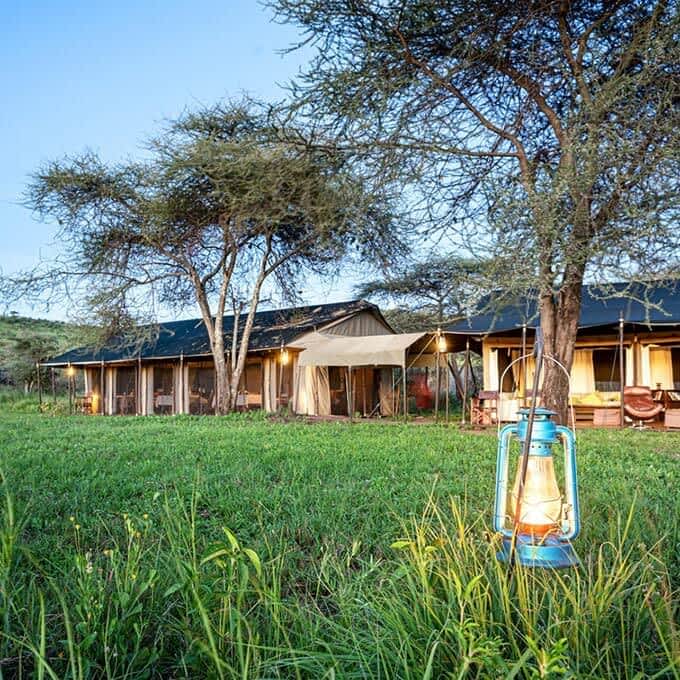
Lemala Ewanjan Tented Camp
Are you seeking a classic, diverse safari experience? Lemala Ewanjan is located in the bustling Seronera area attracting abundant wildlife – big game, elegant antelopes, majestic birds; discover it all at this warm-hearted camp. Private plunge pools included.

from US$ 429 per person per night
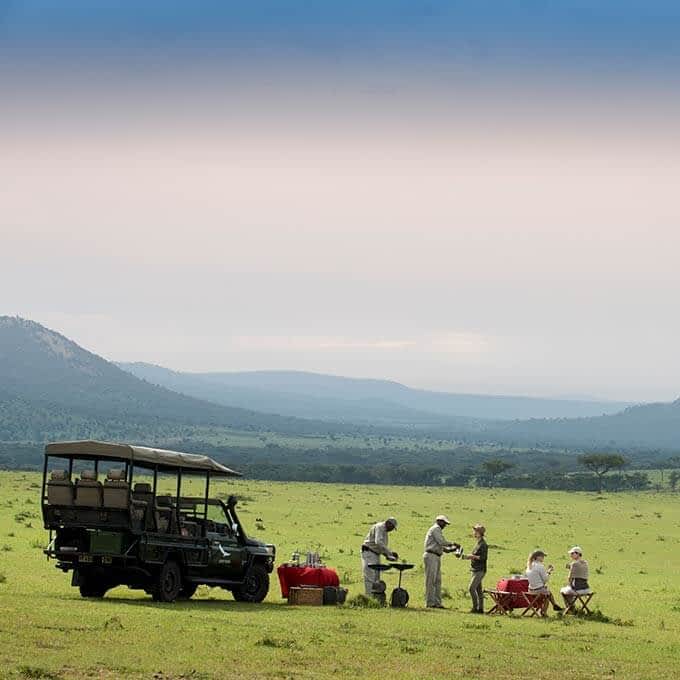
&Beyond Klein's Camp
lodge location Lobo & Loliondo
Enchanting, relaxing, and quiet: &Beyond Klein's Camp is an unaffected paradise, located in a remote corner of the Serengeti. Discover this area by safari vehicle (also by night) or on foot – and be sure you take time to meet the local Maasai residents.

from US$ 1,050 per person per night

Singita Sasakwa Lodge
lodge location Grumeti Game Reserve
With only ten private cottages, the lodge style is grand and spacious with a feeling of historical opulence. The main areas are double volume opening out onto breath-taking decks offering vistas over the endless plains of Serengeti National Park.

from US$ 2,360 per person per night
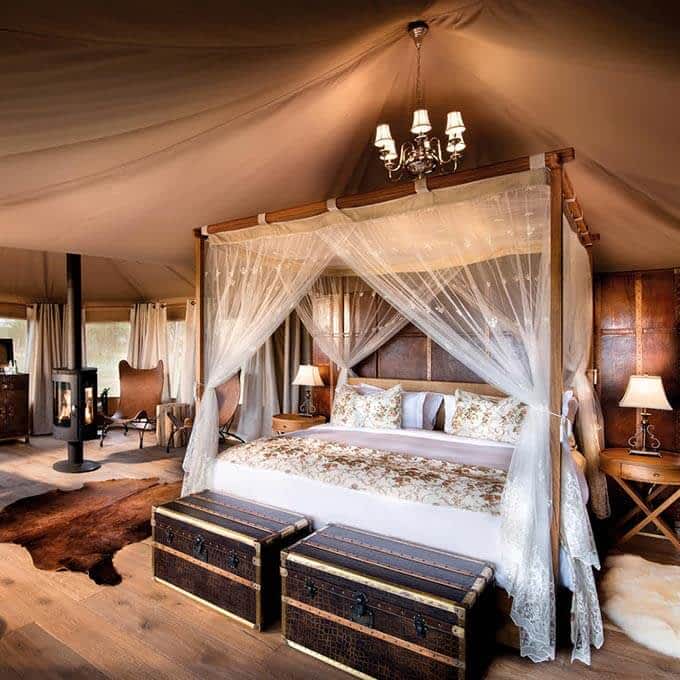
One Nature Nyaruswiga
Where all the splendors of the Serengeti come together – lush land, wildlife and opulent accommodation - is an exclusive lodge. A warm place for families, couples and groups, and perfect for everlasting memories: welcome to One Nature Nyaruswiga.

from US$ 1,654 per person per night
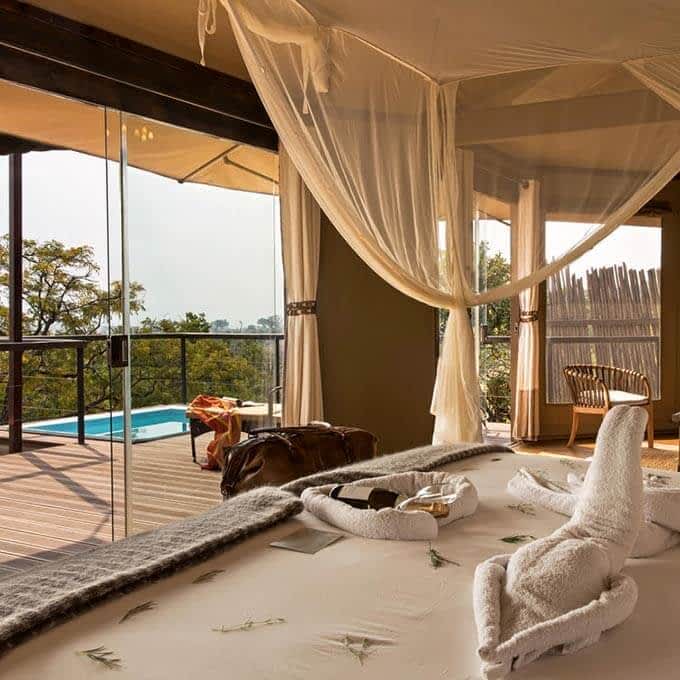
Lemala Kuria Hills Tented Lodge
A stunning and remote location, close to the famous Mara River: this lodge is the perfect Serengeti safari destination. Abundant wildlife, glass fronted tented suites including private plunge pool, and timeless hospitality – welcome to Kuria Hills Lodge.

Nomad Serengeti Safari Camp
Nomad Serengeti Camp takes you back to the early days of going on safari when it was all about the safari experience and not necessarily the luxury trappings of a camp. This intimate, tented retreat is mobile and moves several times per year to follow the Migration.

from US$ 745 per person per night
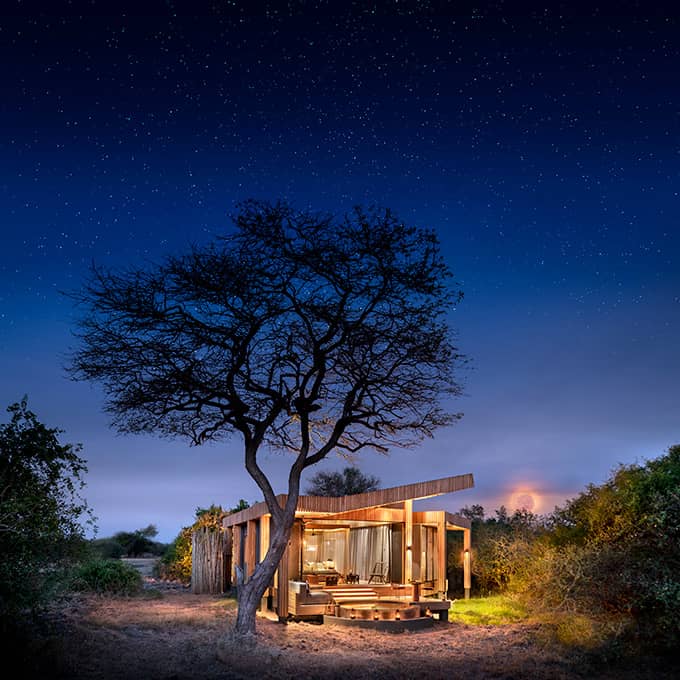
&Beyond Grumeti River Lodge
lodge location Western Corridor
Sleeping under canvas is a genuinely calming experience: the sounds of nature trickle right into your ear. And upon opening your canvas to stunning views, you will immediately slip into a relaxed pace of life at this camp in this remote corner of the Serengeti.

from US$ 1,250 per person per night
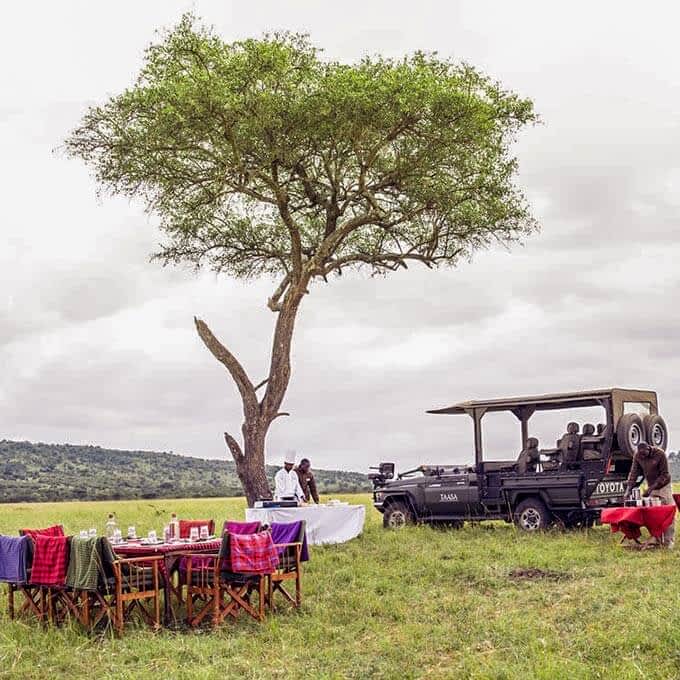
Taasa Lodge
lodge location Northern Serengeti & Lobo
Luxurious "camping" with incredible wildlife sightings: feel the pulse of the mystic northern Serengeti & Lobo area at this camp far away from the crowd. Enjoy dinners around the open-air boma while wildlife wanders past – there are oh-so- many reasons to stay at Taasa Lodge in Serengeti.

from US$ 819 per person per night
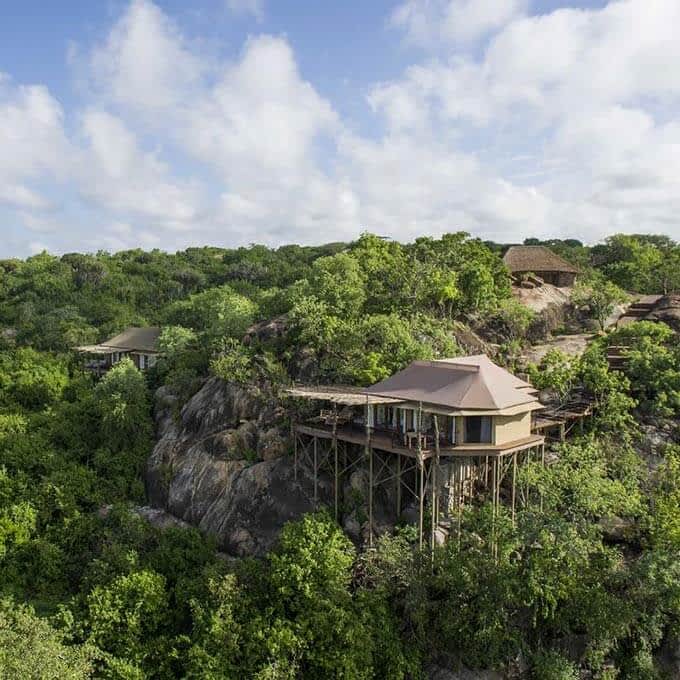
Mwiba Lodge
lodge location Southeastern plains & Ndutu
Can a remote, pristine wilderness area go hand in hand with ultra-luxurious designer tented suites? At Mwiba Lodge in southern Serengeti it can, and does it with style. Discover the area by vehicle, on foot, or from the air and immerse yourself in this luxurious, wildlife experience.

from US$ 1,939 per person per night
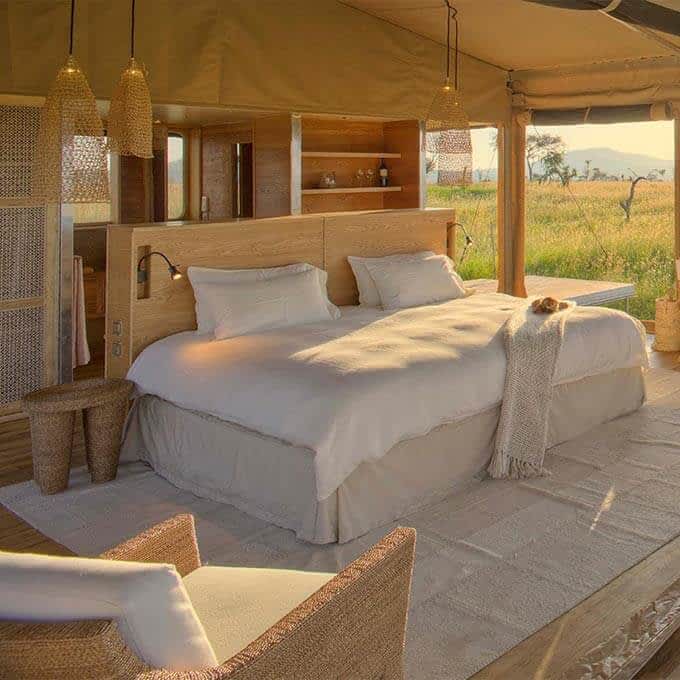
Roving Bushtops
lodge location Serengeti Migration Area
Roving Bushtops takes “camping” to a whole new level, with immaculate -mobile- accommodations that will tempt you to join those who return here year after year. This glamorous luxury camp moves between locations twice a year and allows to see the Great Migration up close.

from US$ 2,174 per person per night
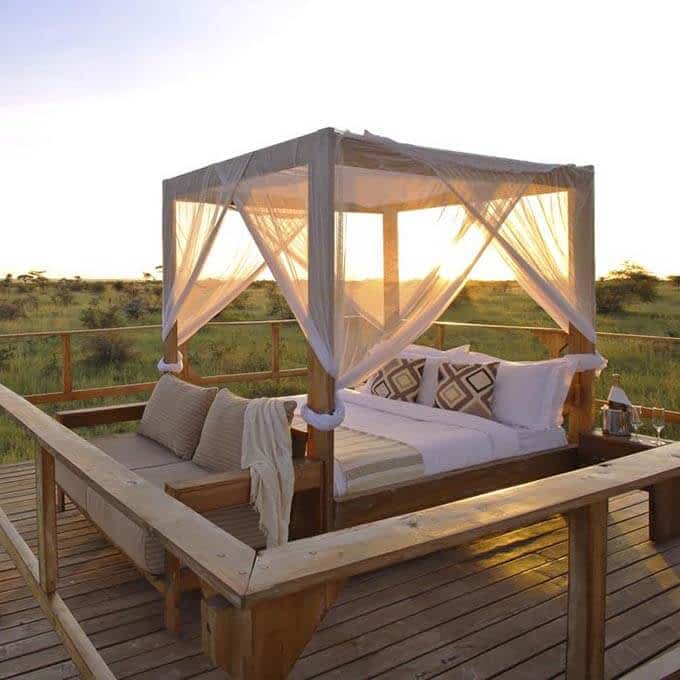
Entara Olmara Camp
Spend the night under the stars on your very own platform overlooking the Serengeti. The waterhole (the only permanent water source around), visited by elephants, along with lion, leopard, eland, zebra, and more, making for some pretty magnificent game viewing.

from US$ 659 per person per night
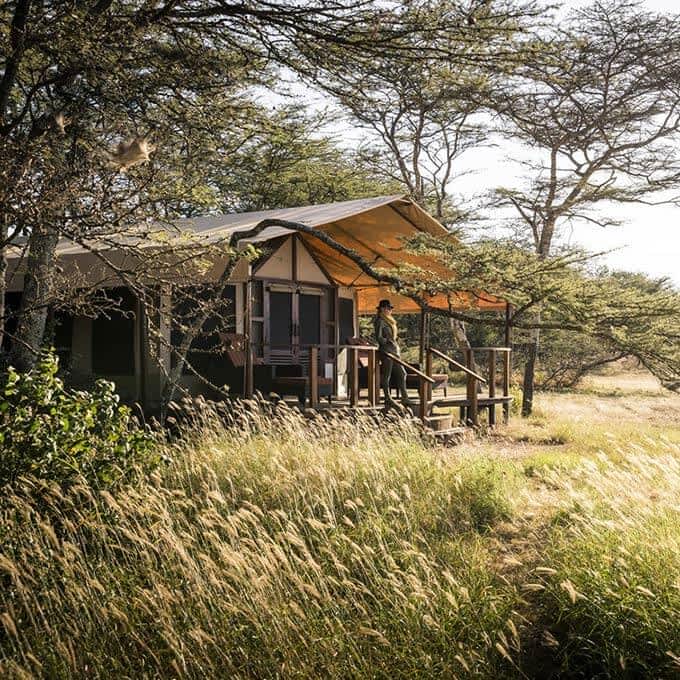
Kusini Safari Camp
lodge location Southern Serengeti
If your idea of a safari getaway is to get away from it all, including fellow travelers, then Sanctuary Kusini is the ideal place. A small camp, with dedicated staff, and seclusion from the bustle of other areas, you’ll enjoy the peace and quiet of this home away from home.

from US$ 945 per person per night
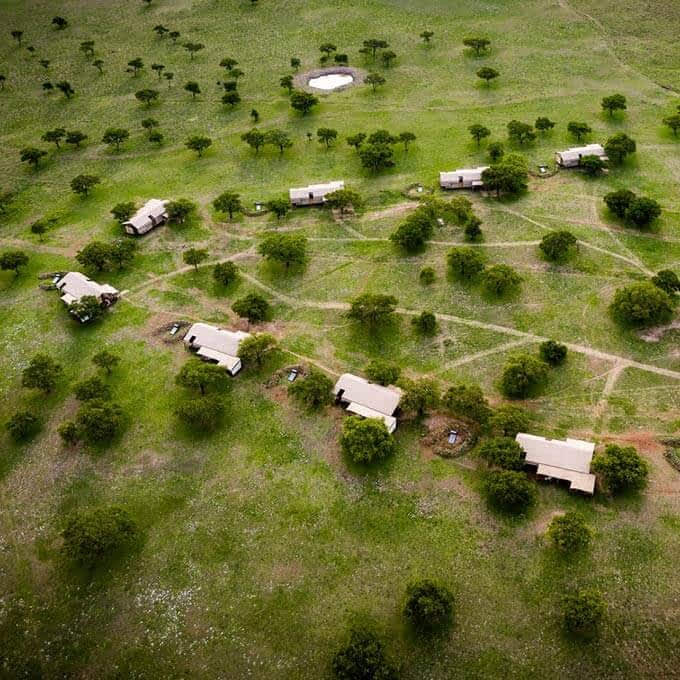
Sabora Tented Camp
Are you looking a sense of safari adventure where the modern world feels thousands of miles away in a ‘vintage’ setting? Set off to beautiful Singita Sabora Tented Camp in Grumeti Game Reserve and create safari memories that will last a lifetime.

&Beyond Serengeti Under Canvas
lodge location Migration area
&Beyond Serengeti Under Canvas is a mobile tented camp that moves between locations several times a year: this is done so that you will be able to experience the Great Migration up close and personal. Just 9 luxury safari tents make up this camp 'under canvas'.

from US$ 1,005 per person per night
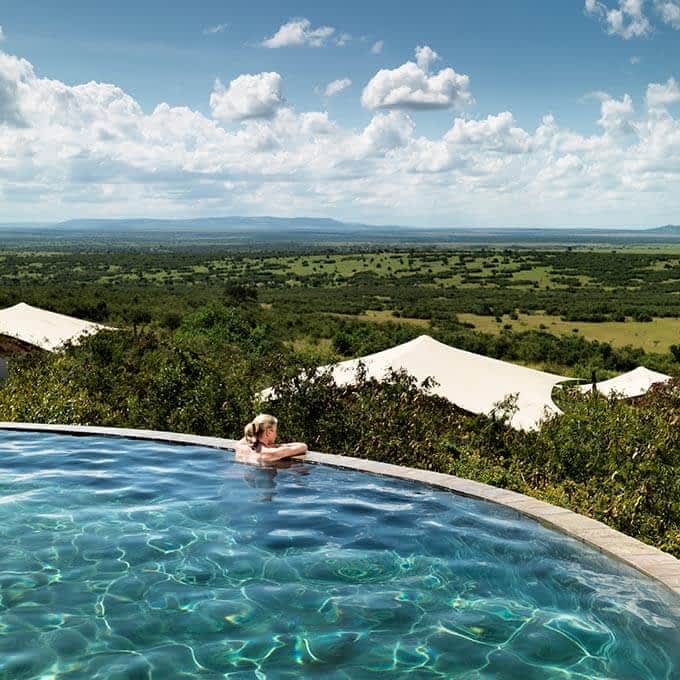
Serengeti Bushtops Camp
Incredible views, resting under tented canvas, full day explorations – just a few perks of a stay at Serengeti Bushtops Camp. Looking for a homely and pure safari destination? Bushtops Camp is your perfect Serengeti National Park safari destination.

from US$ 1,029 per person per night
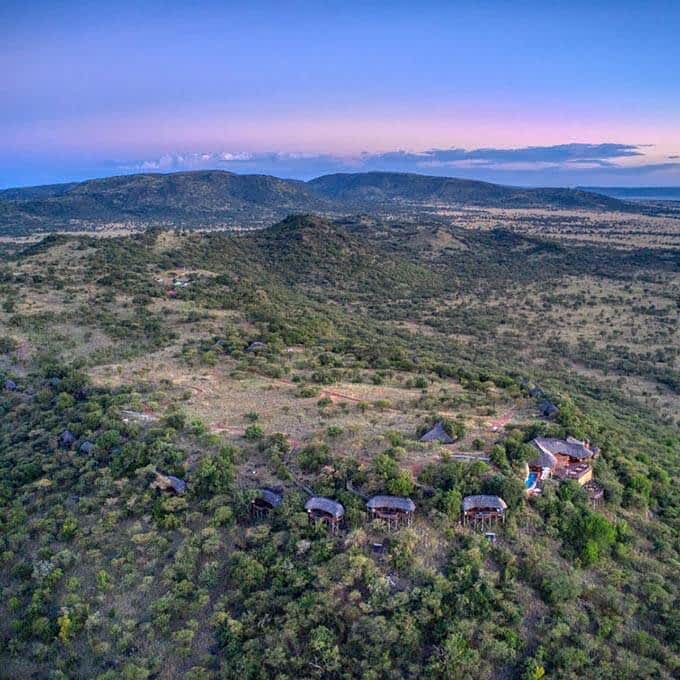
Mbali Mbali Soroi Serengeti Lodge
If you are seeking a perfect Serengeti family safari: don’t look any further. At Mbali Mbali Soroi Serengeti Lodge the staff will do everything possible to give the whole family -including your youngest- a heart-warming and unforgettable impression of Africa.

from US$ 370 per person per night
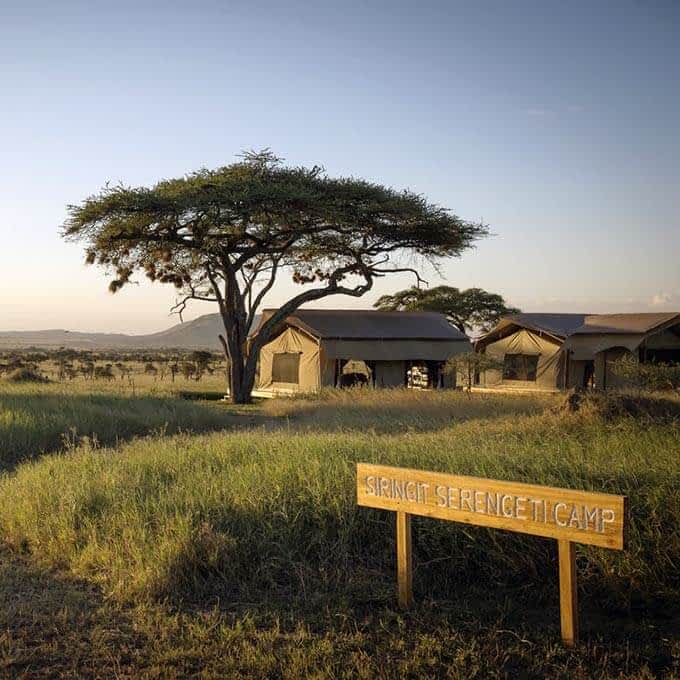
Siringit Serengeti Camp
Disconnect from our high-tech, fast paced world, and reconnect with a deeply rooted sense of tranquillity. Come to Siringit Serengeti Camp for a basic, but genuine Serengeti ambiance. This is pure safari elegance – for a reasonable price.

from US$ 547 per person per night
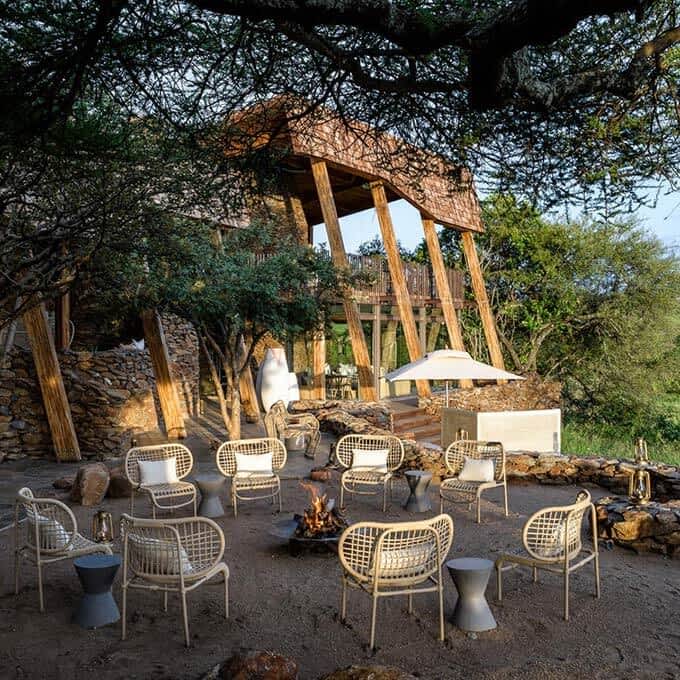
Singita Faru Faru Lodge
Jaw-dropping design, pure luxury, modern decorated suites, gourmet food; Singita Faru Faru Lodge is where you come for de-stressing and around-the-clock pampering, plus the best wildlife viewing in Tanzania's spectacular Grumeti Game Reserve.

Nomad Lamai Serengeti
Nomad Lamai isn’t a place for those looking for opulence and extravagance; it is a piece of big-game Serengeti, where encounters with wildlife are authentic, intimate and always wild. The Serengeti Mara area is a meeting point for more animals than you can think of.

from US$ 817 per person per night

Discovering the Wild: Best Places to Spot Exotic Animals
Top safari destinations.
E mbarking on a safari adventure is an exhilarating experience that allows you to connect with nature and witness some of the world's most magnificent creatures up close. From the vast savannahs of Africa to the dense rainforests of Southeast Asia, there are countless destinations around the globe that offer incredible opportunities for spotting exotic animals in their natural habitats. In this article, we will take you on a journey to explore some of the best places to spot these majestic creatures.
1. Maasai Mara National Reserve, Kenya
The Maasai Mara National Reserve in Kenya is undoubtedly one of the most renowned safari destinations in the world. Known for its spectacular annual wildebeest migration, where millions of wildebeests and other herbivores make their way across the plains in search of greener pastures, this reserve offers a truly awe-inspiring wildlife spectacle. In addition to the migration, visitors can spot lions, elephants, giraffes, cheetahs, and a wide variety of bird species.
2. Serengeti National Park, Tanzania
Adjacent to the Maasai Mara National Reserve lies the Serengeti National Park in Tanzania – another remarkable safari destination. With its sprawling grasslands, rolling hills, and picturesque acacia trees, the Serengeti is not only home to the legendary Big Five (lion, leopard, elephant, rhinoceros, and Cape buffalo), but it also hosts the iconic wildebeest migration. Witnessing thousands of wildebeests and zebras crossing crocodile-infested rivers is an experience that will stay with you forever.
3. Kruger National Park, South Africa
Situated in the northeastern part of South Africa, Kruger National Park is one of the oldest and largest game reserves on the African continent. Renowned for its extraordinary biodiversity, Kruger is home to an abundance of wildlife, including the Big Five, as well as hippos, crocodiles, zebras, giraffes, and numerous bird species. Thanks to its well-maintained infrastructure and a variety of accommodation options, Kruger offers visitors an unforgettable safari experience.
4. Pantanal, Brazil
Located in the heart of South America, the Pantanal is the world's largest tropical wetland and offers an unparalleled wildlife experience. This vast region is teeming with wildlife and provides a haven for jaguars, giant river otters, capybaras, anacondas, and an extraordinary variety of bird species. Exploring the Pantanal on boat safaris, hiking trails, or on horseback allows visitors to immerse themselves in its unique ecosystem and get closer to its mesmerizing inhabitants.
5. Ranthambore National Park, India
Ranthambore National Park, situated in the Indian state of Rajasthan, is famous for its population of majestic Bengal tigers. This picturesque park, with its ancient ruins and beautiful lakes, provides a stunning backdrop for wildlife enthusiasts and photographers alike. Apart from tigers, Ranthambore is also home to leopards, sloth bears, crocodiles, and a rich array of birdlife. The park's diverse landscapes, from grasslands to dense forests, make it a fascinating destination for spotting exotic animals.
Wildlife Photography Locations
For those passionate about wildlife photography, there are certain destinations that offer exceptional opportunities to capture stunning images of exotic animals in their natural habitat. These locations not only provide breathtaking backdrops but also allow photographers to hone their skills and create captivating compositions. Here are some of the top wildlife photography locations around the world:
1. Masai Mara National Reserve, Kenya
As mentioned earlier, the Maasai Mara National Reserve in Kenya is a haven for wildlife photographers. With its dramatic landscapes and diverse range of animals, it offers endless possibilities for capturing incredible shots. Whether you're hoping to photograph the intense migration or get up close to big cats, the Mara Triangle region of the reserve is particularly famous for its superb photographic opportunities.
2. Galapagos Islands, Ecuador
The Galapagos Islands, located in the Pacific Ocean off the coast of Ecuador, are renowned for their unique wildlife and incredible biodiversity. This volcanic archipelago is home to a plethora of exotic species, including giant tortoises, marine iguanas, blue-footed boobies, and playful sea lions. With its untouched natural beauty, the Galapagos Islands offer photographers the chance to capture rare and captivating images unlike anywhere else on Earth.
3. Svalbard, Norway
Svalbard, a remote archipelago situated in the Arctic Ocean, is a dream destination for photographers seeking Arctic wildlife encounters. Here, you can find polar bears, Arctic foxes, reindeer, and walruses against a backdrop of stunning ice formations and snow-covered landscapes. The long summer days and the mesmerizing midnight sun provide ample opportunities to capture extraordinary images of these magnificent creatures in their icy realm.
4. Chobe National Park, Botswana
Chobe National Park in Botswana is home to the largest population of elephants in Africa, making it a prime location for photographing these gentle giants. The park's proximity to the Chobe River allows photographers to capture images of elephants bathing, drinking, and interacting with their families in the water. Additionally, Chobe is also known for its abundant birdlife, stunning sunsets, and diverse ecosystems, providing photographers with a wealth of subject matter.
Wild Animal Hotspots
If you're looking to immerse yourself in the world of wildlife and experience the thrill of close encounters with exotic animals, there are specific hotspots that guarantee unforgettable wildlife encounters. These destinations offer unique opportunities to observe wildlife behavior, learn about conservation efforts, and contribute to the preservation of these incredible creatures. Here are some top wild animal hotspots:
1. The Great Barrier Reef, Australia
The Great Barrier Reef is not only a natural wonder of the world but also a haven for marine life. Snorkeling or diving in this magnificent ecosystem allows you to witness a kaleidoscope of colorful fish, turtles, rays, and even majestic whales during their migration season. By visiting the Great Barrier Reef, you support ongoing conservation efforts to protect this fragile and diverse ecosystem.
2. Borneo, Malaysia
Borneo, the third-largest island in the world, is a treasure trove of unique and endangered species. The island is home to orangutans, pygmy elephants, proboscis monkeys, and a wide range of bird species, including the rare Bornean bristlehead. Exploring the lush rainforests of Borneo and witnessing the incredible biodiversity it offers is an experience that fosters a deep appreciation for the natural world.
3. The Amazon Rainforest, Brazil
The Amazon Rainforest is the epitome of wild and untamed nature, hosting an incredible array of wildlife. From jaguars and pink river dolphins to vibrant macaws and curious monkeys, this lush jungle is a paradise for nature enthusiasts. By visiting the Amazon, you not only get to see these exotic animals but also contribute to sustainable tourism initiatives that support the protection of this vital ecosystem.
4. Raja Ampat, Indonesia
Raja Ampat, often referred to as the “epicenter of marine biodiversity,” is a true hidden gem for divers and snorkelers. With its crystal-clear waters, vibrant coral reefs, and diverse marine life, including manta rays, sea turtles, and tropical fish, Raja Ampat offers unparalleled underwater experiences. By supporting responsible tourism in this remote Indonesian archipelago, you contribute to the preservation of this fragile marine ecosystem.
Exploring the wild and immersing yourself in the natural habitats of these exotic animals is a privilege that allows us to better understand and appreciate the incredible diversity of life on our planet. Whether you're a wildlife enthusiast, a passionate photographer, or simply seeking a unique and meaningful travel experience, visiting these top safari destinations, wildlife photography locations, and wild animal hotspots will undoubtedly leave you with memories to treasure for a lifetime.
The post Discovering the Wild: Best Places to Spot Exotic Animals appeared first on Things That Make People Go Aww .
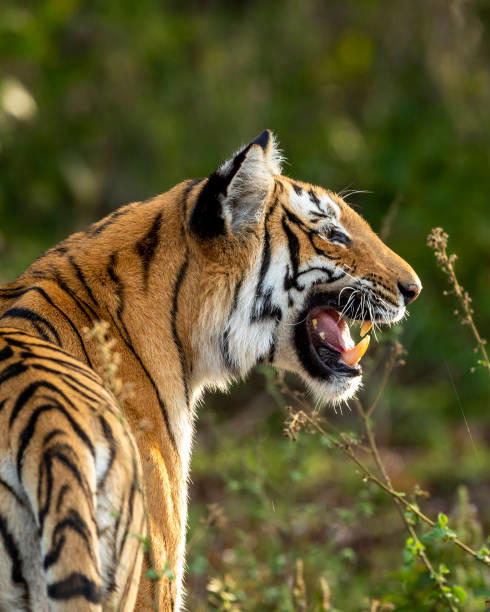

IMAGES
VIDEO
COMMENTS
Serengeti National Park is a World Heritage Site teeming with wildlife: over 2 million ungulates, 4000 lions, 1000 leopard, 550 cheetahs and some 500 bird species inhabit an area close to 15,000 square kilometers in size. Join us on a safari and explore the endless Serengeti plains dotted with trees and kopjes from which majestic lions control ...
Serengeti National Park is renowned for its wildlife, and clocking in at over 14244 sq. kilometers, there are plenty of predators in residence. From the safety of your vehicle, keep your eyes peeled for Africa's iconic Big Five: lions, elephants, rhinos, leopards and buffalo. Some animals, like the endangered black rhino, can be elusive, and ...
Compare 3,033 Serengeti safari tours offered by 293 specialized tour operators. Find the best deals using the largest marketplace for African safaris. Best price guarantee!
Top Serengeti National Park Safaris: See reviews and photos of Safaris in Serengeti National Park, Tanzania on Tripadvisor.
The pristine Serengeti National Park is nestled in the heart of northern Tanzania. Encompassing vast plains of savannah, rolling hills, and a network of rivers, the Serengeti offers sanctuary to an abundance of wildlife and incredible safari opportunities year-round.
Embark on a Serengeti National Park safari to experience breathtaking landscapes, diverse wildlife, and tailored adventures. Discover top lodges and plan your dream trip.
The Best Tanzania Safari Is With National Geographic Expeditions. The Safari Includes A Serengeti Safari, Hot-Air Balloon Ride Over The Savanna.
Ultimate Serengeti Safari Guide: Plan your dream Tanzania adventure with ideal trip duration, attractions, safari options & more!
Everything you need to know about a Serengeti Safari and the Serengeti National Park. From where to stay & a guide to the Serengeti Wildebeest Migration from the award-winning Tanzania experts.
Going on a 4-day Serengeti National Park safari is one of the best experiences you can have in Africa. It's a chance to explore one of the best safari parks anywhere on the continent, with its endless savannah grasslands, flat-topped acacia trees and extraordinary wildlife.
Your visit to Tanzania isnt complete without visiting Serengeti National Park. Find everything you need to know for a Serengeti Safari in Tanzania including affordable Tanzania Safari Packages, Serengeti Park Fees, and more.
Discover the Serengeti National Park in Tanzania, including its history, wildlife, top activities, best time to visit, and accommodation options.
Renowned as a luxury safari destination, the Serengeti National Park in Tanzania offers prime game viewing with the incredible Great Migration of millions of wildebeest, stunning scenery and beautiful beaches, reflected in the excellent safari experience visitors have come to expect.
The Serengeti National Park in Tanzania is one of the most famous wildlife habitats in the world. This large park in Northern Tanzania, along with its sister park (the Masai Mara) in Kenya, plays a pivotal role in the great wildebeest migration. This great migration, which also features zebra, gazelle, and other grazing animals, brings over two ...
All Serengeti lodges & camps A myriad of accommodation options is available in Serengeti National Park. From adventurous mobile tented camps following the Great Migration to family-oriented lodge style accommodations and anything in between, you can be sure to find the perfect spot just for you.
Serengeti Serena Safari Lodge Medical Staff Jul 29, 2024; Malaria Pills Jul 28, 2024; See All Serengeti National Park Conversations. ... Top questions about Serengeti National Park. Top Safari Destinations; Serengeti National Park Destination Experts. Brian_in_Brooklyn. 2,481 forum posts.
2. Serengeti National Park, Tanzania. Adjacent to the Maasai Mara National Reserve lies the Serengeti National Park in Tanzania - another remarkable safari destination.
safariwithcharlie on August 31, 2024: "Mother and cub, Serengeti National Park @safariwithcharlie Serengeti National Park, Tanzania With thanks to my guide @neyleenature . . #cheetah #cheetahs #safari #wildlife #wildlifeplanet #wildlifeaddicts #wildlifelovers #wildlifereels #animals #wildanimals #wildnature #wildlifeofinstagram #nature #cats #bigcats #catreels #africansafari #africananimals".
Top Serengeti National Park Tours: See reviews and photos of tours in Serengeti National Park, Tanzania on Tripadvisor.
Top Novosibirsk Parks & Nature Attractions: See reviews and photos of parks, gardens & other nature attractions in Novosibirsk, Russia on Tripadvisor.
Safari, Novosibirsk: See unbiased reviews of Safari, rated 4.0 of 5 on Tripadvisor and ranked #872 of 1,110 restaurants in Novosibirsk.
Wonder Park Galileo. The pavilion of more than 1000 m2: interactive exhibits, optical illusions, amazing musical instruments, the mysterious mirror, the room with the broken gravity, intricate mazes, unexpected photo zone and much more. You'll feel a dwarf and a giant, learn to play the water pipes, play on the strings of invisible harps ...
Enjoy your trip with Russian speaking Guide and Professional Driver! My name is Lapin Vitaly. I'm a guide and professional driver offering personal services here in Novosibirsk for different types of travelers.